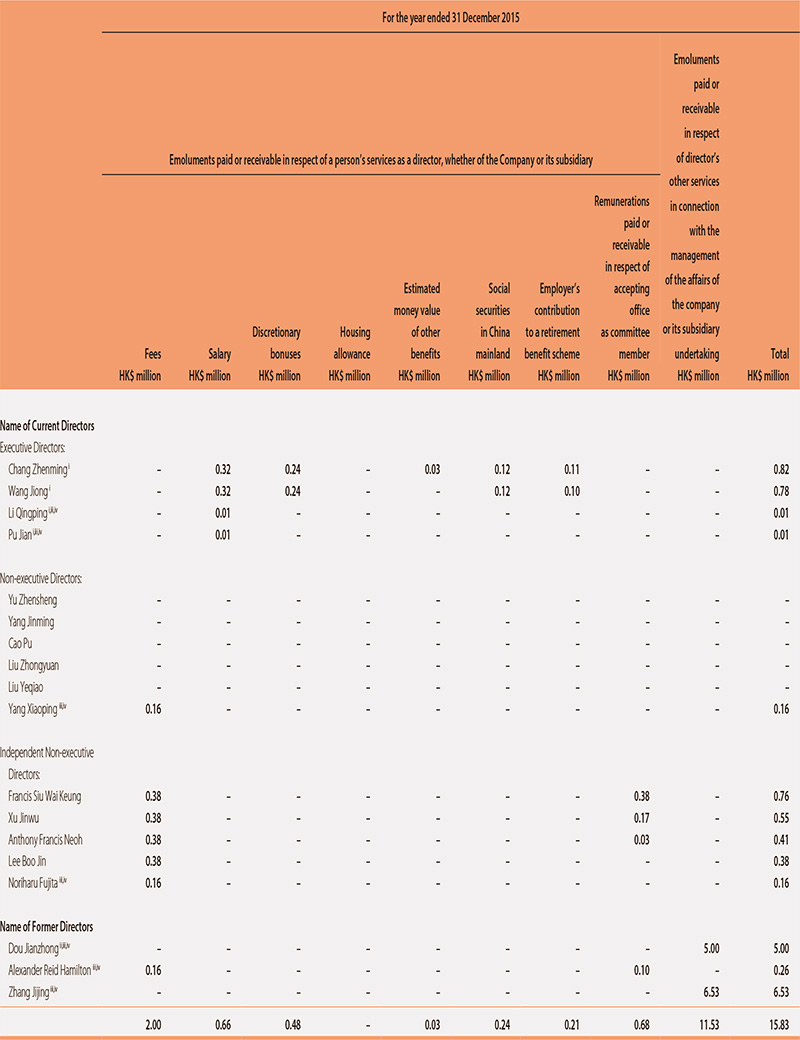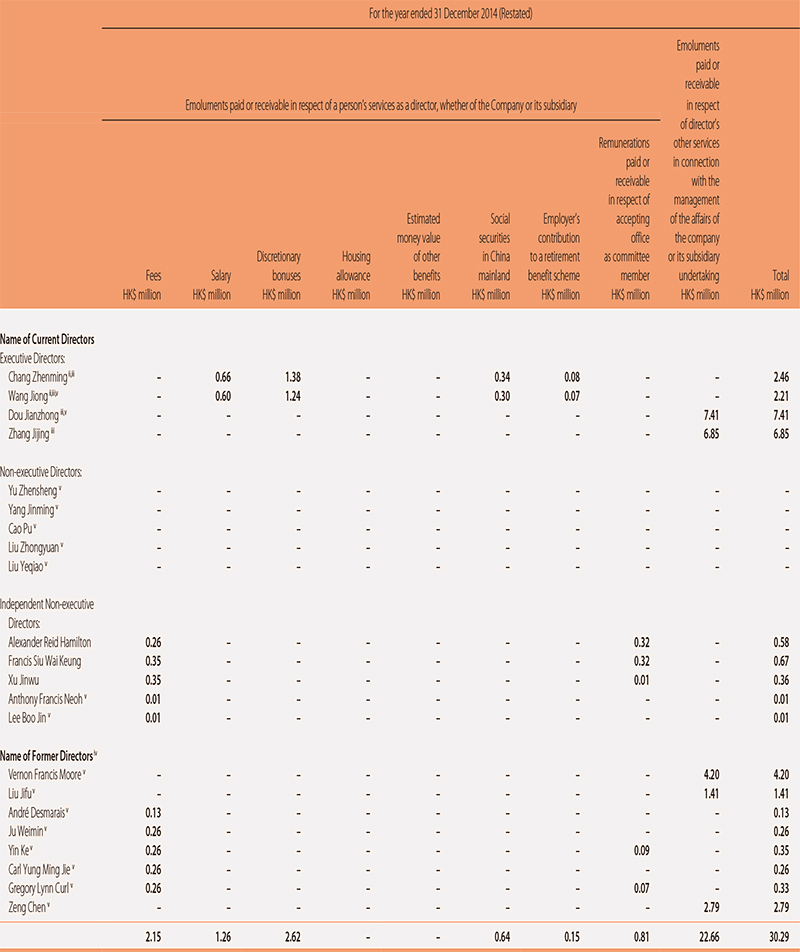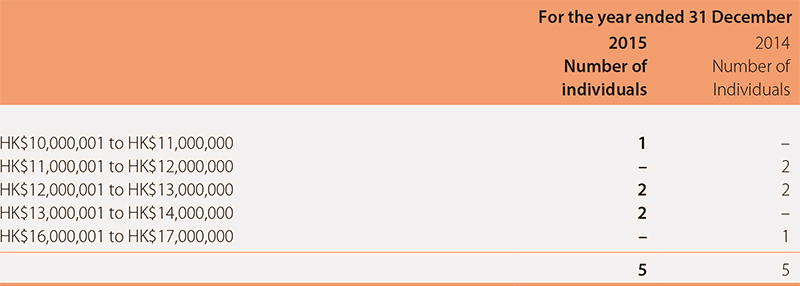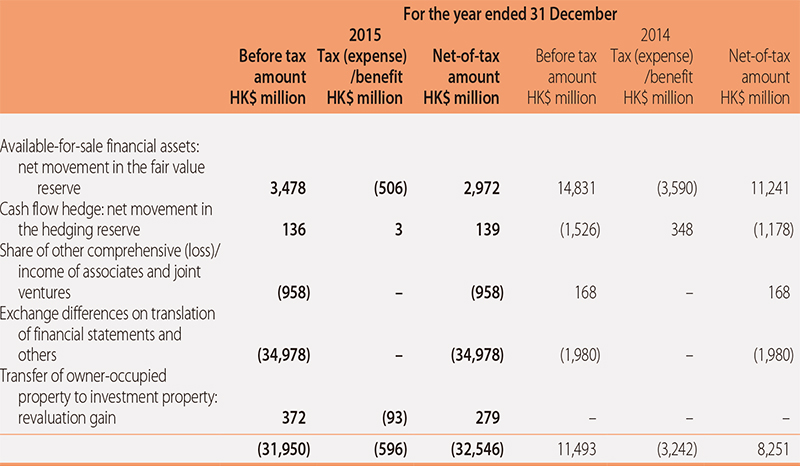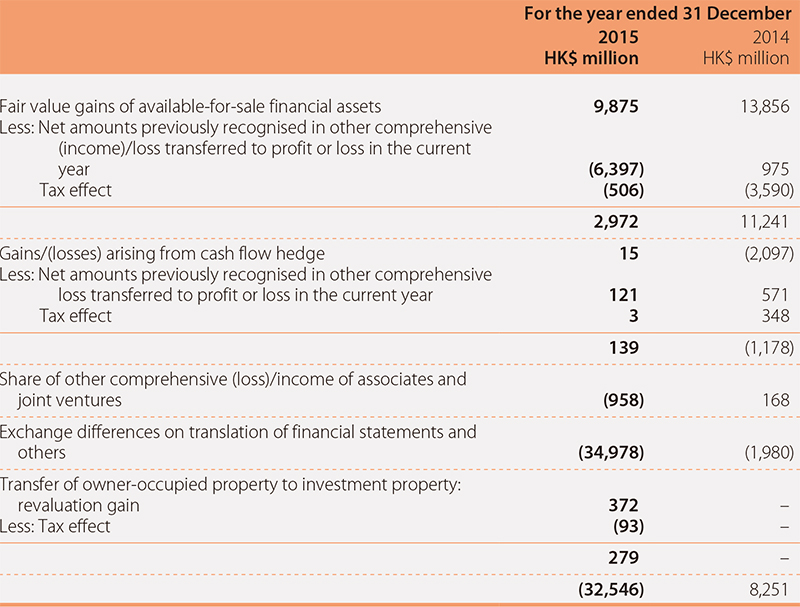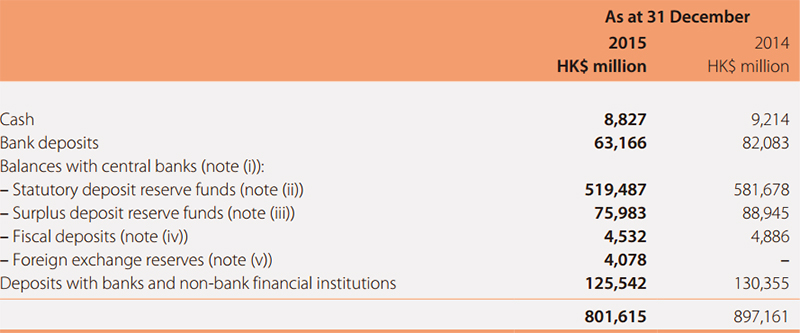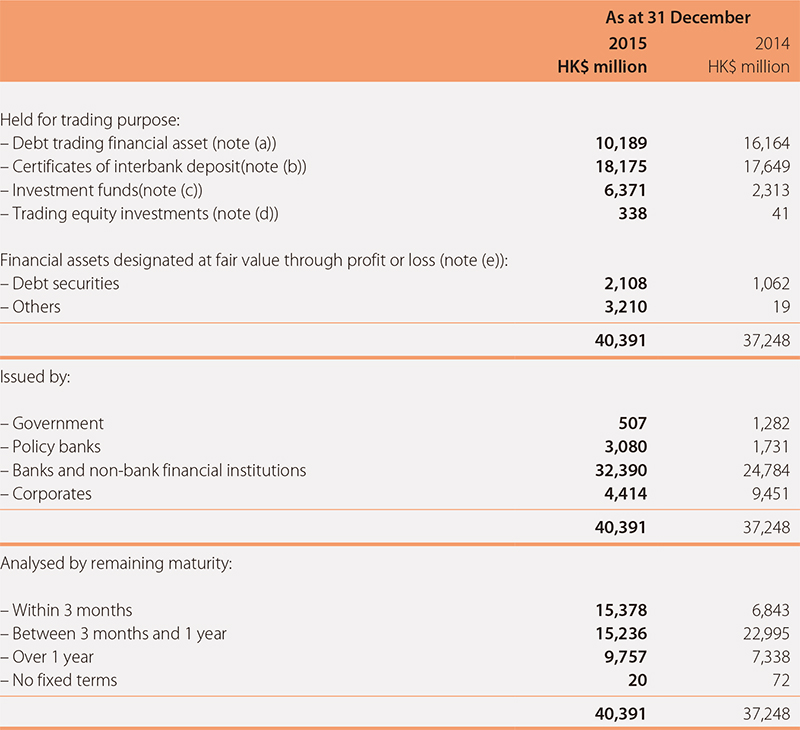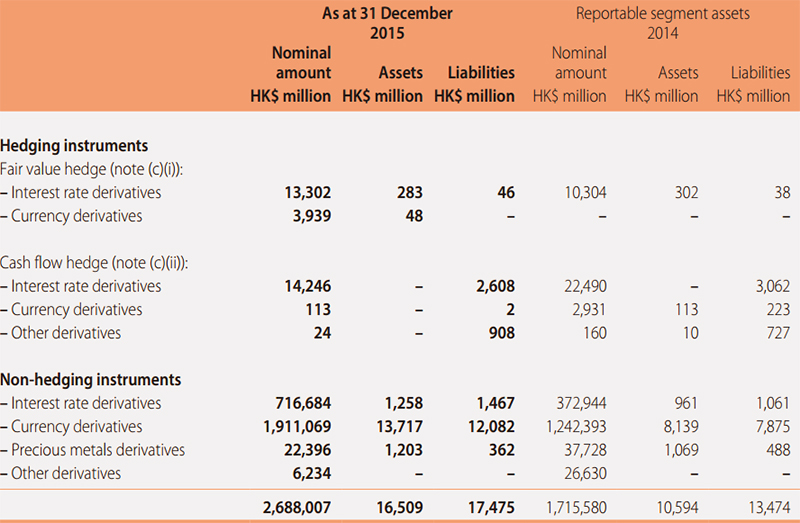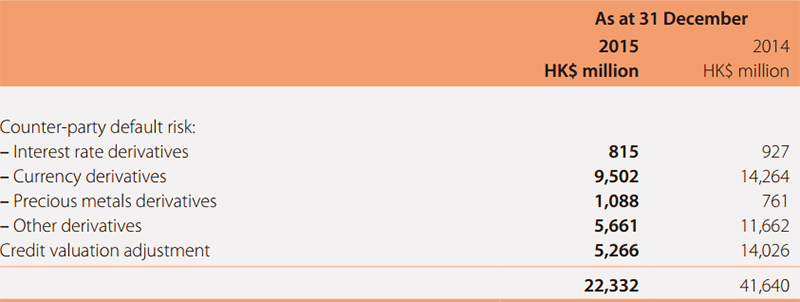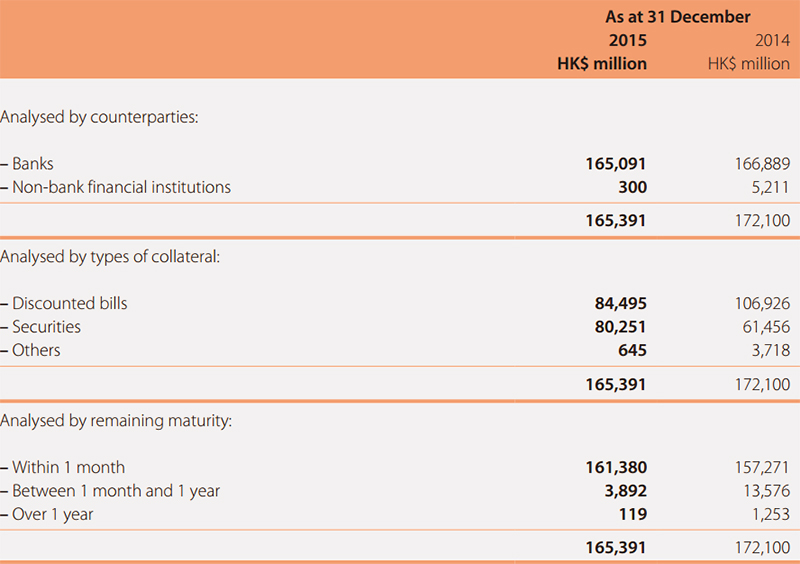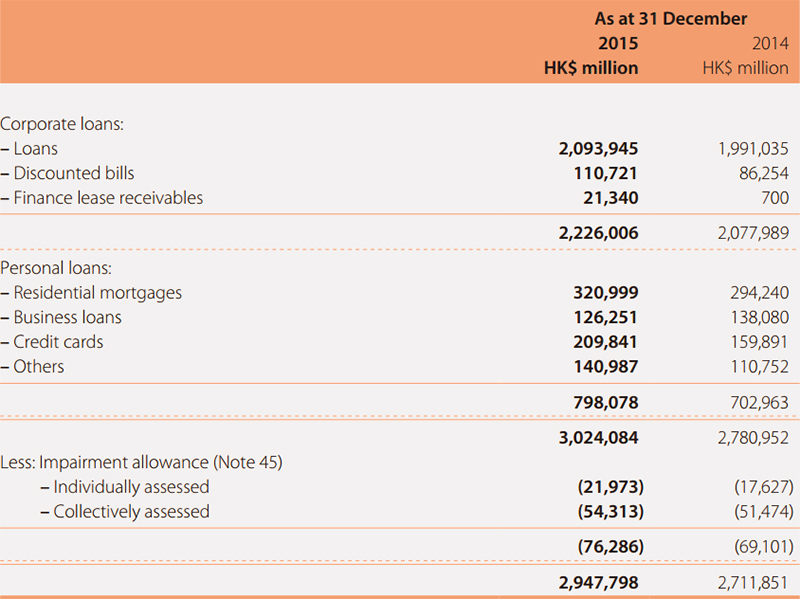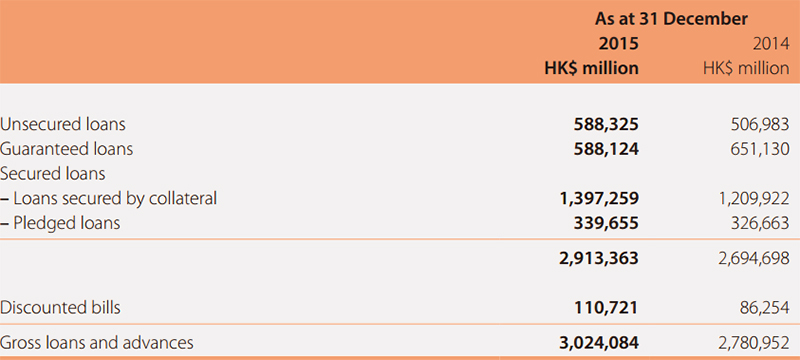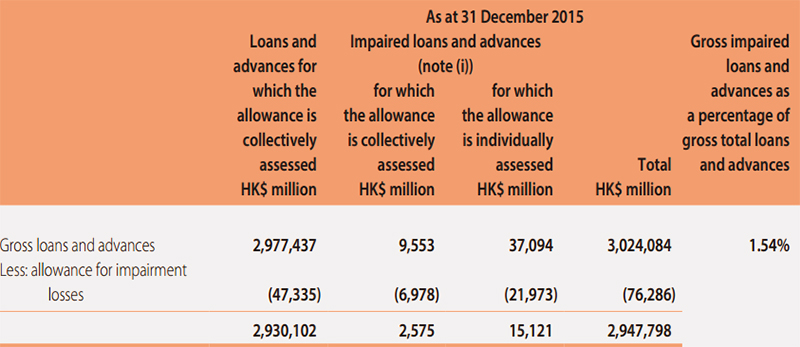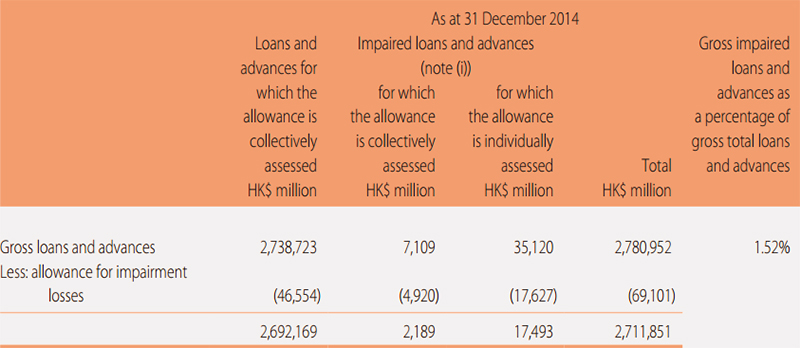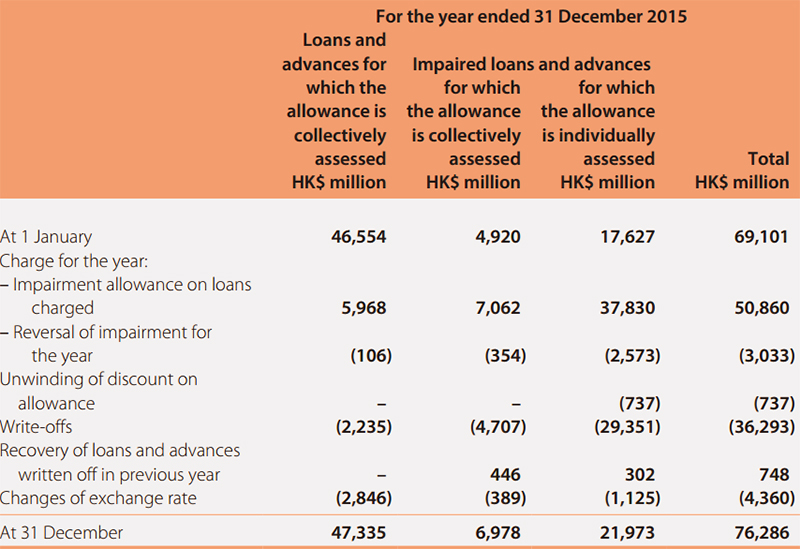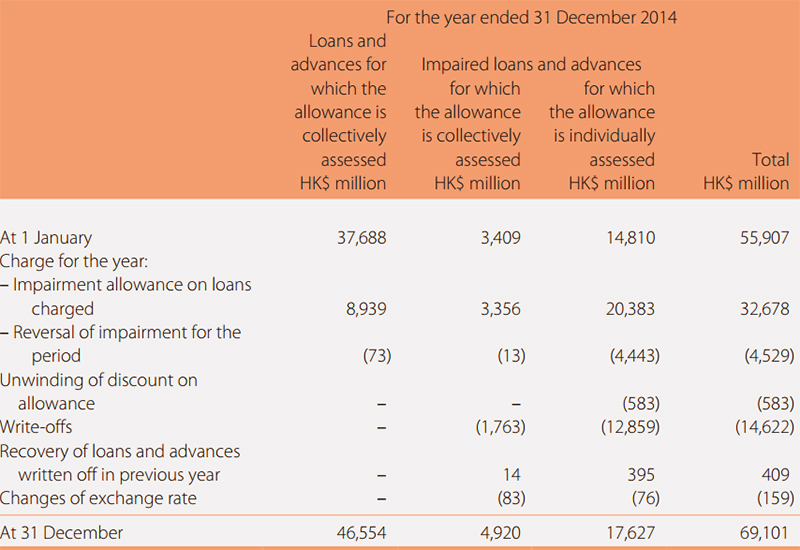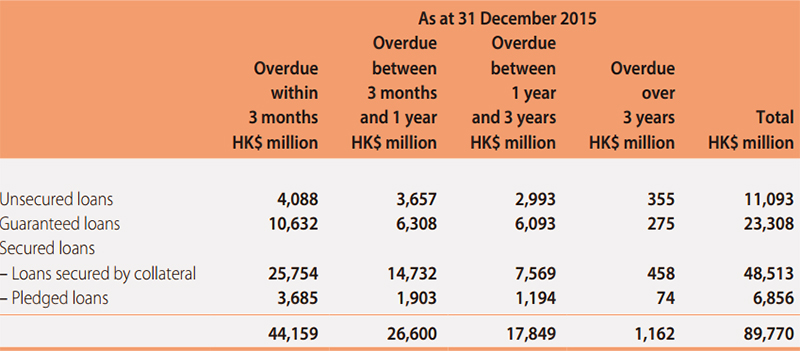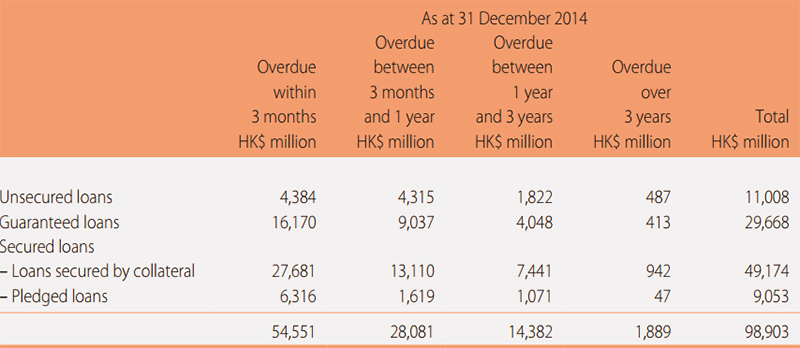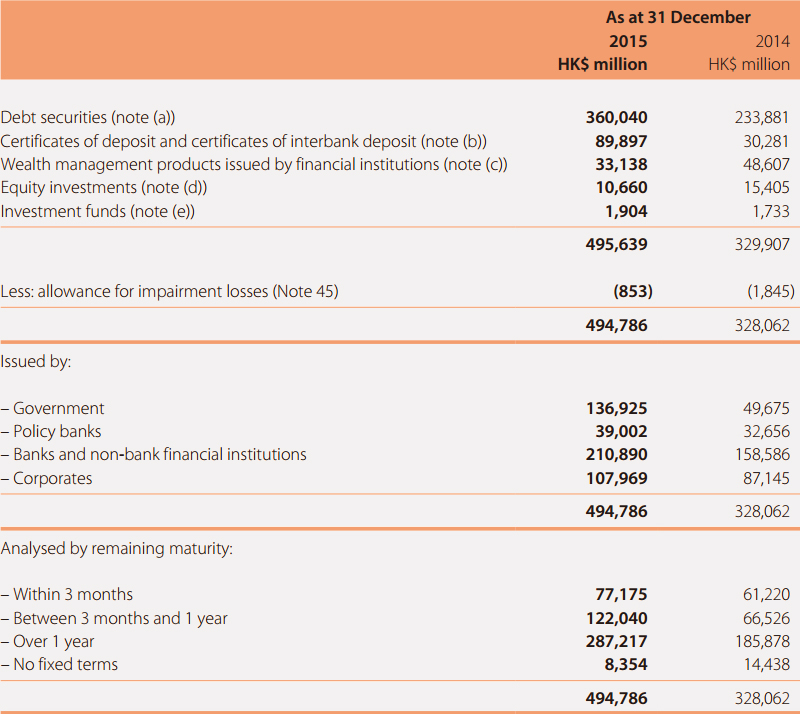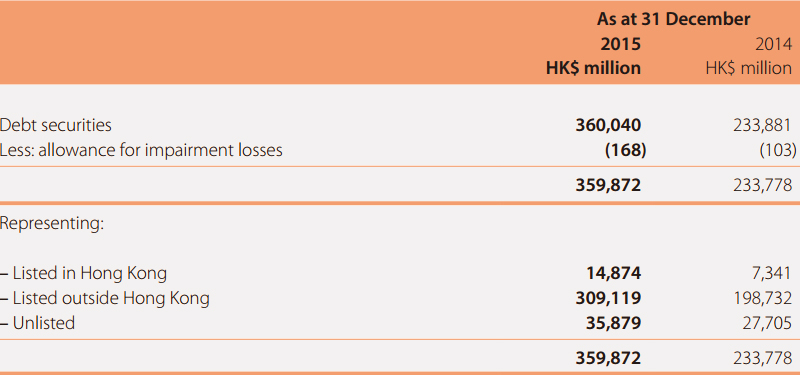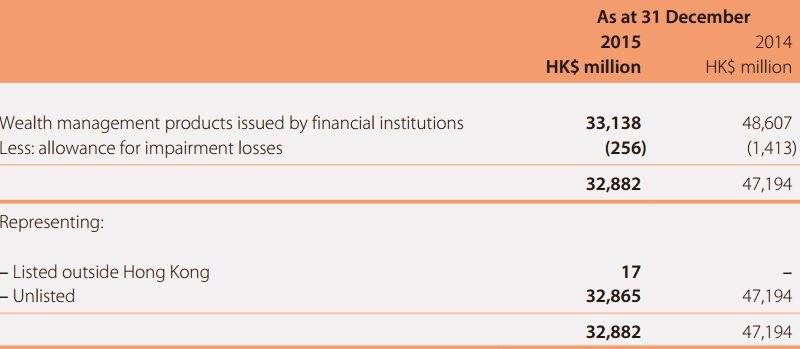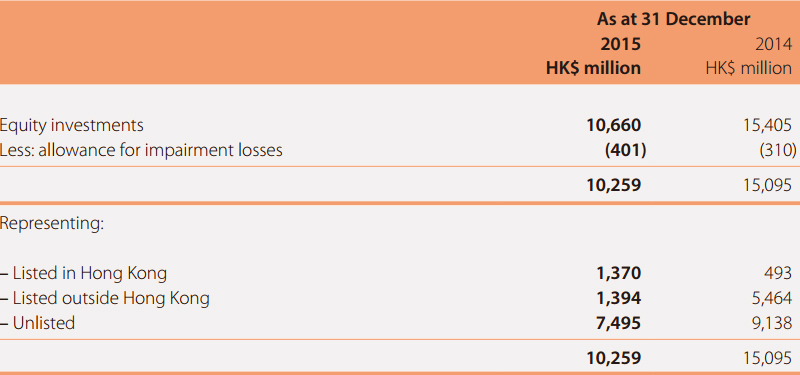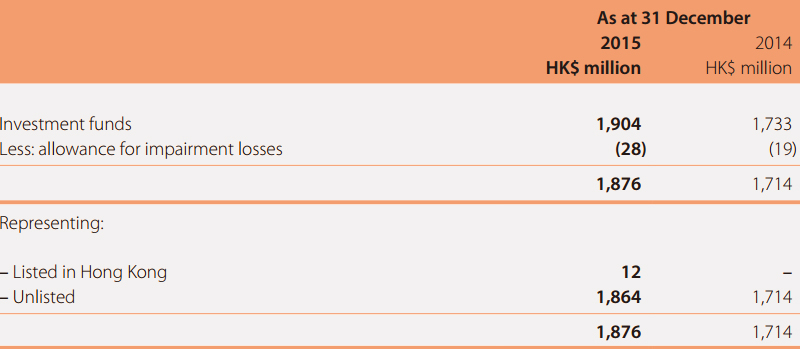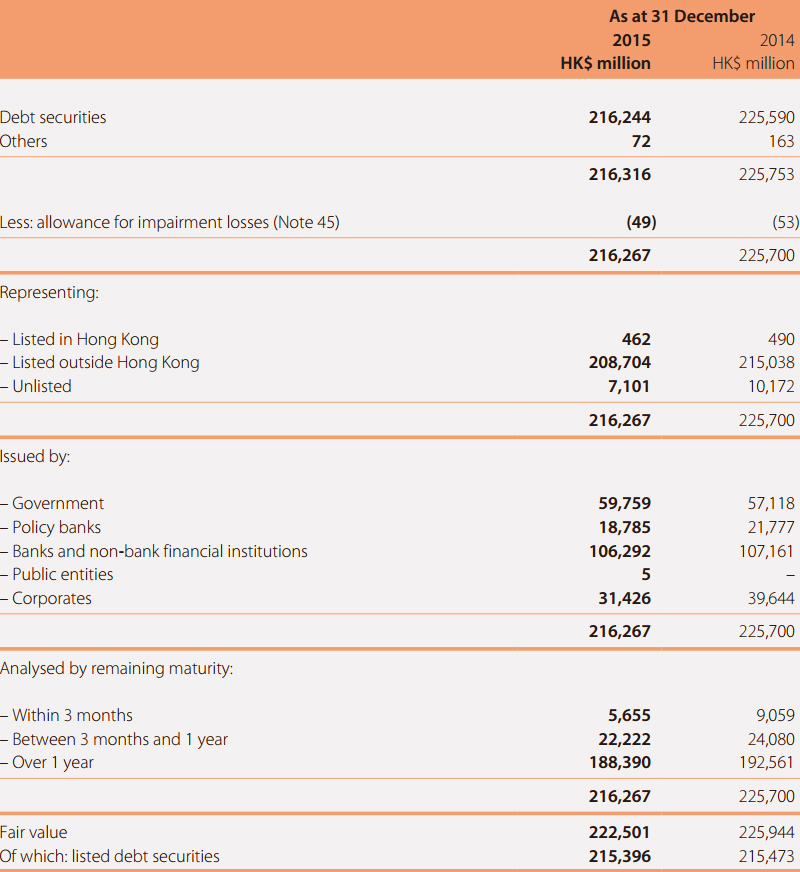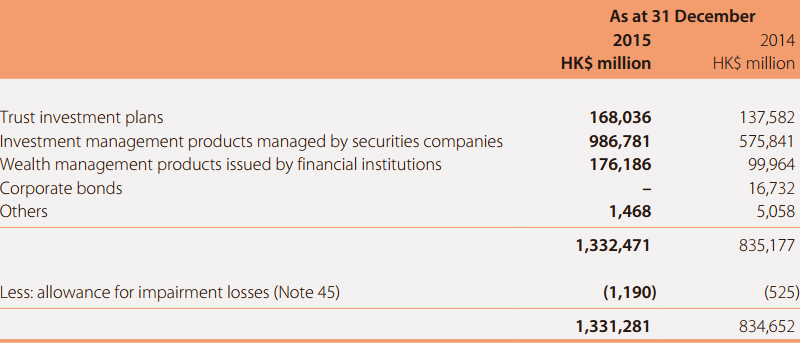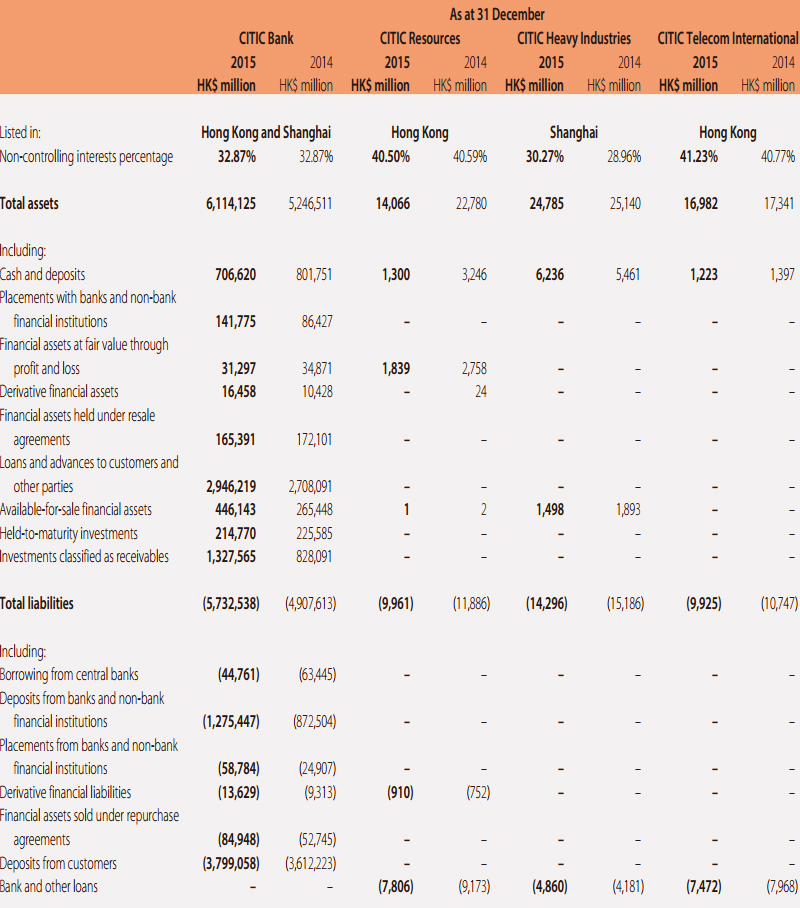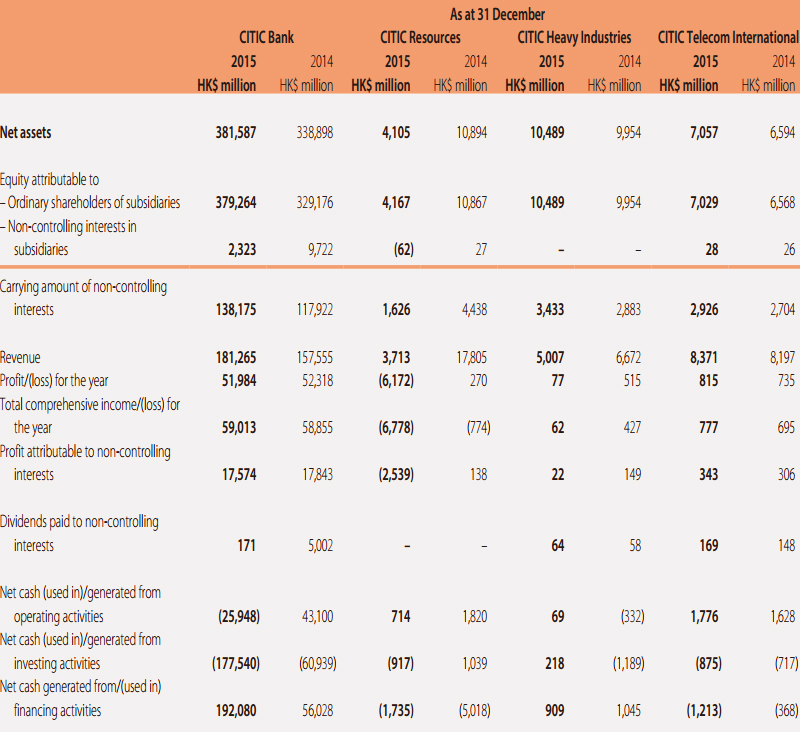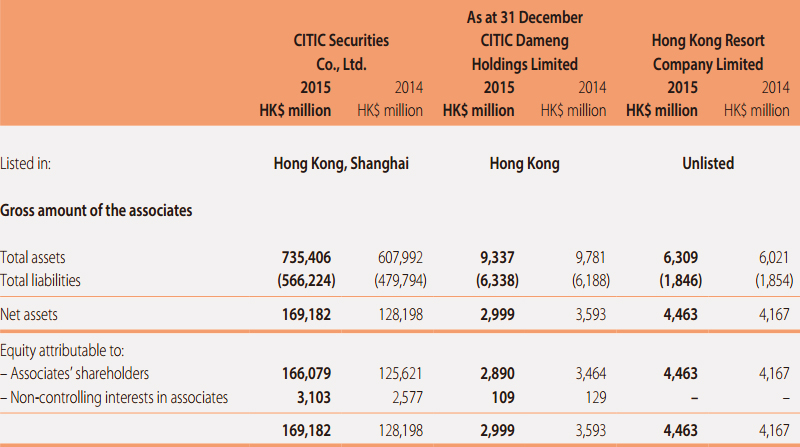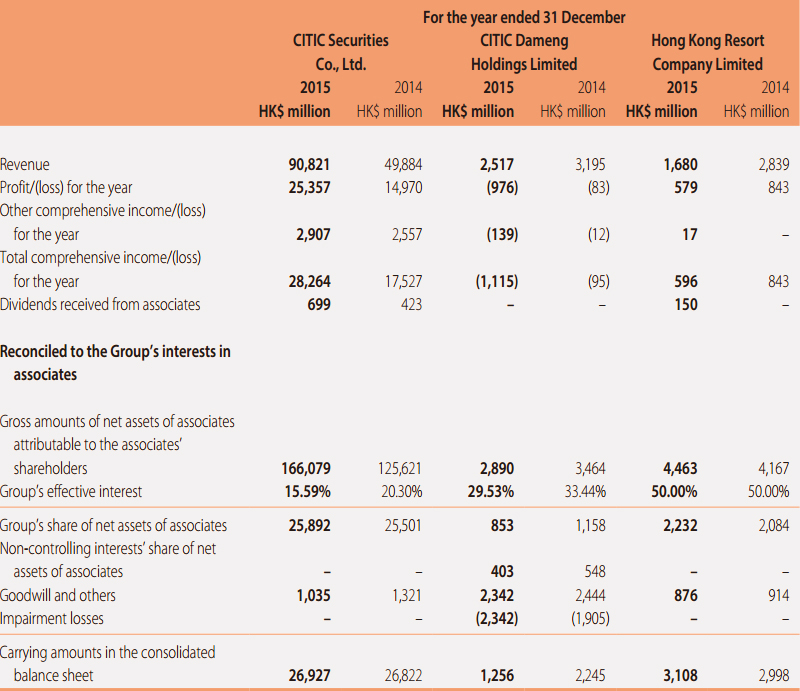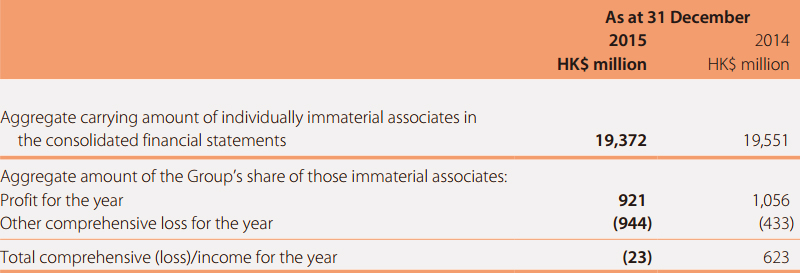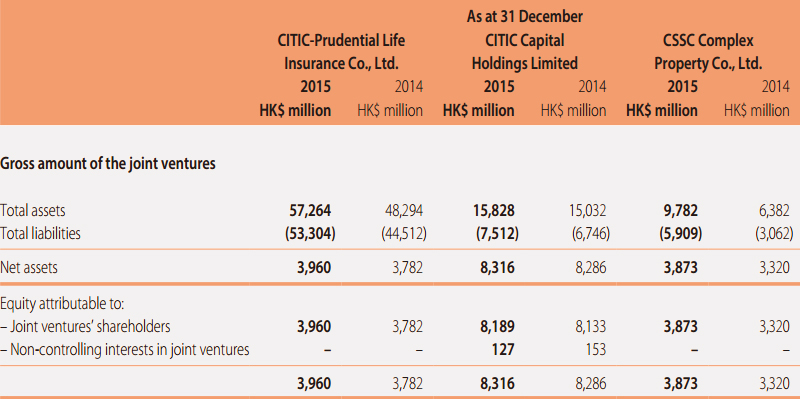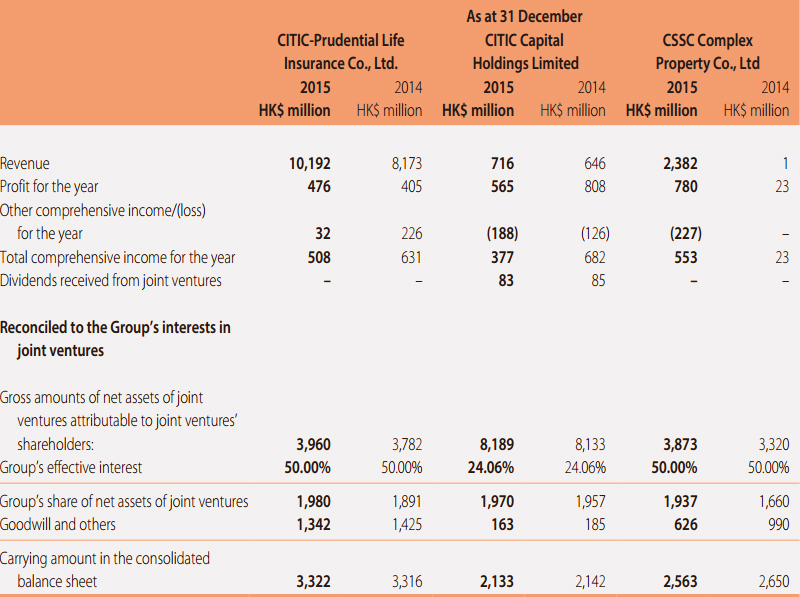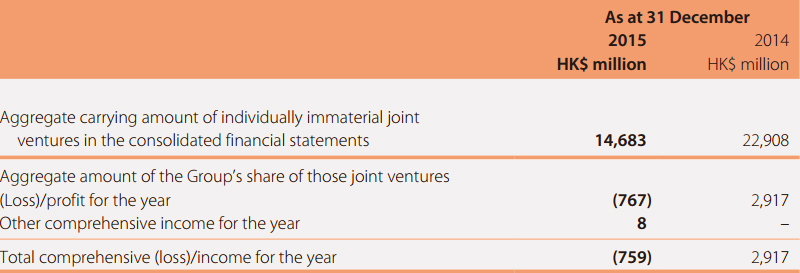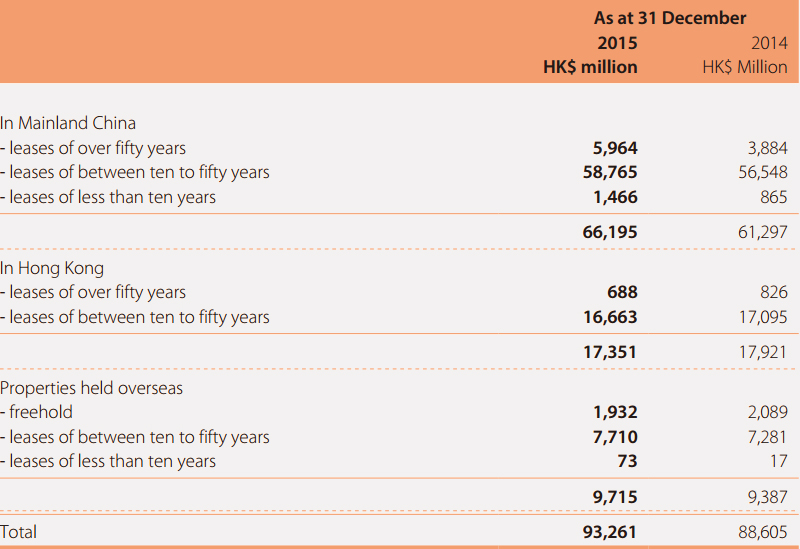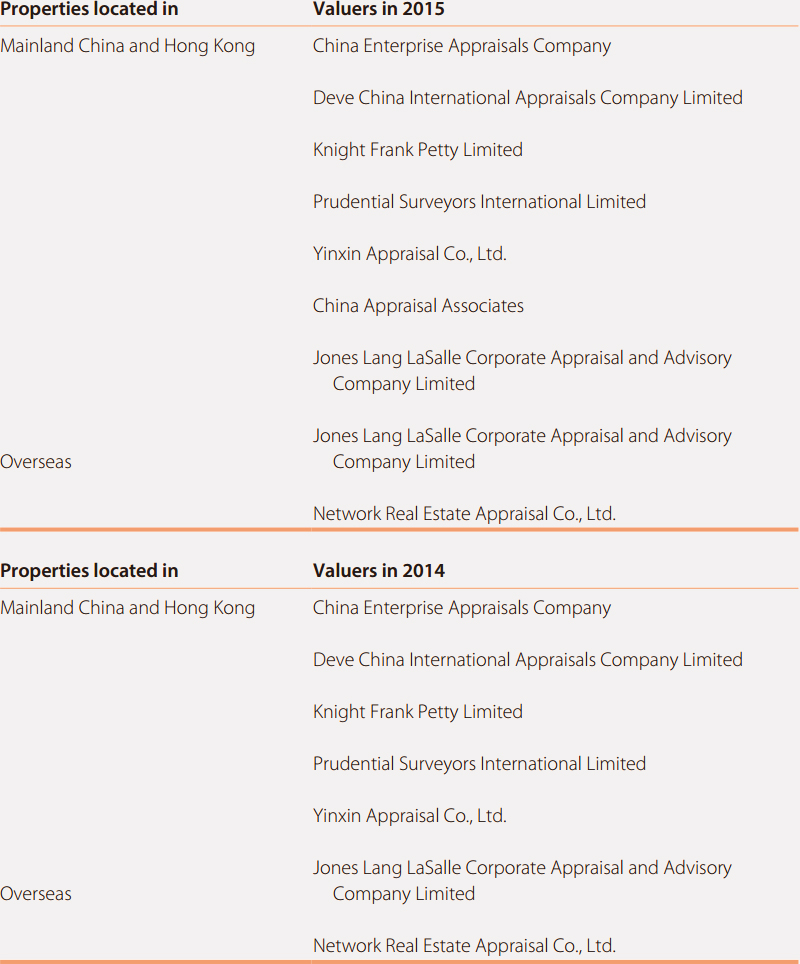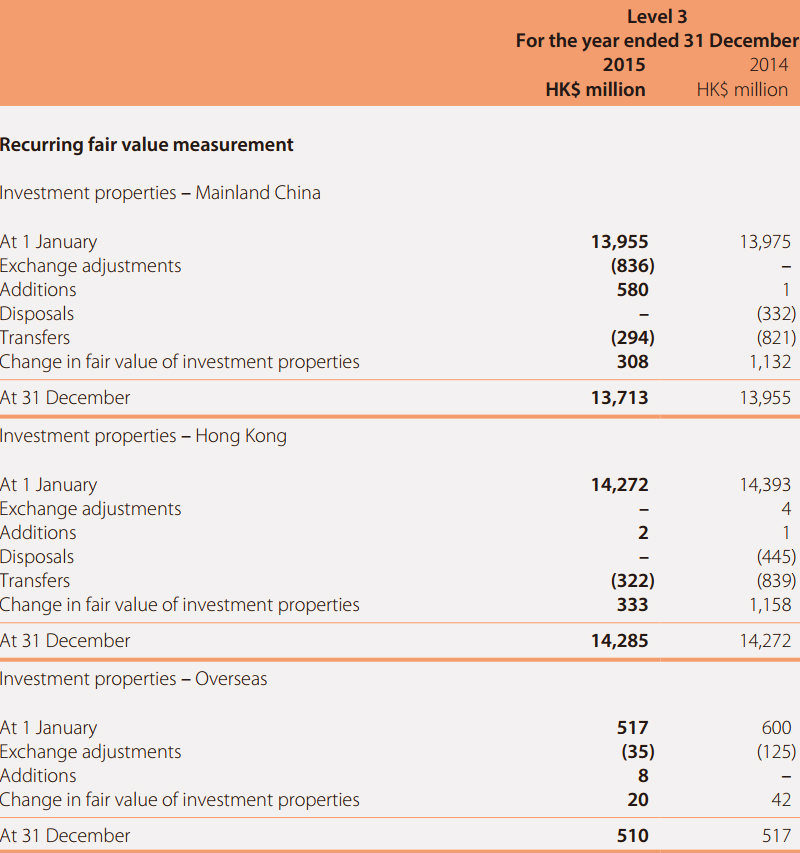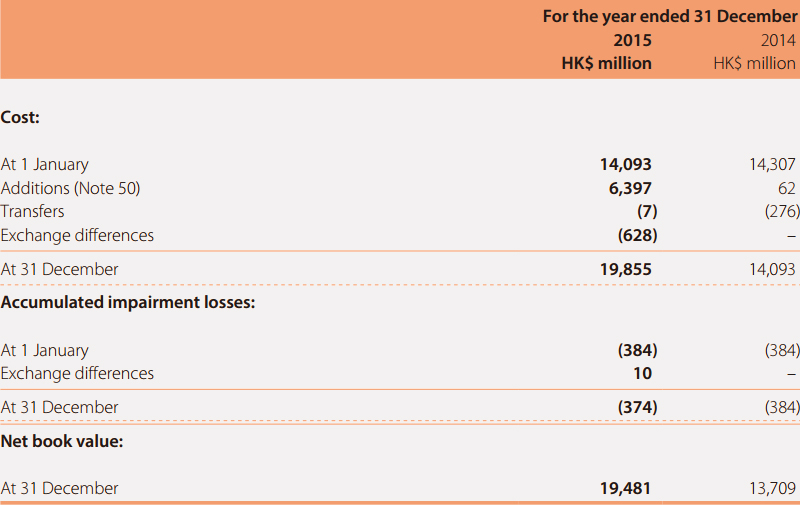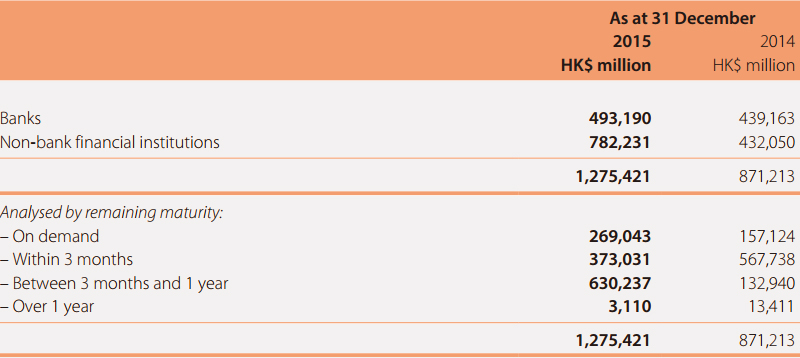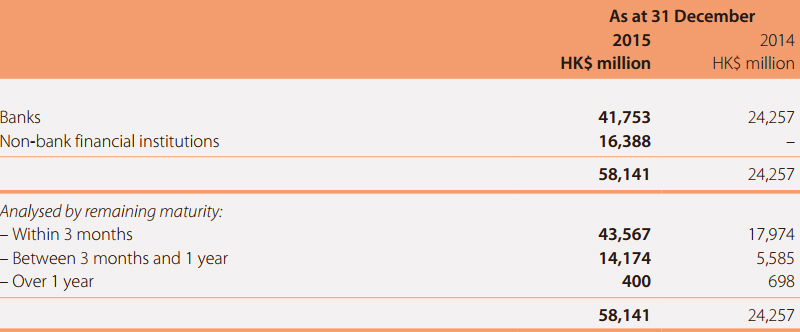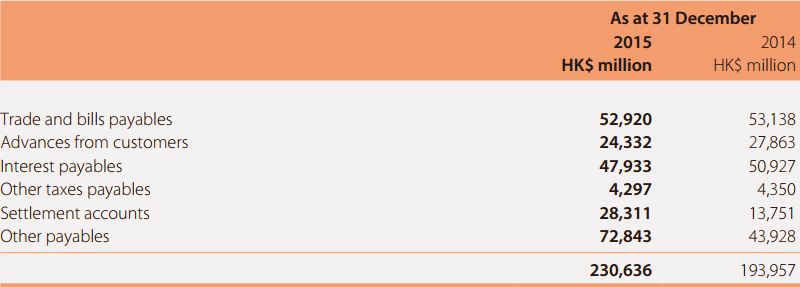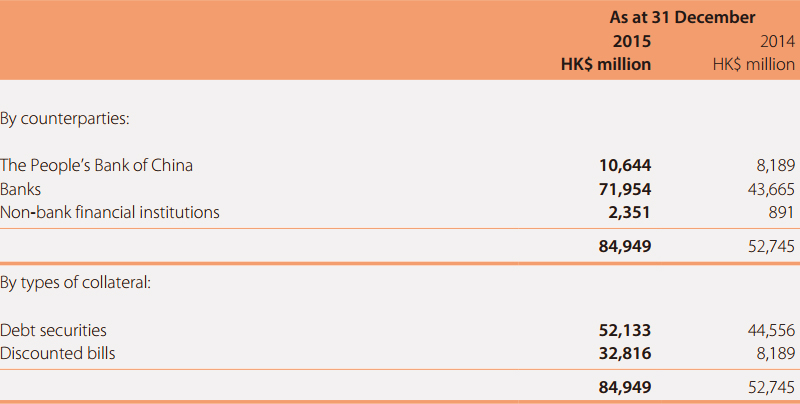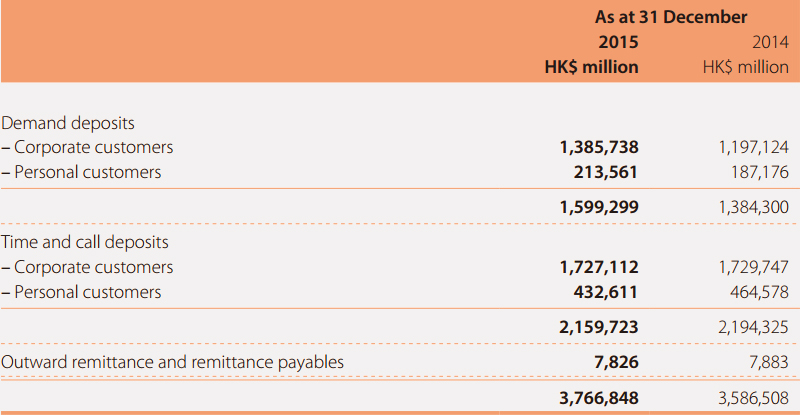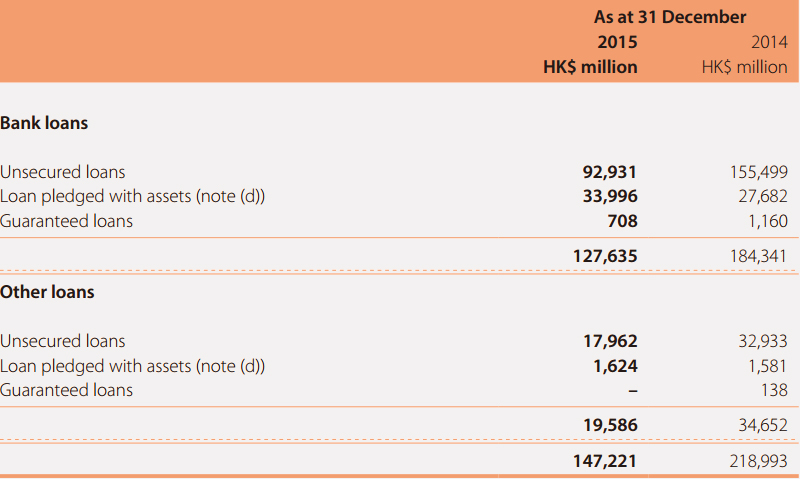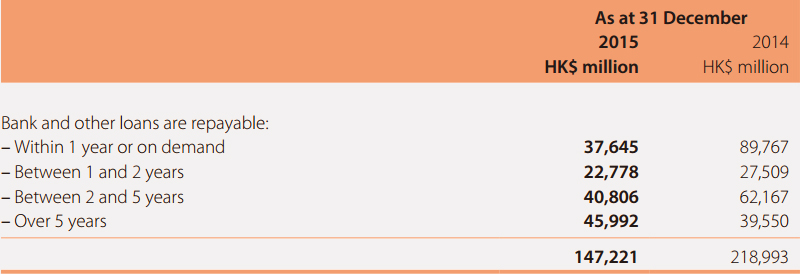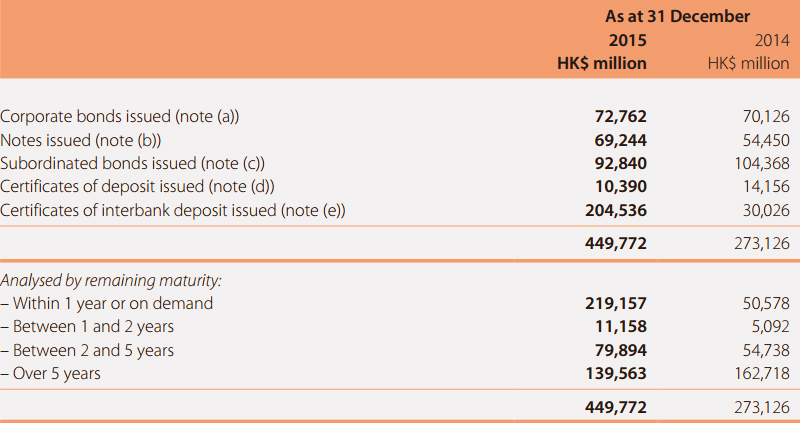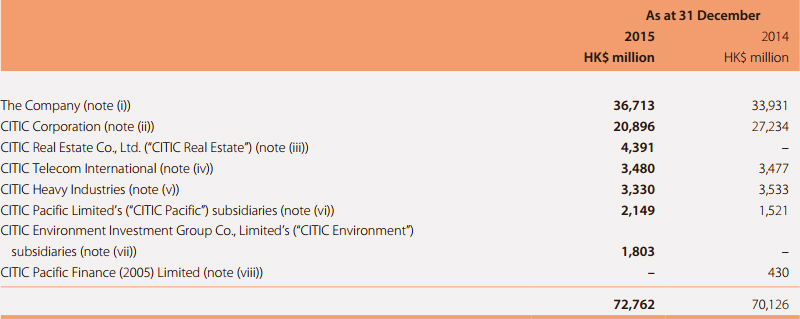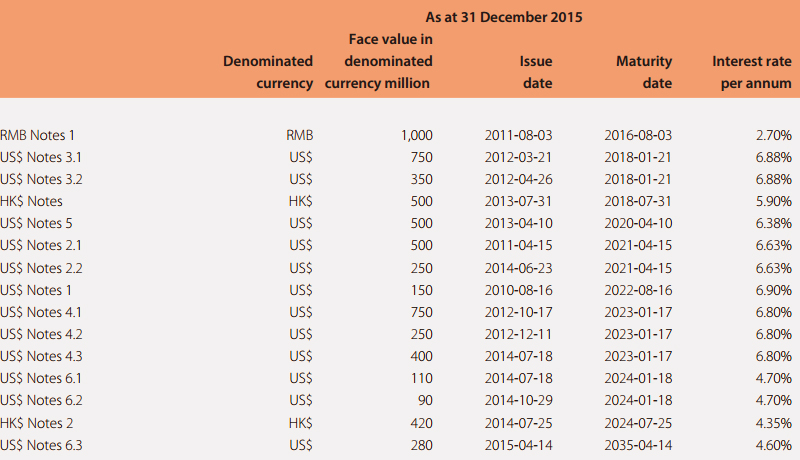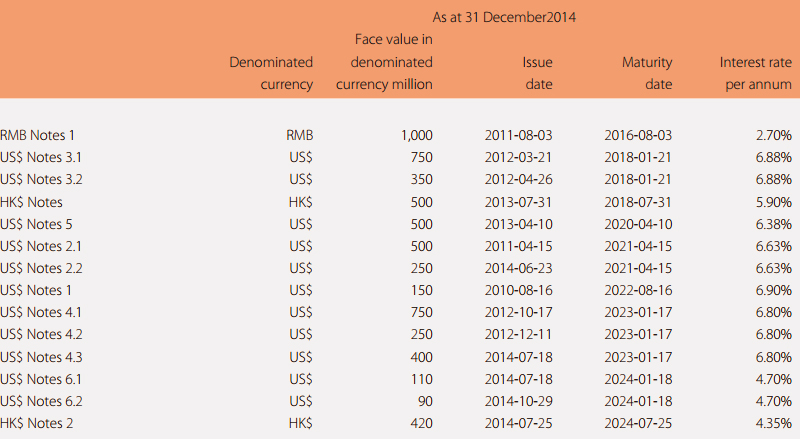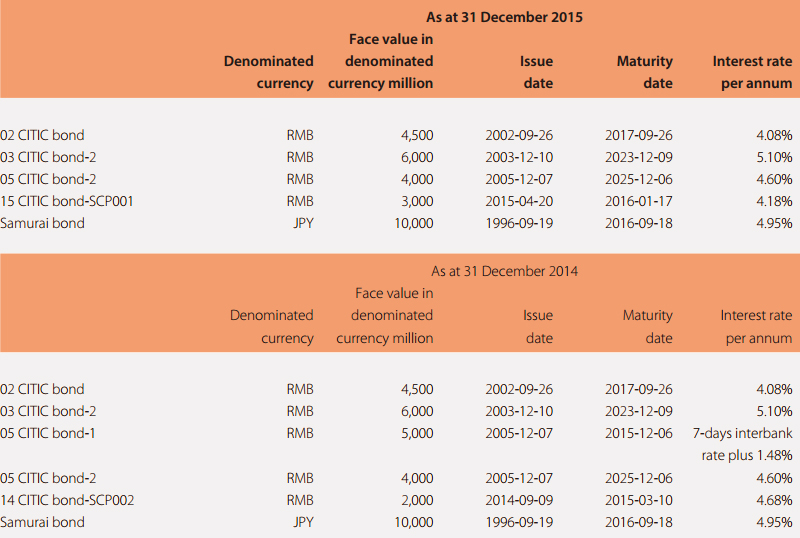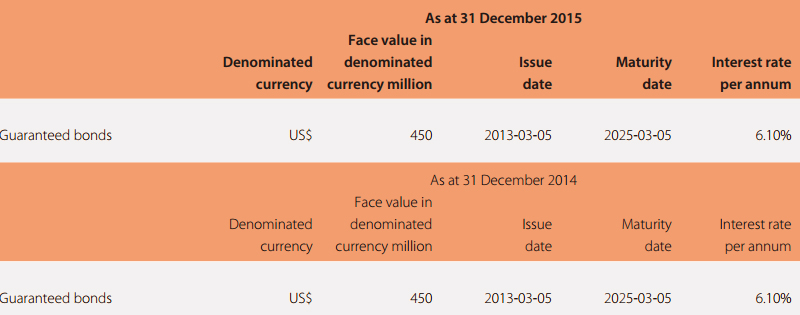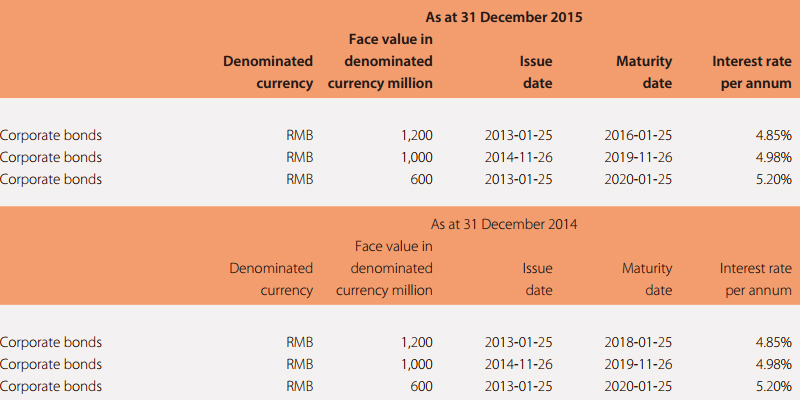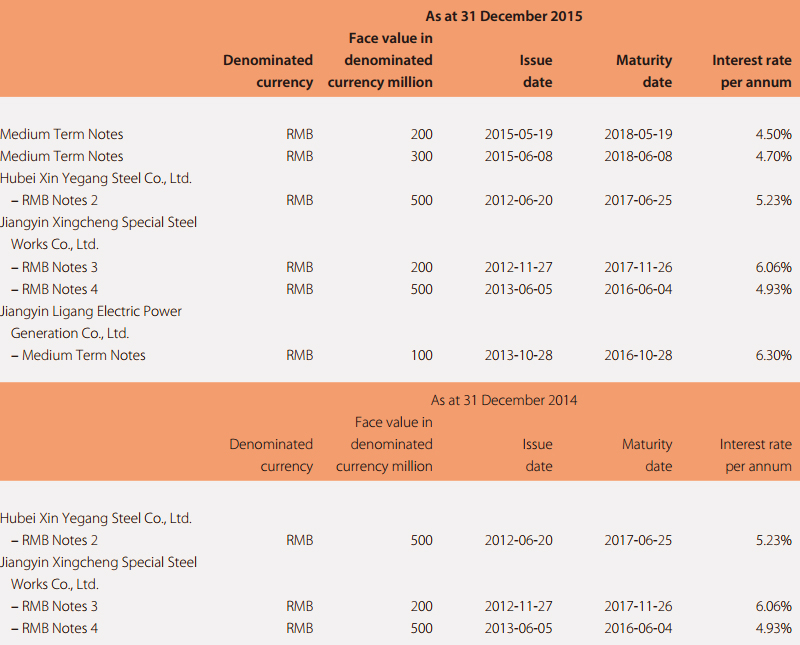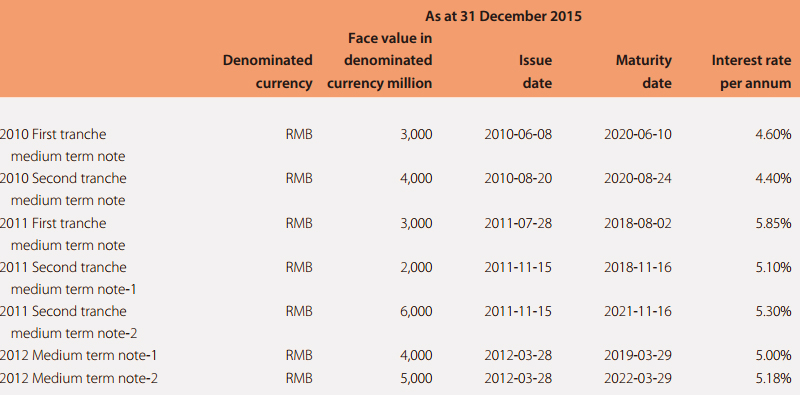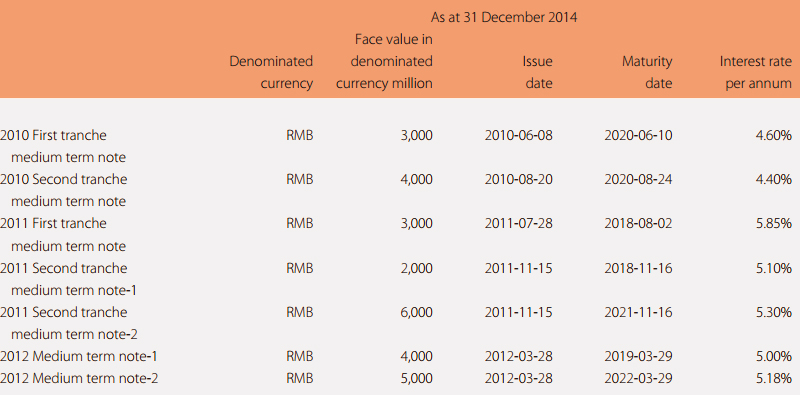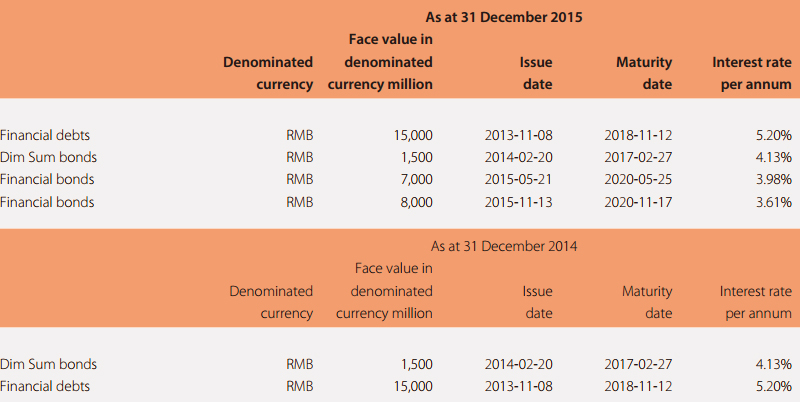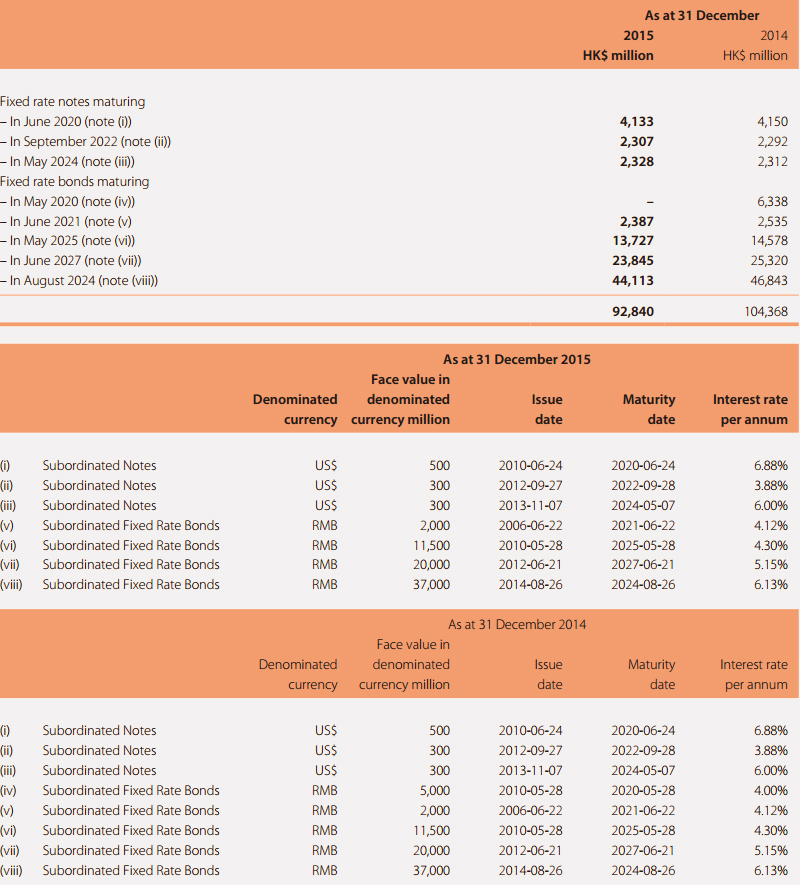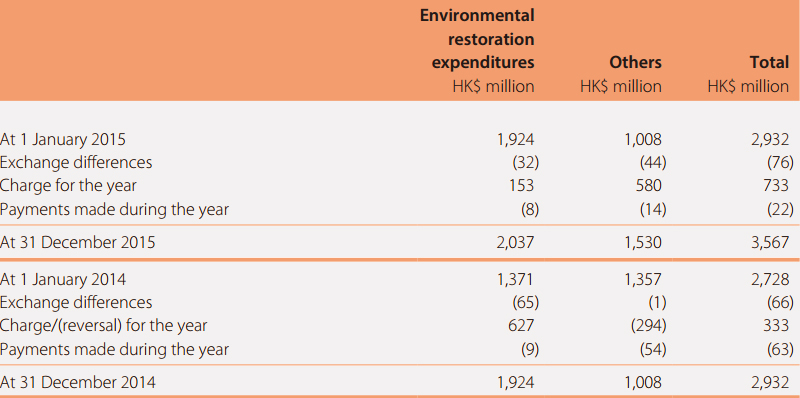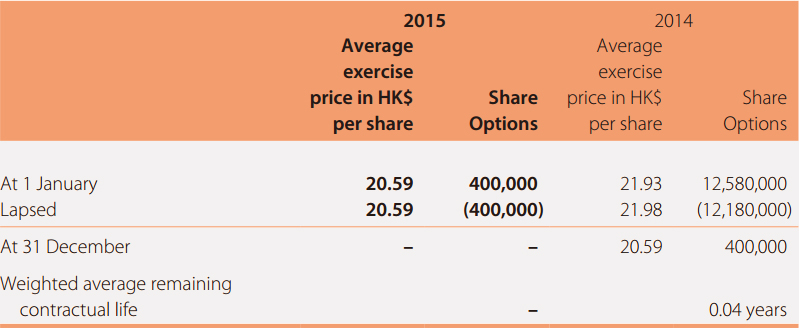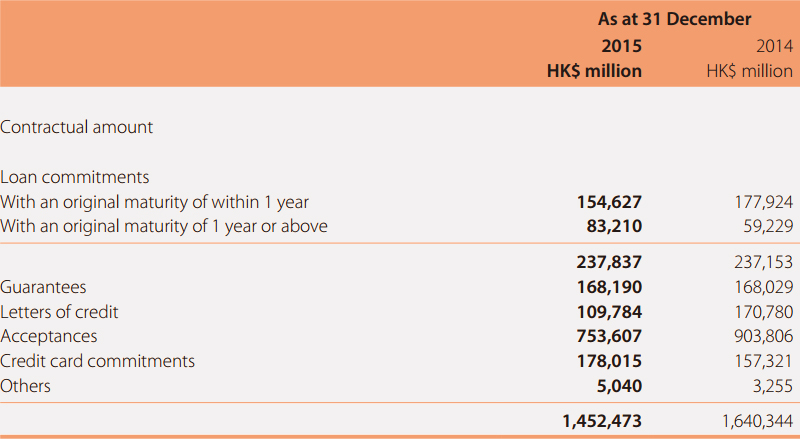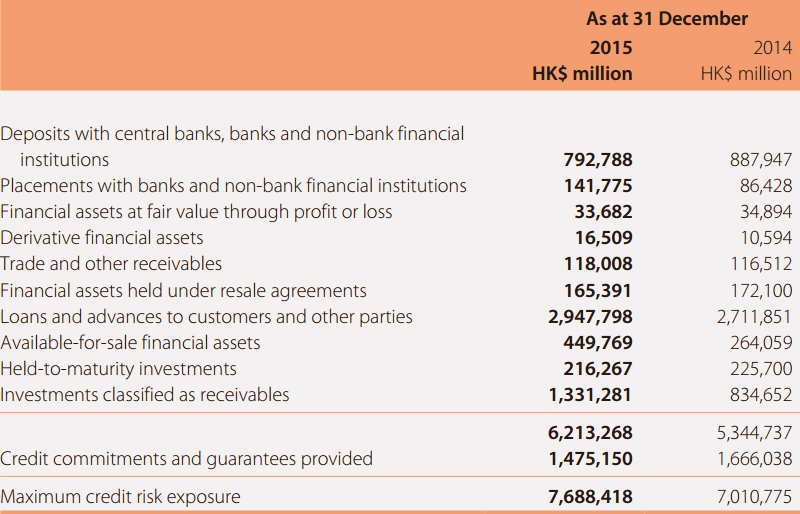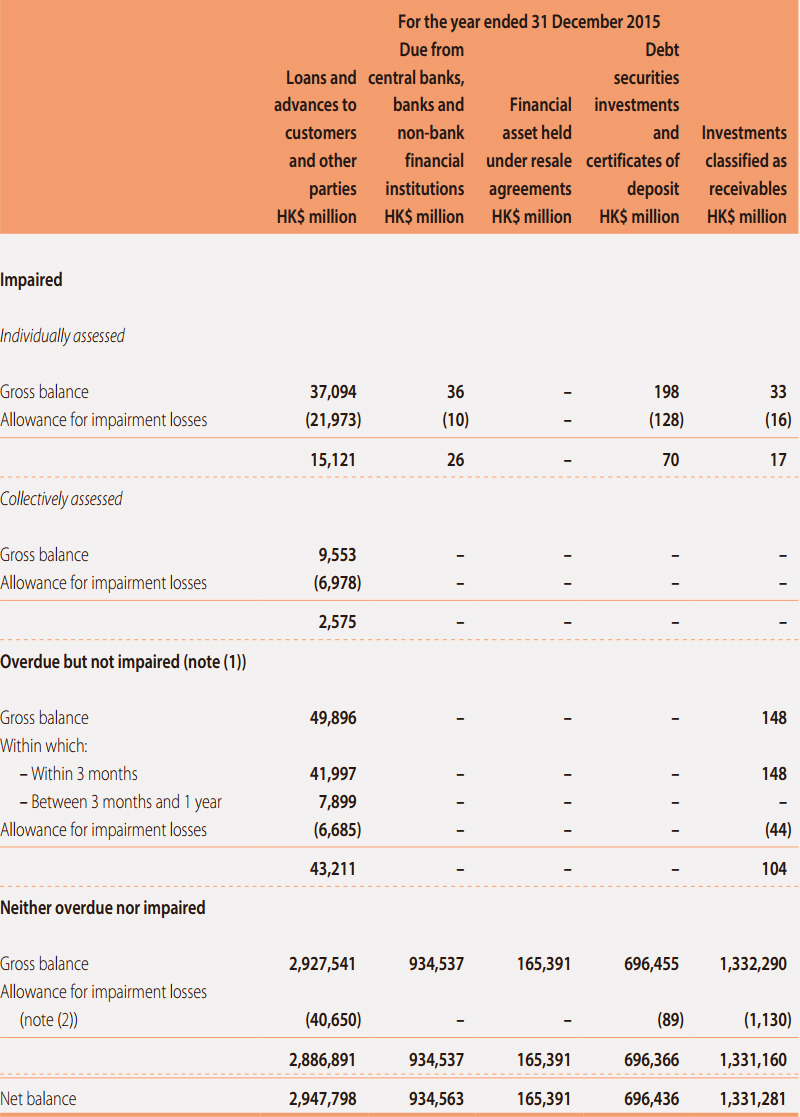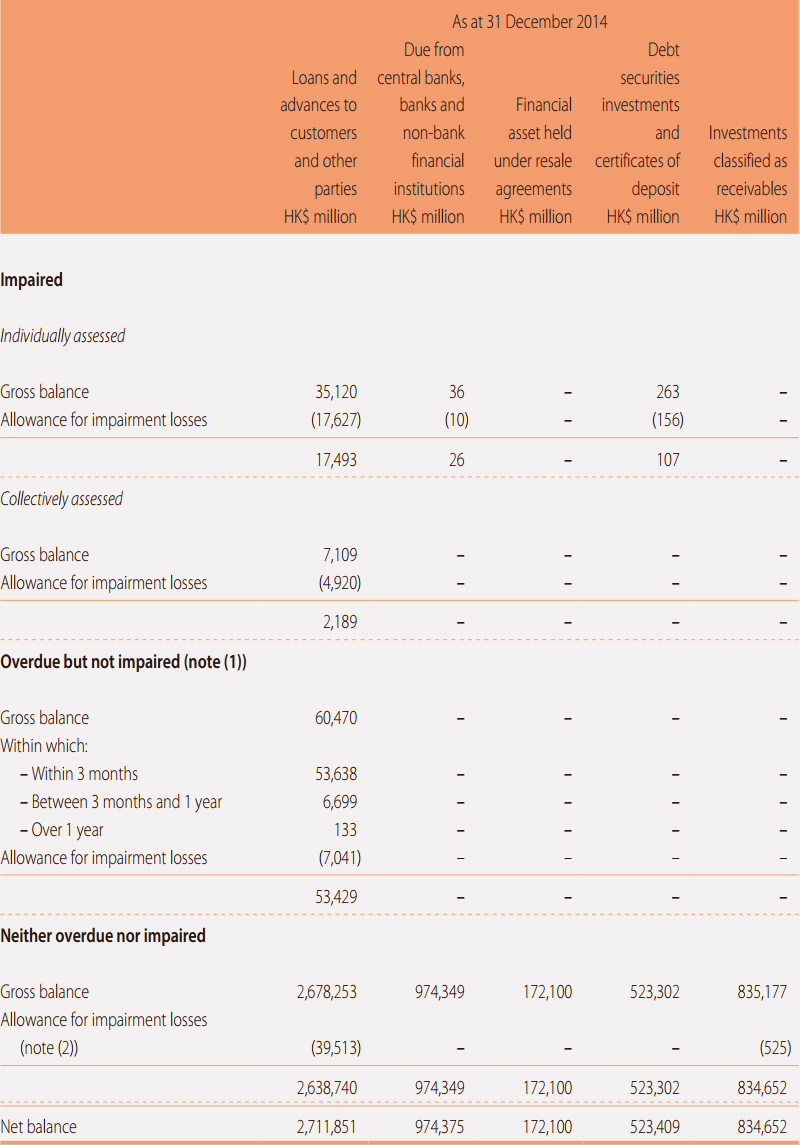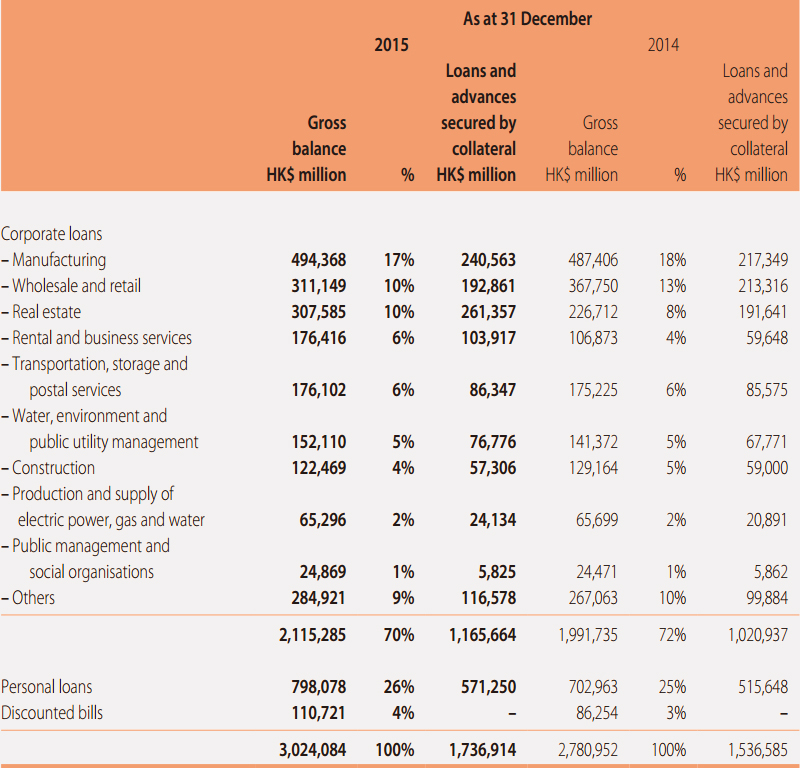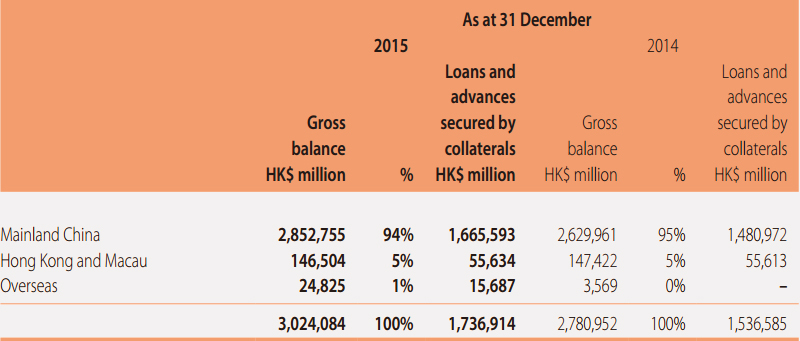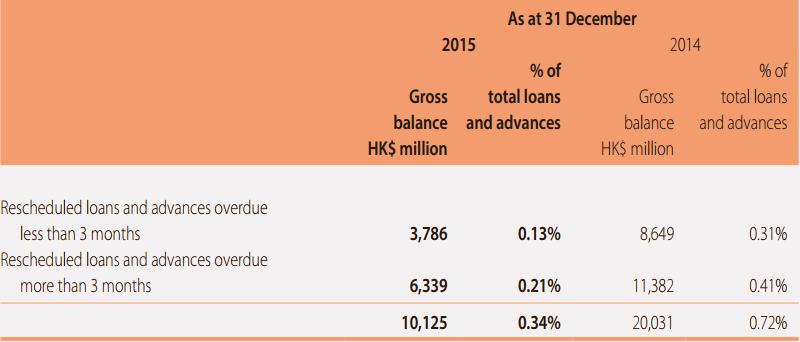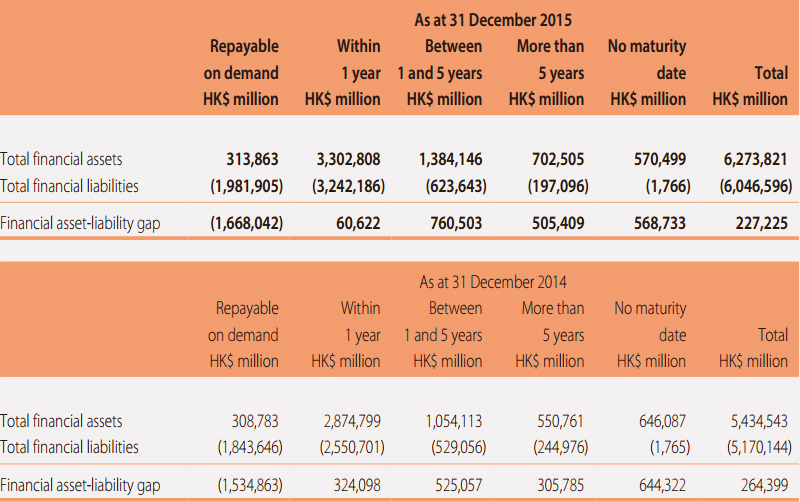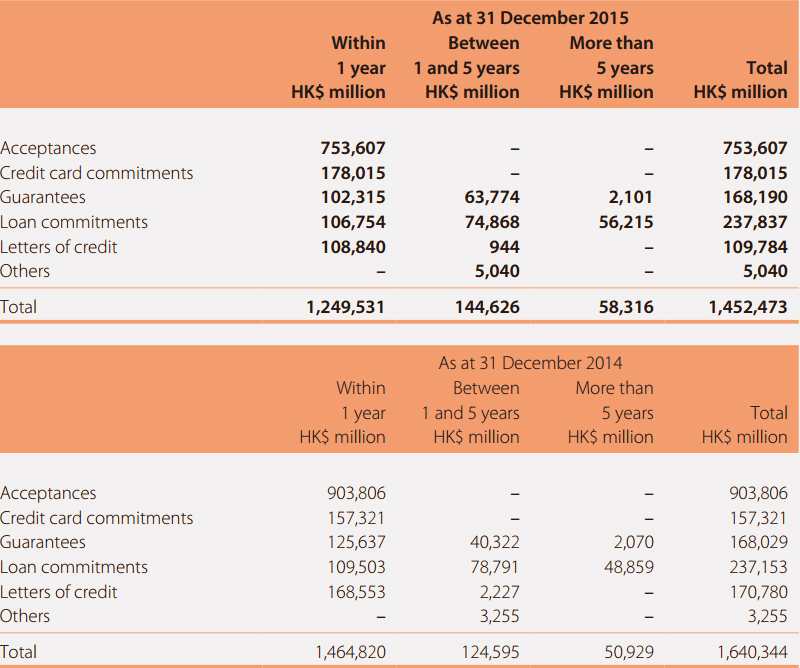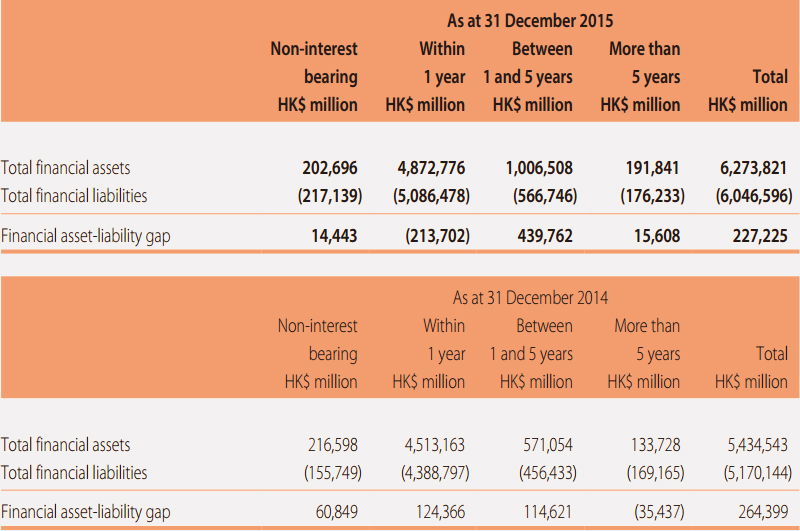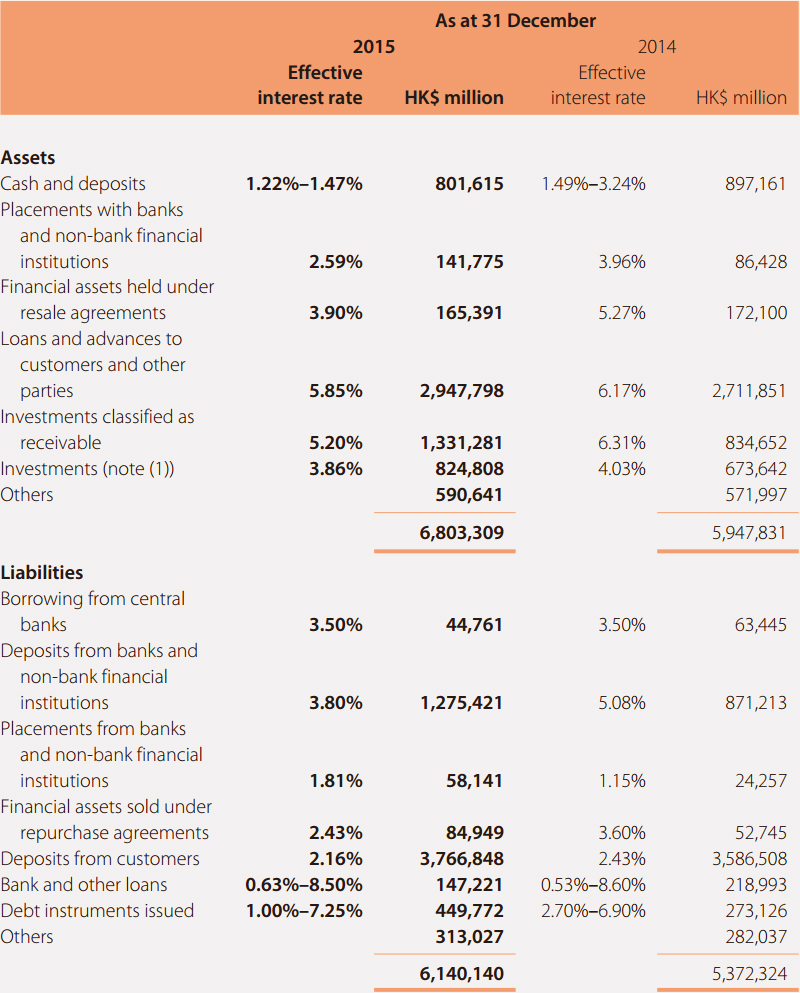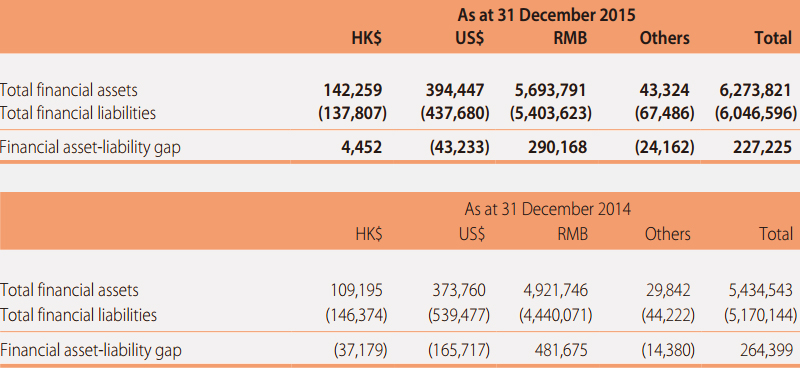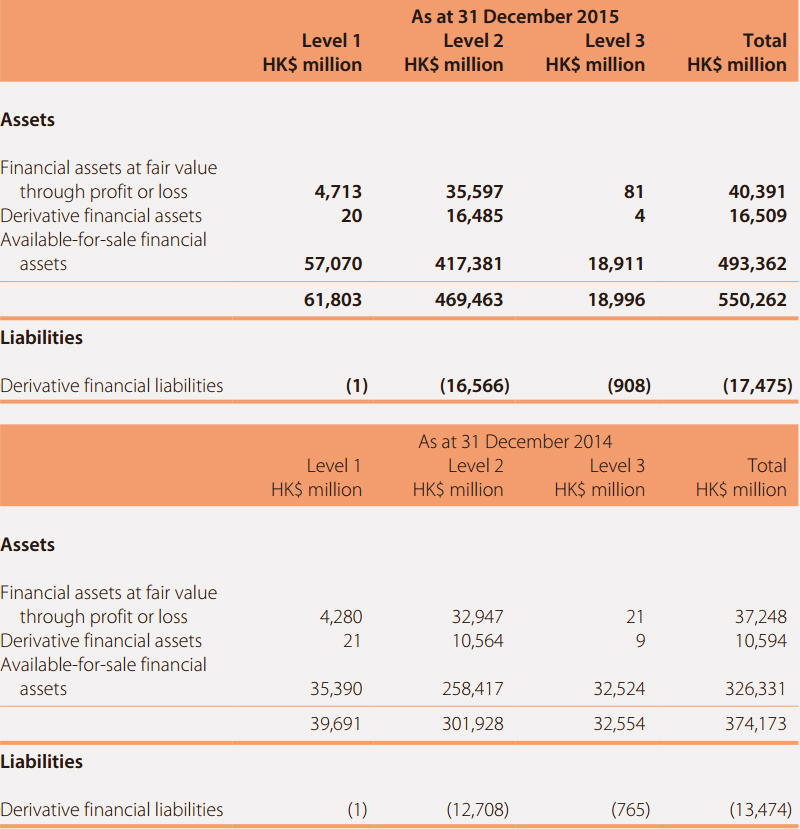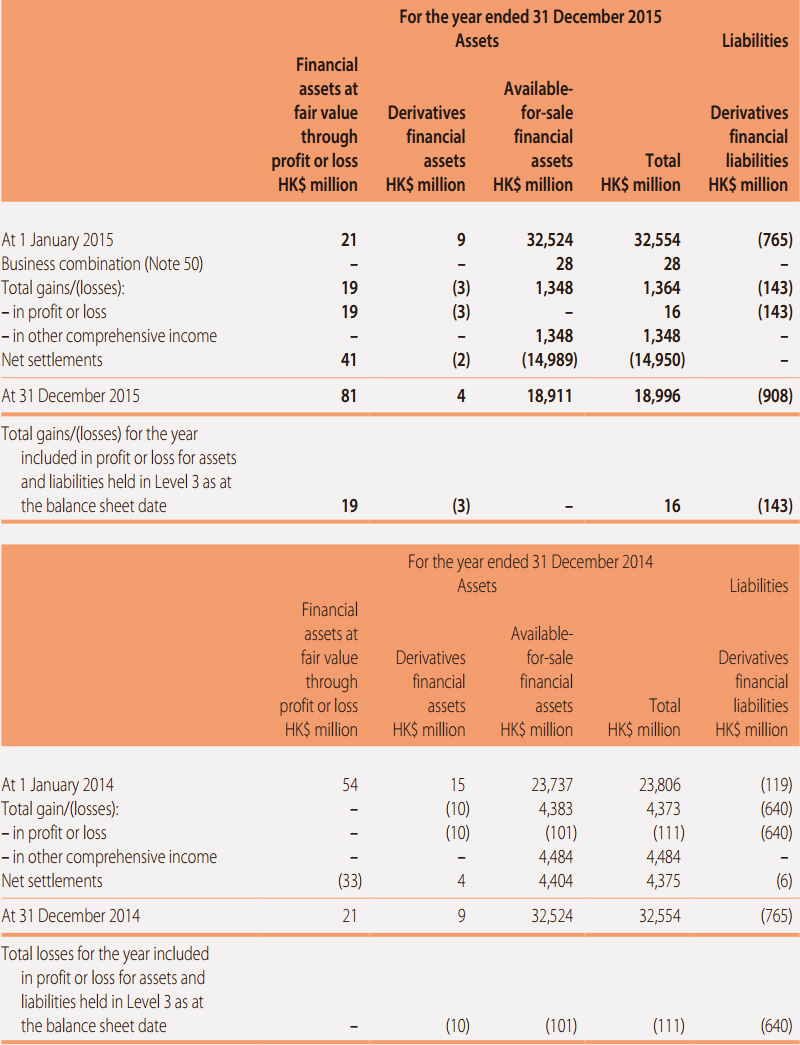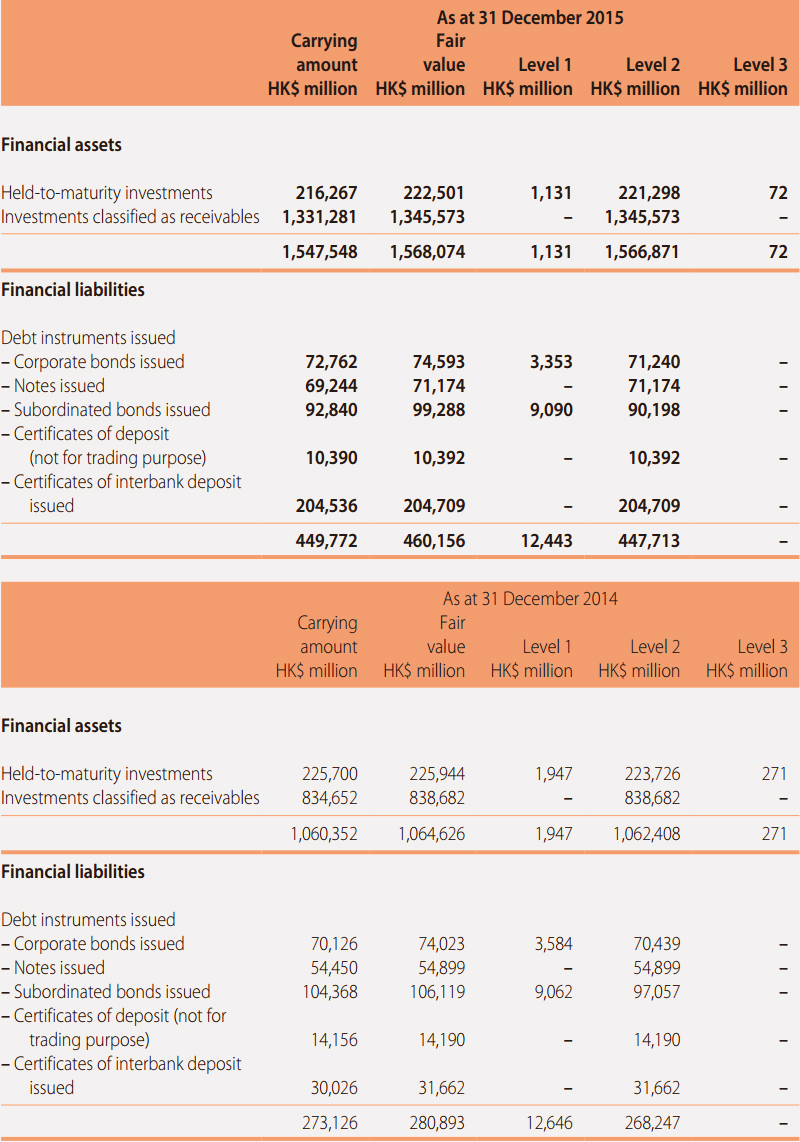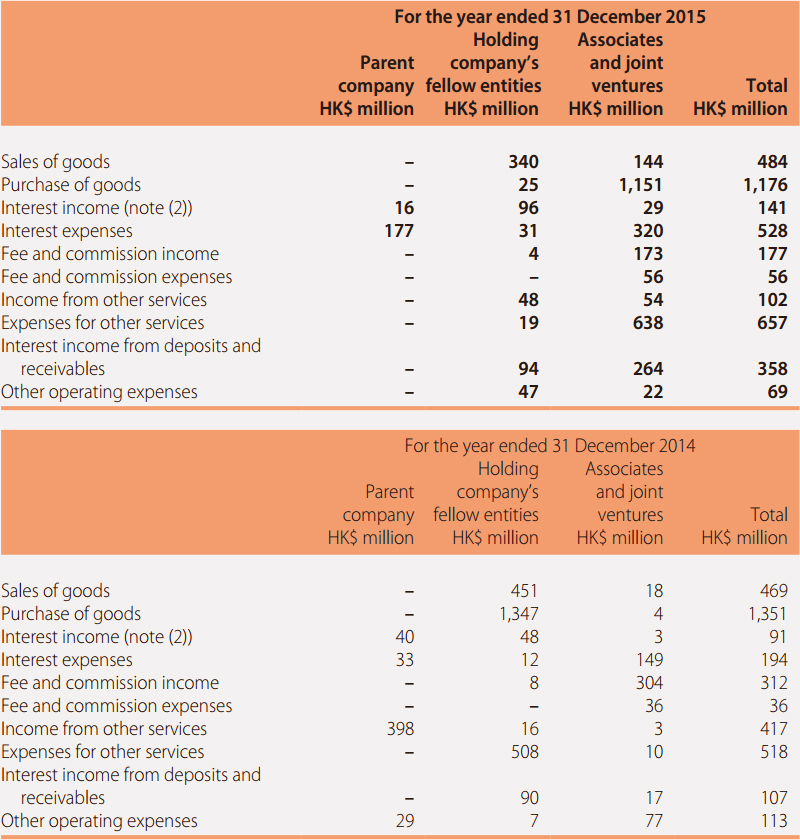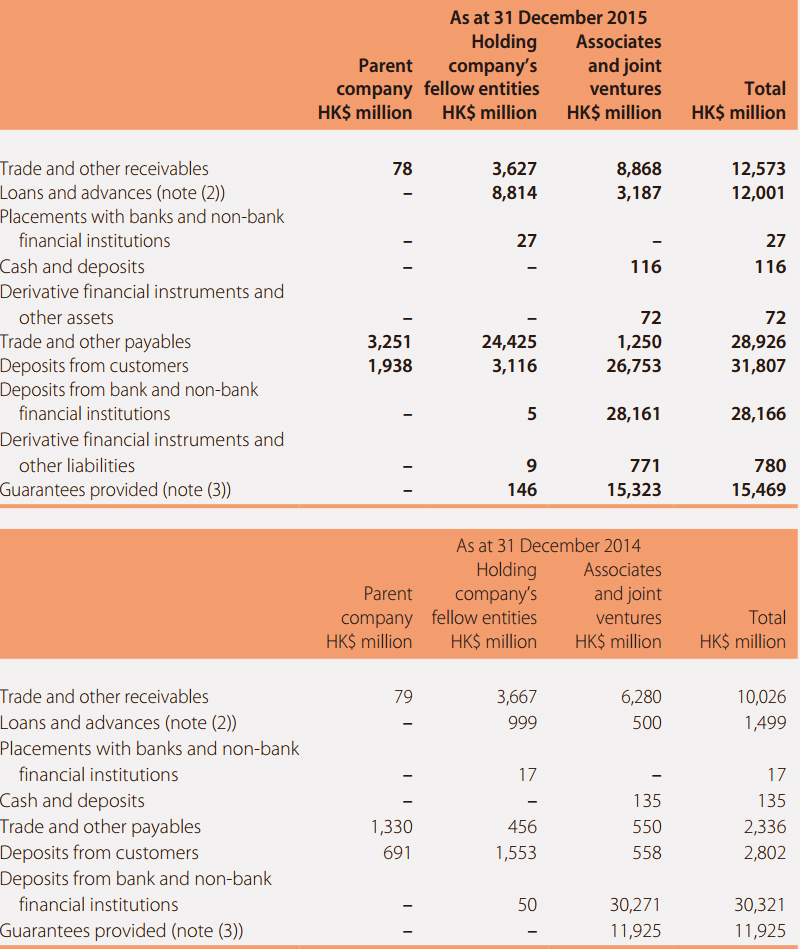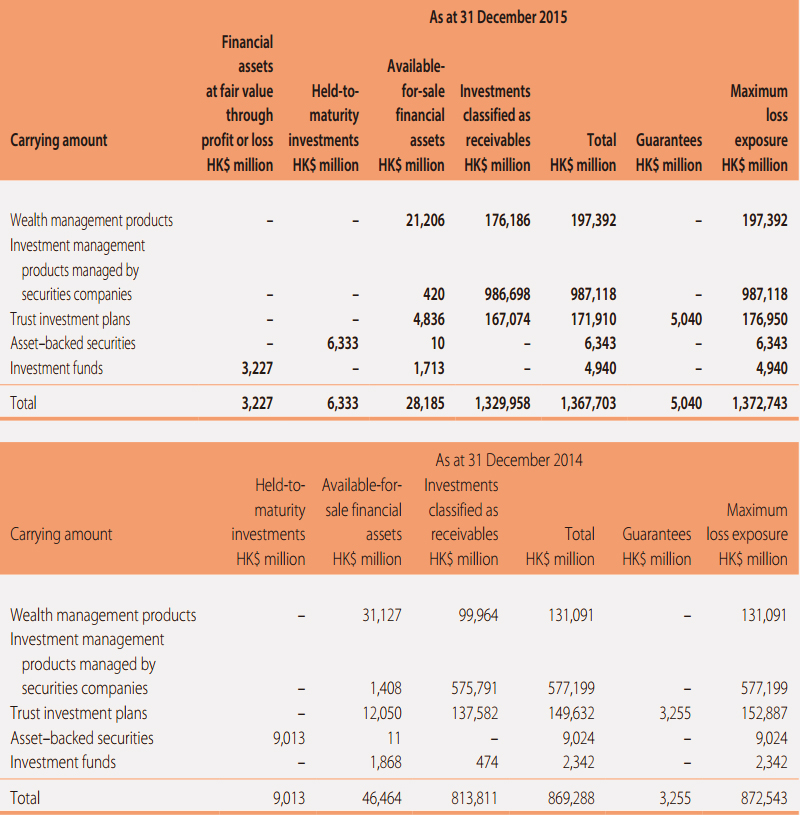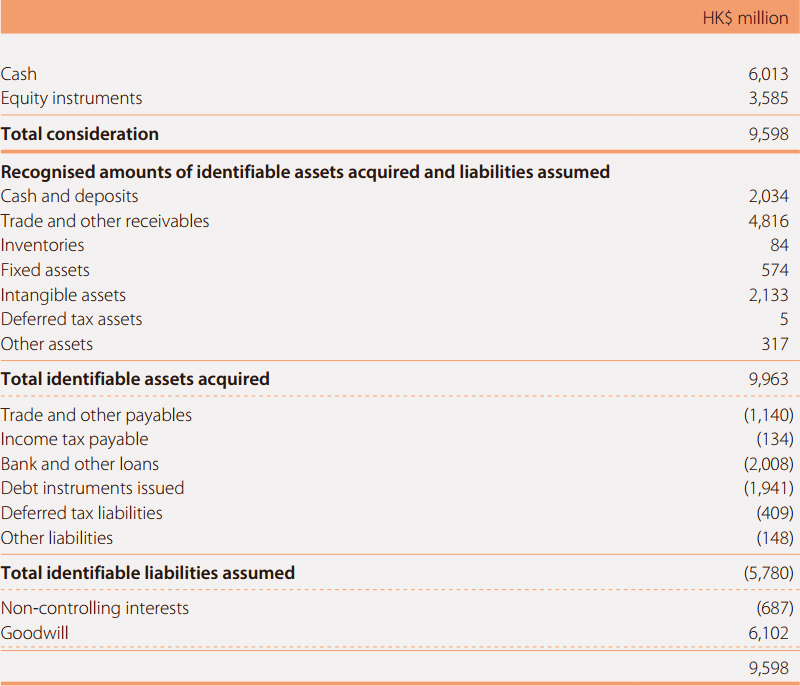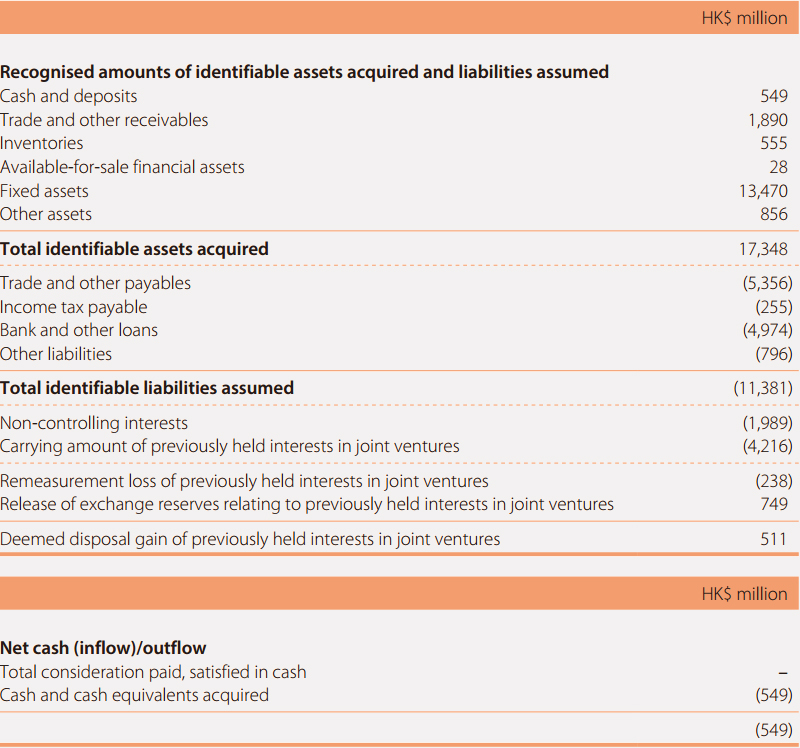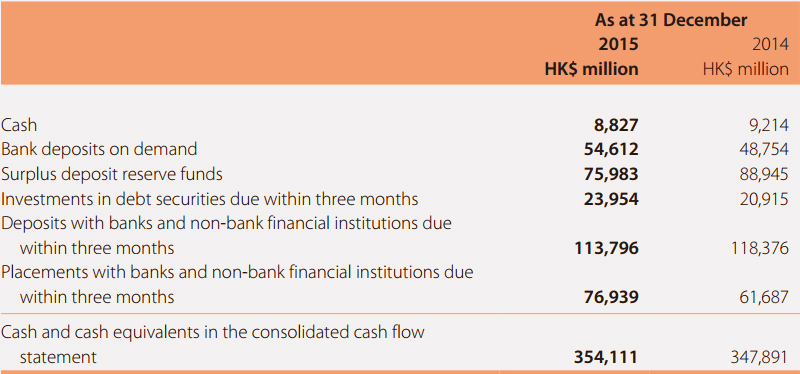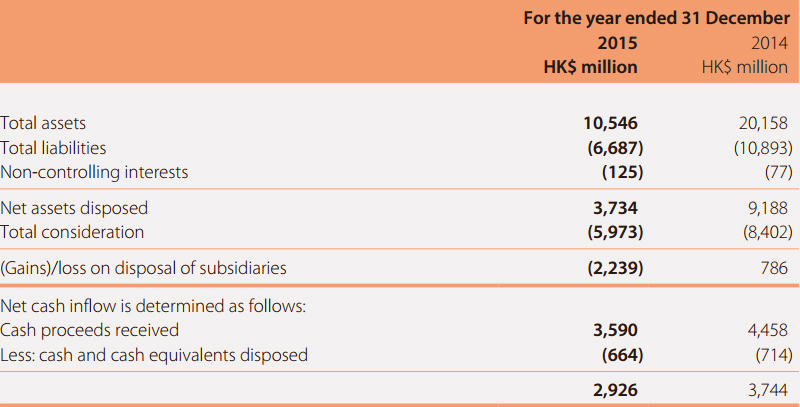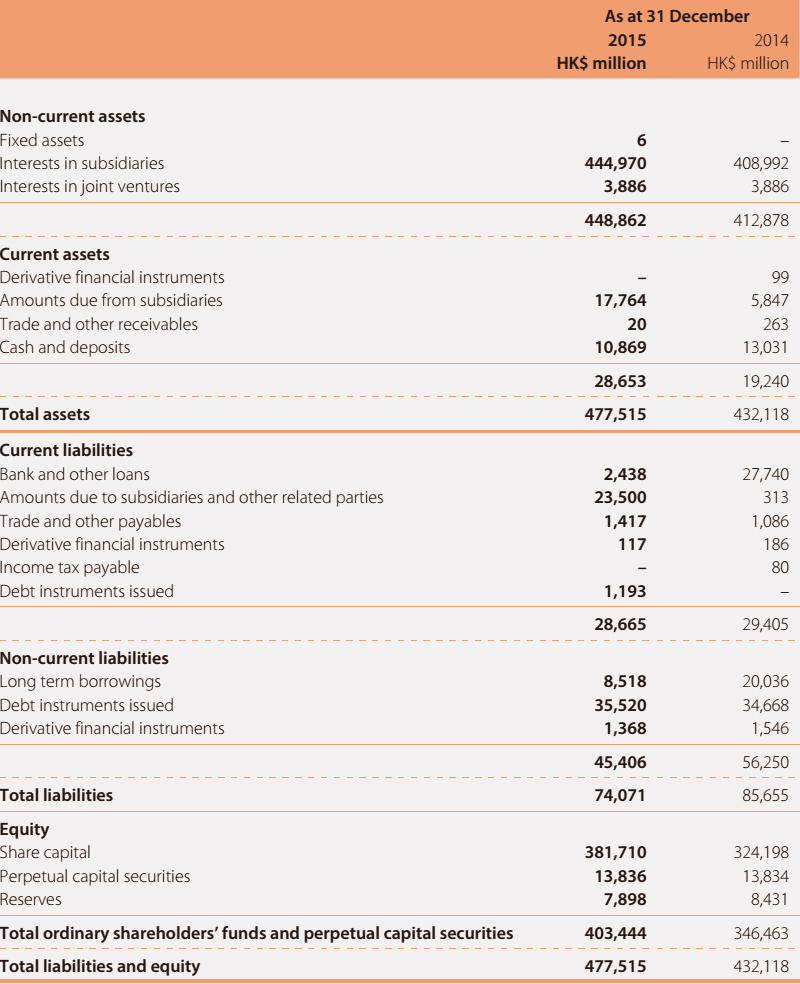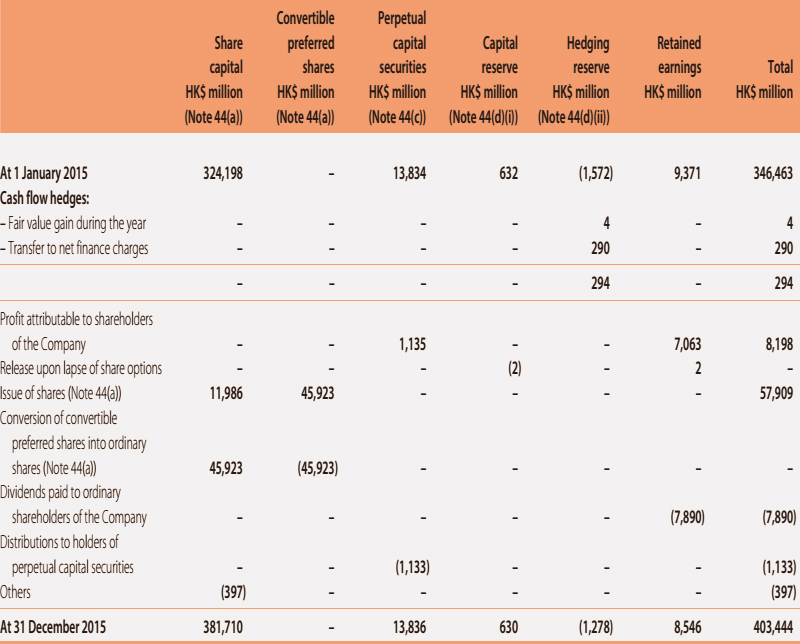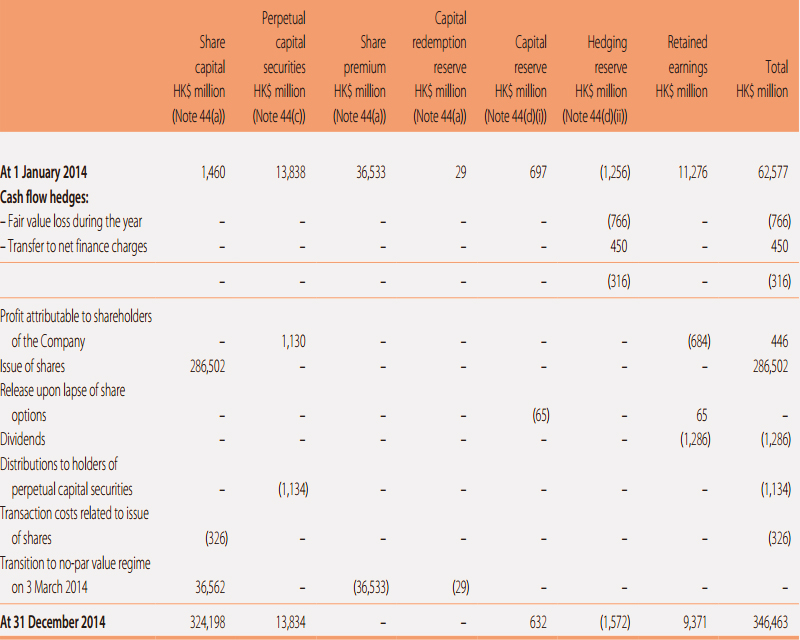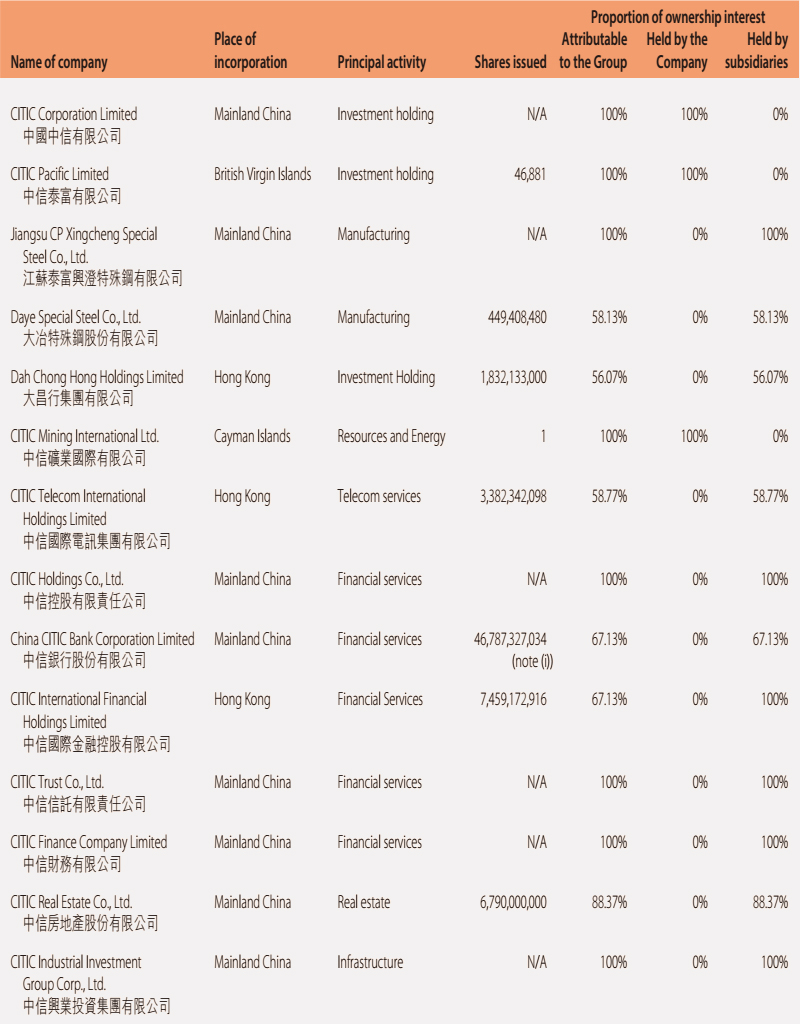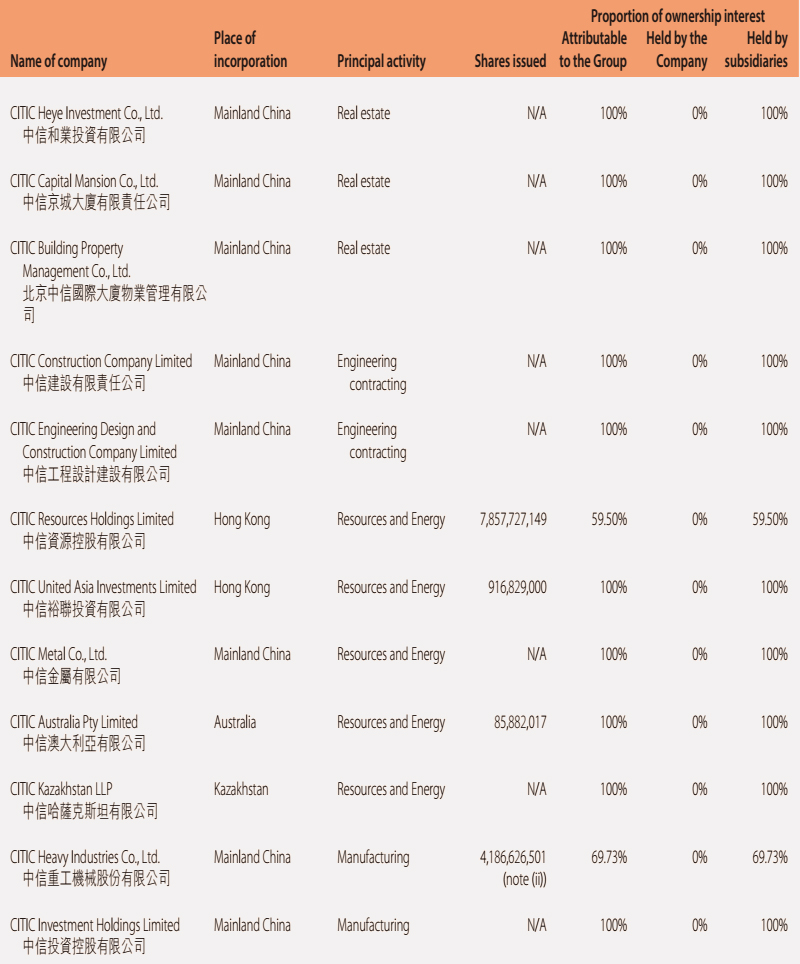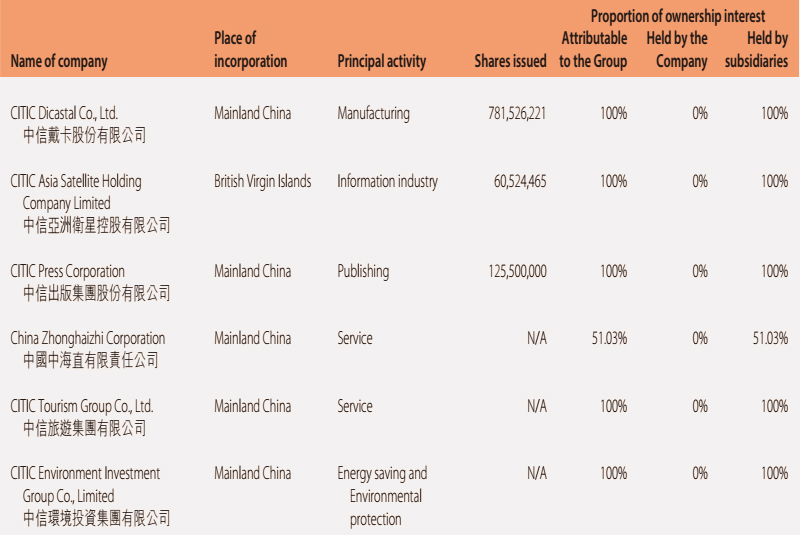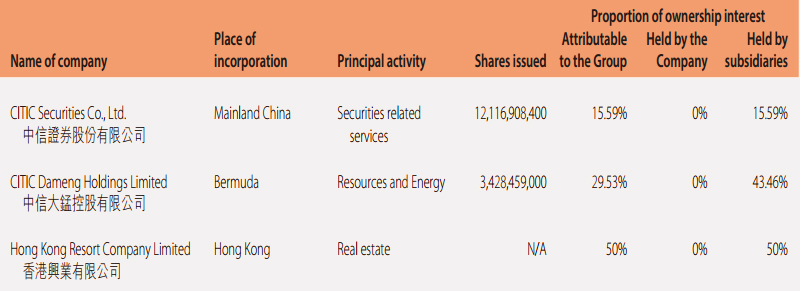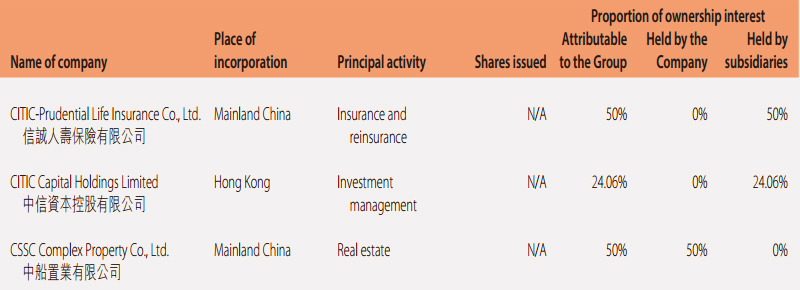Notes to the Financial Statements
-
1. General Information
CITIC Limited (the “Company”) was incorporated in Hong Kong and formerly known as CITIC Pacific Limited (“Former CITIC Pacific”), the shares of which are listed on the Main Board of the Stock Exchange of Hong Kong Limited. The address of its registered office is 32nd Floor, CITIC Tower, 1 Tim Mei Avenue, Central Hong Kong. Before 8 May 2014, the former CITIC Limited (“Former CITIC Limited”) held 57.51% equity interests in Former CITIC Pacific through its overseas wholly-owned subsidiaries, and the shareholders of Former CITIC Limited were CITIC Group Corporation (“CITIC Group”) and Beijing CITIC Enterprise Management Co., Ltd. (“CITIC Enterprise Management”), a wholly-owned subsidiary of CITIC Group.
In March 2014, a framework agreement to transfer the shares of Former CITIC Pacific was entered into between several parties. Pursuant to the framework agreement, the subsidiaries of Former CITIC Limited which held the shares of Former CITIC Pacific transferred these shares to certain overseas wholly-owned subsidiaries of CITIC Group (“the Transfer”). The Transfer was approved by the regulatory authorities and completed on 8 May 2014.
On 16 April 2014, CITIC Group, CITIC Enterprise Management and Former CITIC Pacific entered into a share transfer agreement, pursuant to which Former CITIC Pacific acquired 100% equity interests in Former CITIC Limited from CITIC Group and CITIC Enterprise Management (“the Acquisition”).
The Acquisition was completed on 25 August 2014. The name of Former CITIC Limited was changed from CITIC Limited to CITIC Corporation Limited (“CITIC Corporation”) and the name of Former CITIC Pacific was changed from CITIC Pacific Limited to CITIC Limited. Upon the completion of the Acquisition, CITIC Group held 77.9% equity interests in the Company through its overseas wholly-owned subsidiaries.
In 2015, CITIC Group disposed certain equity interests in the Company through its overseas wholly-owned subsidiaries, and the Company issued some new ordinary shares (Note 44(a)). As at 31 December 2015, the equity interests held by CITIC Group in the Company through its overseas wholly-owned subsidiaries decreased from 77.9% to 58.13%.
The Company and its subsidiaries (collectively referred to as the “Group”) are principally engaged in financial services, resources and energy, manufacturing, engineering contracting, real estate and other businesses.
The parent and the ultimate holding company of the Company is CITIC Group.
-
2. Significant accounting policies
(a) Basis of preparation
These financial statements have been prepared in accordance with all applicable Hong Kong Financial Reporting Standards (“HKFRS”), which in collective term includes all applicable individual Hong Kong Financial Rerpoting Standards, Hong Kong Accounting Standards (“HKAS”) and Interpretations issued by the Hong Kong Institute of Certified Public Accountants (“HKICPA”) and accounting principles generally accepted in Hong Kong. These financial statements also comply with the applicable disclosure provisions of the Rules Governing the Listing of Securities on The Stock Exchange of Hong Kong Limited. A summary of the significant accounting policies adopted by the Group is set out below.
The HKICPA has issued a number of amendments to HKFRS that are first effective for the current accounting period of the Group. Impacts of the adoption of the amended HKFRS are discussed below:
(i) Amendments to HKAS 19, Defined benefit plans: Employee contributions
This narrow scope amendment applies to contributions from employees or third parties to defined benefit plans. The amendment distinguishes between contributions that are linked to service only in the period in which they arise and those linked to service in more than one period. The amendment allows contributions that are linked to service, and do not vary with the length of employee service, to be deducted from the cost of benefits earned in the period that the service is provided. Contributions that are linked to service, and vary according to the length of employee service, must be spread over the service period using the same attribution method that is applied to the benefits.
(ii) Annual improvements to HKFRS 2010-2012 cycle
Amendments to HKFRS 8, Operating segments
The standard is amended to require disclosure of the judgements made by management in aggregating operating segments and a reconciliation of segment assets to the entity’s assets when segment assets are reported.-
Amendments to HKAS 16, Property, plant and equipment and HKAS 38, Intangible assets
Both standards are amended to clarify how the gross carrying amount and the accumulated depreciation are treated where an entity uses the revaluation model. Amendments to HKAS 24, Related party disclosures
The reporting entity is not required to disclose the compensation paid by the management entity (as a related party) to the management entity’s employee or directors, but it is required to disclose the amounts charged to the reporting entity by the management entity for services provided.
(iii) Annual improvements to HKFRS 2011-2013 cycle
Amendments to HKFRS 3, Business combinations
It clarifies that HKFRS 3 does not apply to the accounting for the formation of any joint arrangement under HKFRS 11 in the financial statements of the joint arrangement.-
Amendments to HKFRS 13, Fair value measurement
It clarifies that the portfolio exception in HKFRS 13, which allows an entity to measure the fair value of a group of financial assets and financial liabilities on a net basis, applies to all contracts (including non-financial contracts) within the scope of HKAS 39 or HKFRS 9. Amendments to HKAS 40, Investment property
Preparers also need to refer to the guidance in HKFRS 3 to determine whether the acquisition of an investment property is a business combination.
The adoption of the above amendments has no material impact on the financial statements of the Group. The Group has not applied any new standard or interpretation that is not yet effective for the current accounting period.
In addition, the requirements of Part 9 “Accounts and Audit” of the new Hong Kong Companies Ordinance (Cap. 622) came into operation during the year. The Group has concluded that the impact is unlikely to be significant and will primarily only affect the presentation and disclosure of information in consolidated financial statements.
(b) Functional currency and presentation currency
The functional currency of the Company is Hong Kong dollars (“HK$”). The functional currencies of overseas subsidiaries are determined in accordance with the primary economic environment in which they operate, and are translated into HK$ for the preparation of the consolidated financial statements (see Note 2(h)). The financial statements of the Group are presented in HK$ and, unless otherwise stated, expressed in million of HK$.
(c) Basis of measurement
The measurement basis used in the preparation of the consolidated financial statements is the historical cost basis except that the following assets and liabilities are stated at their fair values as explained in the accounting policies set out below:
– investment properties (see Note 2(l));
– financial assets and liabilities at fair value through profit or loss (including trading financial assets or trading financial liabilities) (see Note 2(i));
– available-for-sale financial assets, except for those whose fair value cannot be measured reliably (see Note 2(i)); and
– fair value hedged items (see Note 2(j)(i)).
(d) Use of estimates and judgement
The preparation of these consolidated financial statements requires management to make judgements, estimates and assumptions that affect the application of policies and reported amounts of assets, liabilities, income and expenses. The estimates and associated assumptions are based on historical experience and various other factors that are believed to be reasonable under the circumstances, the results of which form the basis of making the judgements about carrying values of assets and liabilities that are not readily apparent from other sources. The estimates and underlying assumptions are reviewed on an ongoing basis. Actual results may differ from these estimates.
Judgements made by management that have significant effect on the financial statements and estimates with a significant risk of material adjustment in subsequent period are described in Note 3. Revisions to accounting estimates are recognised in the period which the estimates are revised and in any future periods affected.
(e) Subsidiaries and non-controlling interests
(i) Business combinations involving entities under common control
A business combination involving entities under common control is a business combination in which all of the combining entities are ultimately controlled by the same party or parties both before and after the business combination, and that control is not transitory. The assets acquired and liabilities assumed are measured based on their carrying amounts in the consolidated financial statements of the ultimate controlling party at the combination date. The difference between the carrying amount of the net assets acquired and the consideration paid for the combination (or the total face value of shares issued) is adjusted against the capital reserve. Any cost directly attributable to the combination is recognised in profit or loss when incurred. The combination date is the date on which one combining entity obtains control of other combining entities.
(ii) Business combinations not involving entities under common control
A business combination not involving entities under common control is a business combination in which all of the combining entities are not ultimately controlled by the same party or parties both before and after the business combination. Where (1) the aggregate of the acquisition date fair value of assets transferred (including the acquirer’s previously held equity interest in the acquiree), liabilities incurred or assumed, and equity securities issued by the acquirer, in exchange for control of the acquiree, exceeds (2) the acquirer’s interest in the acquisition date fair value of the acquiree’s identifiable net assets, the difference is recognised as goodwill. If (1) is less than (2), the difference is recognised in profit or loss for the current period. The costs of equity or debt securities as a part of the consideration for the acquisition are included in the carrying amounts of these equity or debt securities upon initial recognition. Other acquisition-related costs are expensed when incurred. Any difference between the fair value and the carrying amount of the assets transferred as consideration is recognised in profit or loss. The acquiree’s identifiable assets, liabilities and contingent liabilities, if the recognition criteria are met, are recognised by the Group at their acquisition date fair value. The acquisition date is the date on which the acquirer obtains control of the acquiree.
The Group recognises any non-controlling interest in the acquiree on an acquisition-by-acquisition basis. Non-controlling interests in the acquiree that are present ownership interests and entitle their holders to a proportionate share of the entity’s net assets in the event of liquidation are measured at either fair value or the present ownership interests’ proportionate share in the recognised amounts of the acquiree’s identifiable net assets. All other components of non-controlling interests are measured at their acquisition date fair value, unless another measurement basis is required by HKFRS.
For a business combination not involving entities under common control and achieved in stages, the Group remeasures its previously-held equity interest in the acquiree to its fair value at the acquisition date. The difference between the fair value and the carrying amount is recognised as investment income for the current period; the amount recognised in other comprehensive income relating to the previously-held equity interest in the acquiree are transferred to investment income in the period in which the acquisition occurs.
(iii) Consolidated financial statements
The scope of consolidated financial statements is based on control and the consolidated financial statements comprise the Company and its subsidiaries.
Subsidiaries are entities over which the Group has control. The Group controls an entity when it is exposed to, or has the rights to, variable returns from its involvement with the entity and has the ability to affect those returns through its power over the entity.
When assessing whether the Group has power, only substantive rights (held by the Group and other parties) are considered.
An investment in a subsidiary is consolidated into the consolidated financial statements of the Group from the date that control commences until the date that control ceases.
Where a subsidiary was acquired during the reporting period, through a business combination involving entities under common control, the financial statements of the subsidiary are included in the consolidated financial statements as if the combination had occurred at the date the ultimate controlling party first obtained control. Therefore the opening balances and the comparative figures of the consolidated financial statements are restated. In the preparation of the consolidated financial statements, the subsidiary’s assets, liabilities and results of operations are included in the consolidated balance sheet and the consolidated statement of comprehensive income, respectively, based on their carrying amounts, from the date that common control was established. Net profit earned by the acquiree prior to the date of acquisition is separately disclosed.
Where a subsidiary was acquired during the reporting period, through a business combination involving entities not under common control, the identifiable assets, liabilities and results of operations of the subsidiaries are consolidated into the consolidated financial statements from the date that control commences, based on the fair value of those identifiable assets and liabilities at the acquisition date.
Non-controlling interests are presented in the consolidated balance sheet within equity, separately from equity attributable to the ordinary shareholders of the Company. Non-controlling interests in the results of the Group are presented on the face of the consolidated statement of comprehensive income as an allocation of the total profit or loss and total comprehensive income for the year between non-controlling interests and the ordinary shareholders of the Company. Loans from holders of non-controlling interests and other contractual obligations towards these holders are presented as financial liabilities in the consolidated balance sheet in accordance with Note 2(i).
When the amount of loss for the current period attributable to the non-controlling interest of a subsidiary exceeds the non-controlling interest’s portion of the opening balance of shareholders’ equity of the subsidiary, the excess is allocated against the non-controlling interests.
When the accounting period or accounting policies of a subsidiary are different from those of the Group, the Group makes necessary adjustments to the financial statements of the subsidiary based on the Group’s own accounting period or accounting policies. Intra-group balances, transactions and cash flows, and any unrealised profit or loss arising from intra-group transactions, are eliminated in preparing the consolidated financial statements. Unrealised losses resulting from intra-group transactions are recognised fully in profit or loss when evidence of impairment of assets being provided.
Where the Group acquires a non-controlling interest from a subsidiary’s non-controlling shareholders or disposes of a portion of an interest in a subsidiary without a change in control, the difference between the amount by which the non-controlling interests are adjusted and the amount of the consideration paid or received is adjusted to the reserve (capital reserve) in the consolidated balance sheet. If the credit balance of reserve (capital reserve) is insufficient, any excess is adjusted to retained earnings.
When the Group loses control of a subsidiary, it is accounted for as a disposal of the entire interest in that subsidiary, with a resulting gain or loss being recognised in profit or loss, and the Group derecognises assets, liabilities, non-controlling interests and other related items in shareholders’ equity in relation to that subsidiary. Any interest retained in that former subsidiary at the date when control is lost is recognised at fair value and this amount is regarded as the fair value on initial recognition of a financial asset (see Note 2(i)) or, when appropriate, the cost on initial recognition of an investment in an associate or joint venture (see Note 2(f)).
(iv) Investment in subsidiaries
In the Company’s balance sheet, an investment in a subsidiary is stated at cost less impairment losses (see Note 2(t)(ii)).
The results of subsidiaries are accounted for by the Company on the basis of dividends received and receivable.
(f) Associates and joint ventures
An associate is an entity in which the Group has significant influence, but not control or joint control, over its management, including participation in the financial and operating policy decisions.
A joint venture is an arrangement whereby the Group and other parties contractually agree to share control of the arrangement, and have rights to the net assets of the arrangement.
An investment in an associate or a joint venture is accounted for in the consolidated financial statements of the Group under the equity method. Under the equity method, the investment is initially recorded at cost, adjusted for any excess of the Group’s share of the acquisition-date fair values of the investee’s identifiable net assets over the cost of the investment (if any). Thereafter, the investment is adjusted for the post acquisition change in the Group’s share of the investee’s net assets and any impairment loss relating to the investment (see Note 2(t)(ii)). Any acquisition-date excess of the Group’s share of the fair value of the investee’s identifiable net assets over cost, the Group’s share of the post-acquisition, post-tax results of the investees and any impairment losses for the year are recognised in profit or loss, whereas the Group’s share of the post-acquisition, post-tax items of the investees’ other comprehensive income is recognised in other comprehensive income of the Group. The Group’s interest in associate or joint venture is included in the consolidated financial statements from the date that significant influence or joint control commences until the date that significant influence or joint control ends.
When the Group’s share of losses exceeds its interest in the associate or the joint venture, the Group’s interest is reduced to nil and recognition of further losses is discontinued except to the extent that the Group has incurred legal or constructive obligations or made payments on behalf of the investee. For this purpose, the Group’s interest is the carrying amount of the investment under the equity method together with the Group’s long-term interests that in substance form part of the Group’s net investment in the associate or the joint venture.
Unrealised profits and losses resulting from transactions between the Group and its associate and joint venture are eliminated to the extent of the Group’s interest in the investee, except where unrealised losses provide evidence of an impairment of the asset transferred, in which case they are recognised immediately in profit or loss.
If an investment in an associate becomes an investment in a joint venture or vice versa, retained interest is not remeasured. Instead, the investment continues to be accounted for under the equity method.
In all other cases, when the Group ceases to have significant influence over an associate or joint control over a joint venture, it is accounted for as a disposal of the entire interest in that investee, with a resulting gain or loss being recognised in profit or loss. Any interest retained in that former investee at the date when significant influence or joint control is lost is recognised at fair value and this amount is regarded as the cost on initial recognition of a financial asset (see Note 2(i)).
In the Company’s balance sheet, investments in associates and joint ventures are stated at cost less impairment losses (see Note 2(t)(ii)).
(g) Goodwill
Goodwill represents the excess of the consideration transferred, including the amount of assets transferred (including the acquirer’s previously held equity interest in the acquiree), liabilities incurred or assumed, and the equity securities issued by the acquirer at the date of acquisition, over the fair value of the Group’s share of the identifiable net assets acquired, when the excess is positive, otherwise it’s recognised directly in profit or loss.
Positive goodwill will be stated in the consolidated balance sheet as a separate asset or included within joint ventures and associates at cost less accumulated impairment losses and is subject to impairment testing at least annually. Impairment losses on goodwill are not reversed. Negative goodwill is recognised in profit or loss immediately on acquisition.
(h) Translation of foreign currencies
Foreign currency transactions are, on initial recognition, translated by applying the foreign exchange rates ruling at the transaction dates. Monetary items denominated in foreign currencies are translated at the foreign exchange rates ruling at the reporting date, the resulting exchange differences are recognised in profit or loss. Non-monetary items that are measured in terms of historical cost in a foreign currency are translated using the exchange rates ruling at the transaction dates. Non-monetary items that are measured at fair value in a foreign currency are translated using the foreign exchange rates ruling at the dates the fair value was determined. The exchange differences are recognised in profit or loss, except for the differences arising from the translation of available-for-sale equity investments, which is recognised in other comprehensive income.
The financial statements of the Group’s subsidiaries with a foreign functional currency are translated into HK$ for the preparation of the Group’s consolidated financial statements. The assets and liabilities in these financial statements are translated into HK$ at the foreign exchange rates ruling at the reporting date. The equity items, except for “retained earnings”, are translated to HK$ at the foreign exchange rates at the dates on which such items arose.
Income and expenses in the profit or loss are translated into HK$ at the foreign exchange rates or the rates that approximate the foreign exchange rates at the transaction dates. The resulting exchange differences are presented as “Reserves” (exchange reserve) in the consolidated balance sheet within the shareholder’s equity
Upon disposal of a foreign operation, the cumulative amount of the translation differences recognised in shareholders’ equity which relates to that foreign operation is transferred to profit or loss in the period in which the disposal occurs.
(i) Financial instruments
(i) Initial recognition
The Group classifies its financial instruments into different categories at inception, depending on the purpose for which the assets were acquired or the liabilities were incurred, and on the contractual terms of the financial instruments. The categories are: financial assets or financial liabilities at fair value through profit or loss, loans and receivables, held-to-maturity investments, available-for-sale financial assets and other financial liabilities.
Financial instruments are measured initially at fair value, which normally will be equal to the transaction price plus, in case of a financial asset or financial liability not held at fair value through profit or loss, transaction costs that are directly attributable to the acquisition of the financial asset or issue of the financial liability. Transaction costs on financial assets and financial liabilities at fair value through profit or loss are expensed immediately.
The Group recognises financial assets and financial liabilities on the date it becomes a party to the contractual provisions of the instrument. A regular way purchase or sale of financial assets and financial liabilities at fair value through profit or loss is recognised using trade date accounting. Other financial assets and financial liabilities are recognised using settlement date accounting. From these dates, any gains and losses arising from changes in fair value of the financial assets or financial liabilities at fair value through profit or loss are recorded.
(ii) Categorisation
Financial assets at fair value through profit or loss
This category comprises financial assets held for trading, and those designated at fair value through profit or loss upon initial recognition, but excludes those investments in equity instruments that do not have a quoted market price and whose fair value cannot be reliably measured.
A financial asset is classified as held for trading if it is: (i) acquired principally for the purpose of selling it in the near term; (ii) part of a portfolio of identified financial instruments that are managed together and for which there is evidence of a recent actual pattern of short-term profit-taking; or (iii) a derivative. Derivatives that do not qualify for hedge accounting (Note 2(j)) are accounted for as trading instruments.
Financial instruments are designated at fair value through profit or loss upon initial recognition when:
– the assets are managed, evaluated and reported internally on a fair value basis;
– the designation eliminates or significantly reduces an accounting mismatch in the gain and loss recognition arising from the difference in measurement bases of the financial assets which would otherwise arise;
– the asset contains an embedded derivative that significantly modifies the cash flows that would otherwise be required under the contract; or
– the separation of the embedded derivative(s) from the financial instrument is not prohibited.
Financial assets under this category are carried at fair value. Changes in the fair value are included in profit or loss in the period in which they arise. Upon disposal the difference between the net sale proceeds and the carrying value is included in profit or loss.
Loans and receivables
Loans and receivables are non-derivative financial assets with fixed or determinable payments that are not quoted in an active market, other than (a) those that the Group intends to sell immediately or in the near term, which will be classified as held for trading; (b) those that the Group, upon initial recognition, designates as at fair value through profit or loss or as available-for-sale; or (c) those where the Group may not recover substantially all of its initial investment, other than because of credit deterioration, which will be classified as available-for-sale.
Loans and receivables mainly comprise loans and advances to customers and other parties, deposits and placements with banks and non-bank financial institutions, financial assets held under resale agreements, investments classified as receivables, and trade and other receivables.
Loans and receivables are carried at amortised cost using the effective interest method, less impairment losses, if any (see Note 2(t)(i)). Where the receivables are interest-free loans made to related parties without any fixed repayment term or the effect of discounting would be immaterial, the receivables are stated at cost less allowance for impairment of doubtful debts.
Held-to-maturity investments
Held-to-maturity investments are non-derivative financial assets with fixed or determinable payments and fixed maturity for which the Group has the positive intention and ability to hold to maturity, other than (a) those that the Group, upon initial recognition, designates as at fair value through profit or loss or as available-for-sale; and (b) those that meet the definition of loans and receivables.
Held-to-maturity investments are carried at amortised cost using the effective interest method less impairment losses, if any (see Note 2(t)(i)).
If, as a result of a change in intention or ability, it is no longer appropriate to classify an investment as held-to-maturity, it shall be reclassified as available-for-sale and remeasured at fair value.
Available-for-sale financial assets
Available-for-sale financial assets are non-derivative financial assets that are designated as availablefor-sale or are not classified in any of the other three categories above. They include financial assets intended to be held for an indefinite period of time, but which may be sold in response to needs for liquidity or changes in the market environment.
Available-for-sale financial assets are carried at fair value. Unrealised gains and losses arising from changes in the fair value are recognised in other comprehensive income and accumulated separately in equity, except for impairment losses and foreign exchange gains and losses on monetary items such as debt securities which are recognised in profit or loss. Dividend income from equity securities and interest income from debt securities calculated using the effective interest method are recognised in profit or loss in accordance with the policies set out in Note 2(w)(vii) and 2(w)(i) respectively.
Investments in equity securities that do not have a quoted market price in an active market and whose fair value cannot be measured reliably, and derivatives that are linked to and must be settled by delivery of such unquoted equity securities are carried at cost less impairment losses, if any (see Note 2(t)(i)).
When the available-for-sale financial assets are sold, gains or losses on disposal include the difference between the net sale proceeds and the carrying value, and the accumulated fair value adjustments which are previously recognised in other comprehensive income shall be reclassified from equity to profit or loss.
Financial liabilities at fair value through profit or loss
Fair value is the price that would be received to sell an asset or paid to transfer a liability in an orderly transaction in the principal (or most advantageous) market at the measurement date under current market conditions (i.e. an exit price) regardless of whether that price is directly observable or estimated using another valuation technique.
A financial liability is classified as held for trading if it is: (i) acquired or incurred principally for the purpose of repurchasing it in the near term; (ii) part of a portfolio of identified financial instruments that are managed together and for which there is evidence of a recent actual pattern of short-term profit-taking; or (iii) a derivative (except for a derivative that is a financial guarantee contract or a designated and effective hedging instrument).
Financial liabilities are designated at fair value through the profit or loss upon initial recognition when: (i) the financial liabilities or are managed, evaluated and reported internally on a fair value basis; (ii) the designation eliminates or significantly reduces an accounting mismatch in the gain and loss recognition arising from the difference in measurement bases of the financial liabilities; or (iii) a contract contains one or more embedded derivatives, i.e. an entire hybrid (combined) contract, unless: (i) the embedded derivative does not significantly modify the cash flows that otherwise would be required by the hybrid (combined) contract; or (ii) it is clear with little or no analysis when a similar hybrid (combined) instrument is first considered that separation of the embedded derivative is prohibited.
Other financial liabilities
Financial liabilities, other than trading liabilities and those designated at fair value through profit or loss, are measured at amortised cost using the effective interest method.
Other financial liabilities mainly comprise borrowing from central banks, deposits from banks and non-bank financial institutions, placements from banks and non-bank financial institutions, trade and other payables, financial assets sold under repurchase agreements, deposits from customers, banks and other loans, and debt instruments issued.
(iii) Fair value measurement principles
Fair value is the price that would be received to sell an asset or paid to transfer a liability in an orderly transaction in the principal (or most advantageous) market at the measurement date under current market conditions (i.e. an exit price) regardless of whether that price is directly observable or estimated using another valuation technique.
If there is no publicly available latest traded price nor a quoted market price on a recognised stock exchange or a price from a broker/dealer for non-exchange-traded financial instruments, or if the market for it is not active, the fair value of the instrument is estimated using valuation techniques that provide a reliable estimate of prices which could be obtained in actual market transactions.
Where discounted cash flow techniques are used, estimated future cash flows are based on management’s best estimates and the discount rate is based on the relevant government yield curve as at the balance sheet date plus an adequate constant credit spread. Where other pricing models are used, inputs are based on market data at the balance sheet date.
(iv) Derecognition
A financial asset is derecognised when the contractual rights to receive the cash flows from the financial asset expire, or where the financial asset together with substantially all the risks and rewards of ownership, have been transferred.
The Group derecognises a financial asset, if the part being considered for derecognition meets one of the following conditions: (a) the contractual rights to receive the cash flows from the financial asset expire; or (b) the contractual rights to receive the cash flows of the financial asset have been transferred, and the Group transfers substantially all the risks and rewards of ownership of the financial asset; or (c) the Group retains the contractual rights to receive the cash flows of the financial asset, but assumes a contractual obligation to pay the cash flows to the eventual recipient in an agreement that meets all the conditions of derecognition of transfer of cash flows and transfers substantially all the risks and rewards of ownership of the financial asset.
Where a transfer of a financial asset in its entirety meets the criteria for derecognition, the difference between the two amounts below is recognised in profit or loss:
– the carrying amount of the financial asset transferred;
– the sum of the consideration received from the transfer and any cumulative gain or loss that has been recognised directly in equity.
If the Group neither transfers nor retains substantially all the risks and rewards of ownership of the financial asset, but retains control, the Group continues to recognise the financial asset to the extent of its continuing involvement in the financial asset. If the Group has not retained control, it derecognises the financial asset and recognises separately as assets or liabilities any rights and obligations created or retained in the transfer.
As part of its operational activities, the Group securitises financial assets, generally through the sale of these assets to structured entities which issue securities to investors. Further details on prerequisites for derecognition of financial assets are set out above. When the securitisation of financial assets that do qualify for derecognition, the relevant financial assets are derecognised in their entirety and a new financial asset or liabilities is recognised regarding the interest in unconsolidated securitisation vehicles that the Group receives as part of the transfer. When the securitisation of financial assets that do not qualify for derecognition, the relevant financial assets are not derecognised, and the consideration paid by third parties are recorded as a financial liability; when the securitisation of financial assets that partially qualify for derecognition, the book value of the transferred asset should be recognised between the derecognised portion and the retained portion based on their respective relative fair values, and the difference between the book value of the derecognised portion and the total consideration paid for the derecognised portion shall be recorded in profit or loss.
The derecognition of financial assets sold on condition of repurchase is determined by the economic substance of the transaction. If a financial asset is sold under an agreement to repurchase the same or substantially the same asset at a fixed price or at the sale price plus a reasonable return, the Group will not derecognise the asset. If a financial asset is sold together with an option to repurchase the financial asset at its fair value at the time of repurchase (in case of transferor sells such financial asset), the Group will derecognise the financial asset.
The financial liability is derecognised only when: (a) the underlying present obligation specified in the contracts is discharged/cancelled, or (b) an agreement between the Group and an existing lender to exchange the original financial liability with a new financial liability with substantially different terms, or a substantial modification of the terms of an existing financial liability is accounted for as an extinguishment of the original financial liability and recognition of a new financial liability. The difference between the carrying amount of the financial liability derecognised and the consideration paid is recognised in profit or loss.
(v) Offsetting
Financial assets and financial liabilities are offset and the net amount is reported in the balance sheet where there is a legally enforceable right to offset the recognised amounts and there is an intention to settle on a net basis, or realise the asset and settle the liability simultaneously.
(vi) Derivatives
The Group uses derivatives to hedge its exposure on risks. The Group adopts hedge accounting in accordance with Note 2(j) for derivatives designated as hedging instruments if the hedge is effective. Other derivatives are accounted for as trading financial assets or financial liabilities. Derivatives are recognised at fair value upon initial recognition. The positive fair value is recognised as assets while the negative fair value is recognised as liabilities. The gain or loss on re-measurement to fair value is recognised immediately in profit or loss.
(vii) Embedded derivatives
An embedded derivative is a component of a hybrid (combined) instrument that includes both the derivative and a host contract with the effect that some of the cash flows of the combined instrument vary in a way similar to a stand-alone derivative. The embedded derivatives are separated from the host contract and accounted for as a derivative when (a) the economic characteristics and risks of the embedded derivative are not closely related to the host contract; and (b) the hybrid (combined) instrument is not measured at fair value with changes in fair value recognised in profit or loss.
When the embedded derivative is separated, the host contract is accounted for in accordance with Note 2(i)(ii) above.
(j) Hedging
Hedge accounting recognises the offsetting effects on profit or loss of changes in the fair values of the hedging instrument and the hedged item. The Group assesses and documents whether the financial instruments that are used in hedging transactions are highly effective in offsetting changes in fair values or cash flows of hedged items attributable to the hedged risks both at hedge inception and on an ongoing basis. The Group discontinues prospectively hedge accounting when (a) the hedging instrument expires or is sold, terminated or exercised; (b) the hedge no longer meets the criteria for hedge accounting; or (c) the Group revokes the designation.
(i) Fair value hedge
A fair value hedge seeks to offset risks of changes in the fair value of recognised asset or liability that will give rise to a gain or loss being recognised in profit or loss. The hedging instrument is measured at fair value, with fair value changes recognised in profit or loss. The carrying amount of the hedged item is adjusted by the amount of the changes in fair value of the hedging instrument attributable to the risk being hedged. This adjustment is recognised in profit or loss to offset the effect of the gain or loss on the hedging instrument.
When a hedging instrument expires or is sold, terminated or exercised, the hedge no longer meets the criteria for hedge accounting, or the Group revokes designation of the hedge relationship, any adjustment up to that point, to a hedged item for which the effective interest method is used, is amortised to profit or loss as part of the recalculated effective interest rate of the item over its remaining life.
(ii) Cash flow hedge
Where a derivative financial instrument is designated as a hedge of the variability in cash flows of a recognised asset or liability, or a highly probable forecast transaction, or the foreign currency risk of a committed future transaction, the effective part of any gain or loss on remeasurement of the derivative financial instrument to fair value is recognised in other comprehensive income and accumulated separately in equity in the hedging reserve. The ineffective portion of any gain or loss is recognised immediately in profit or loss.
If the hedge of a forecast transaction subsequently results in the recognition of a non-financial asset or non-financial liability, the associated gain or loss is reclassified from equity to be included in the initial cost or other carrying amount of the non-financial asset or liability
If a hedge of a forecast transaction subsequently results in the recognition of a financial asset or a financial liability, the associated gain or loss is reclassified from equity to the profit or loss in the same period or periods during which the asset acquired or liability assumed affects the profit or loss (such as when interest income or expense is recognised).
For cash flow hedges, other than those covered by the preceding two policy statements, the associated gain or loss is reclassified from equity to profit or loss in the same period or periods during which the hedged forecast transaction affects profit or loss.
When a hedging instrument expires or is sold, terminated or exercised, or the Group revokes designation of the hedge relationship but the hedged forecast transaction is still expected to occur, the cumulative gain or loss at that point remains in equity until the transaction occurs and is recognised in accordance with the above policy. If the hedged transaction is no longer expected to take place, the cumulative unrealised gain or loss is reclassified from equity to profit or loss immediately.
(iii) Hedge effectiveness testing
In order to qualify for hedge accounting, the Group carries out prospective effectiveness testing to demonstrate that it expects the hedge to be highly effective at the inception of the hedge and throughout its life. Actual effectiveness (retrospective effectiveness) is also demonstrated on an ongoing basis.
The documentation of each hedging relationship sets out how the effectiveness of the hedge is assessed. The method which the Group adopts for assessing hedge effectiveness will depend on its risk management strategy.
For fair value hedge relationships, the Group utilises the cumulative dollar offset method or regression analysis as effectiveness testing methodologies. For cash flow hedge relationships, the Group utilises the change in variable cash flow method or the cumulative dollar offset method using the hypothetical derivative approach.
For prospective effectiveness, the hedging instrument must be expected to be highly effective in achieving offsetting changes in fair value or cash flows attributable to the hedged risk during the period for which the hedge is designated. For actual effectiveness, the changes in fair value or cash flows must offset each other in the range of 80 per cent to 125 per cent for the hedge to be deemed effective.
(k) Financial assets held/sold under resale/repurchase agreements
Financial assets held under resale agreements are transactions that the Group acquires financial assets which will be resold at a predetermined price in the future date under resale agreements. Financial assets sold under repurchase agreements are transactions that the Group sells financial assets which will be repurchased at a predetermined price in the future date under repurchase agreements.
The cash advanced or received is recognised as amounts held under the resale and repurchase agreements in the balance sheet. Assets held under resale agreements are recorded in memorandum accounts as off-balance sheet items. Assets sold under repurchase agreements continue to be recognised in the balance sheet.
The difference between the sale and repurchase consideration, and that between the purchase and resale consideration, are amortised over the period of the respective transaction using the effective interest method and are included in interest income and interest expense respectively.
(l) Investment properties
Investment properties are interests in land and/or buildings which are held to earn rentals or for capital appreciation or both. These include land held for a currently undetermined future use. Land held under operating leases is classified and accounted for as investment property when the rest of the definition of investment property is met.
Investment properties are stated in the balance sheet at fair values which are reviewed annually. Any gain or loss arising from a change in fair value or from the retirement or disposal of an investment property is recognised in profit or loss.
(m) Property, plant and equipment
Property, plant and equipment are carried at cost less accumulated depreciation and accumulated impairment losses (Note 2(t)(ii)).
Assets in the course of construction for production, rental or administrative purposes are carried at cost, less any impairment losses. Cost includes the cost of materials, direct labour, the initial estimate, where relevant, of the costs of dismantling and removing the items and restoring the site on which they are located, and an appropriate proportion of overheads.
Construction-in-progress represents property, plant and equipment under construction and is transferred to fixed assets when ready for its intended use.
No depreciation is provided in respect of construction in progress. Upon completion and commissioning for operation, depreciation will be provided at the appropriate rate specified below.
Property, plant and equipment are depreciated at rates sufficient to write off their cost, less impairment losses, if any, to their estimated residual values, over their estimated useful lives on a straight line basis as follows:
– Plant and buildings 5–70 years – Machinery and equipment 3–26 years – Office and other equipment, vehicles and vessels and others 3–10 years Freehold land within the category of plant and buildings are not depreciated.
Assets’ useful lives and residual values are reviewed, and adjusted if appropriate, at each balance sheet date.
An asset’s carrying amount is written down immediately to its recoverable amount if the asset’s carrying amount is greater than its estimated recoverable amount.
The recoverable amount of an asset is the greater of its fair value less costs of disposal and value in use.
Gains and losses on disposals are determined by comparing the proceeds with the carrying amount and are recognised in profit or loss.
(n) Land use rights
Land use rights are stated at cost less accumulated amortisation and accumulated impairment losses (if any). Land use rights are amortised on a straight-line basis over the respective periods of grant, usually within 10 to 50 years.
Impairment losses on land use rights are accounted for in accordance with the accounting policies as set out in Note 2(t)(ii).
(o) Intangible assets (other than goodwill)
Intangible assets acquired by the Group are stated at cost less accumulated amortisation (where the estimated useful life is finite) and impairment losses (see Note 2(t)(ii)).
Amortisation of intangible assets with finite useful lives is charged to profit or loss over the assets’ estimated useful lives. The following intangible assets are amortised from the date they are available for use as follows:
– Roads and tunnels operating rights Over the estimated useful lives of 30 years – Mining assets Over the estimated useful lives of the mines in
accordance with the production plan of the entities
concerned and the proven probable reserves of the
mines using the unit-of-production method.Both the period and method of amortisation are reviewed annually.
Intangible assets are not amortised while their useful lives are assessed to be indefinite. Any conclusion that the useful life of an intangible asset is indefinite is reviewed annually to determine whether events and circumstances continue to support the indefinite useful life assessment for that asset. If they do not, the change in the useful life assessment from indefinite to finite is accounted for prospectively from the date of change and in accordance with the policy for amortisation of intangible assets with finite lives as set out above.
(p) Inventories
(i) Manufacturing, resources and energy segments
Inventories of the manufacturing, and resources and energy segments are carried at the lower of cost and net realisable value.
Cost is calculated using the first-in first-out, specific identification or weighted average cost formula as appropriate, and comprises all costs of purchase, costs of conversion and other costs incurred in bringing the inventories to their present location and condition.
Net realisable value is the estimated selling price in the ordinary course of business less the estimated costs of completion and the estimated costs necessary to make the sale.
When inventories are sold, the carrying amount of those inventories is recognised as an expense in the period in which the related revenue is recognised. The amount of any write-down of inventories to net realisable value and all losses of inventories are recognised as an expense in the period the write-down or loss occurs. The amount of any reversal of any write-down of inventories is recognised in profit or loss in the period in which the reversal occurs.
(ii) Real estate segment
Inventories in respect of property development activities under the real estate segment are carried at the lower of cost and net realisable value. Cost and net realisable values are determined as follows:
– Property under development
The cost of properties under development comprises specifically identified cost, including the acquisition cost of land, aggregate cost of development, materials and supplies, wages and other direct expenses, an appropriate proportion of overheads and borrowing costs capitalised (see Note 2(bb)). Net realisable value represents the estimated selling price less estimated costs of completion and costs to be incurred in selling the property.。
– Completed property held for sale
In the case of completed properties developed by the Group, cost is determined by apportionment of the total development costs for that development project, attributable to the unsold properties. Net realisable value represents the estimated selling price less costs to be incurred in selling the property.
The cost of completed properties held for sale comprises all costs of purchase, costs of conversion and other costs incurred in bringing the inventories to their present location and condition.
(q) Construction contracts
Construction contracts are contracts specifically negotiated with a customer for the construction of an asset or a group of assets, where the customer is able to specify the major structural elements of the design. The accounting policy for contract revenue is set out in Note 2(w)(v). When the outcome of a construction contract can be estimated reliably, contract costs are recognised as an expense by reference to the stage of completion of the contract at the balance sheet date. When it is probable that total contract costs will exceed total contract revenue, the expected loss is recognised as an expense immediately. When the outcome of a construction contract cannot be estimated reliably, contract costs are recognised as an expense in the period in which they are incurred.
Construction contracts in progress at the balance sheet date are recorded at the net amount of costs incurred plus recognised profit less recognised losses and progress billings, and are presented in the balance sheet as “amount due from customers for contract work” or “amount due to customers for contract work”.
(r) Operating leases
Leases which do not transfer substantially all the risks and rewards of ownership to the lessee are classified as operating leases.
Where the Group leases out assets under operating leases, the assets are included in the balance sheet according to their nature and, where applicable, are depreciated in accordance with the Group’s depreciation policies, as set out in Note 2(m) except where the asset is classified as an investment property. Impairment losses are accounted for in accordance with the accounting policy as set out in Note 2(t)(ii). Revenue arising from operating leases is recognised in accordance with the Group’s revenue recognition policies, as set out in Note 2(w)(vi).
Where the Group has the use of assets held under operating leases, payments made under the leases are charged to profit or loss in equal instalments over the accounting periods covered by the lease term, except where an alternative basis is more representative of the pattern of benefits to be derived from the leased asset. Lease incentives received are recognised in profit or loss as an integral part of the aggregate net lease payments made. Contingent rentals are charged to profit or loss in the accounting period in which they are incurred.
The cost of acquiring land held under an operating lease is amortised on a straight-line basis over the period of the lease term except where the property is classified as an investment property (see Note 2(l)).
(s) Repossessed assets
In the recovery of impaired loans and advances, the Group may take possession of assets held as collateral through court proceedings or voluntary delivery of possession by the borrowers. Where it is intended to achieve an orderly realisation of the impaired assets and the Group is no longer seeking repayment from the borrower, repossessed assets are reported in “other assets”.
When the Group seizes assets to compensate for the losses of loans and advances and interest receivables, the repossessed assets are initially recognised at fair value, plus any taxes paid for the seizure of the assets, litigation fees and other expenses incurred for collecting the repossessed assets are included in the carrying value of repossessed assets. Repossessed assets are recognised at the carrying value, net of allowances for impairment losses.
Impairment losses on initial recognition and on subsequent remeasurement are recognised in profit or loss.
(t) Impairment of assets
(i) Financial assets
The carrying amounts of the Group’s financial assets other than those measured at fair value through profit and loss are reviewed at balance sheet date to determine whether there is objective evidence of impairment. Objective evidence that financial assets are impaired includes but not limited to one or more of the following loss events that occurred after the initial recognition of the asset and has an impact on the future cash flows on the assets that can be estimated reliably:
– significant financial difficulty of the issuer or borrower;
– a breach of contract, such as a default or delinquency in interest or principal payments;
– the Group, for economic or legal reasons relating to the borrower’s financial difficulty, granting to the borrower a concession that the Group would not otherwise consider;
– it becoming probable that the borrower will enter bankruptcy or other financial reorganisation;
– disappearance of an active market for financial assets because of financial difficulties;
– observable data indicating that there is a measurable decrease in the estimated future cash flows from a group of financial assets since the initial recognition of those assets, although the decrease cannot yet be identified with the individual financial assets in the Group, including: adverse changes in the payment status of borrowers in the Group, an increase in the unemployment rate in the geographical area of the borrowers, a decrease in property prices for mortgages in the relevant area, or adverse changes in industry conditions that affect the borrowers in the Group;
– significant changes in the technological, market, economic or legal environment that have an adverse effect on the issuer;
– a significant or prolonged decline in the fair value of an investment in an equity instrument below its cost; and
– other objective evidence indicating there is an impairment of a financial asset.
If any such evidence exists, the carrying amount is reduced to the estimated recoverable amount by means of a charge to profit or loss.
Impairment losses are written off against the corresponding assets directly, except for impairment losses recognised in respect of loans and receivables and held-to-maturity investments, which are measured at amortised cost, whose recovery is considered doubtful but not remote. In this case, the impairment losses are recorded using an allowance account. When the Group is satisfied that recovery is remote after all the necessary legal or other proceedings are completed, the amount considered irrecoverable is written off against loans and receivables or held-to-maturity investments directly and any amounts held in the allowance account relating to that borrower/investment are reversed. Subsequent recoveries of amounts previously charged to the allowance account are reversed against the allowance account. Other changes in the allowance account and subsequent recoveries of amounts previously written off directly are recognised in profit or loss.
Loans and receivables
Impairment losses on loans and receivables are measured as the difference between the asset’s carrying amount and the present value of estimated future cash flows discounted at the asset’s original effective interest rate (i.e. the effective interest rate computed at initial recognition of these assets). Receivables with a short duration are not discounted if the effect of discounting is immaterial.
The total allowance for credit losses consists of two components: individual impairment allowances, and collective impairment allowances.
The Group first assesses whether objective evidence of impairment exists individually for financial assets that are individually significant, and collectively for financial assets that are not individually significant. If the Group determines that no objective evidence of impairment exists for an individually assessed financial asset, whether significant or not, it includes the asset in a group of financial assets with similar credit risk characteristics and collectively assesses them for impairment. Assets that are individually assessed for impairment and for which an impairment loss is or continues to be recognised are not included in a collective assessment of impairment.
The individual impairment allowance is based upon management’s best estimate of the present value of the cash flows which are expected to be received, discounted at the original effective interest rate. In estimating these cash flows, management makes judgements about the borrower’s financial situation and the net realisable value of any underlying collateral or guarantees in favour of the Group. Each impaired asset is assessed on its own merits.
In assessing the need for collective loan loss allowances, management uses statistical modelling and considers historical trends of factors such as credit quality, portfolio size, concentrations, and economic factors. In order to estimate the required allowance, the Group makes assumptions both to define the way the Group models inherent losses and to determine the required input parameters, based on historical experience and current economic conditions.
The accuracy of the impairment allowances the Group makes depends on how well the Group can estimate future cash flows for individually assessed impairment allowances and the model assumptions and parameters used in determining collective impairment allowances. While this necessarily involves judgement, the Group believes that the impairment allowances on loans and advances to customers are reasonable and supportable.
Any subsequent changes to the amounts and timing of the expected future cash flows compared to the prior estimates that can be linked objectively to an event occurring after the write-down, will result in a change in the impairment allowances on loans and receivables and be charged or credited to the income statement. A reversal of impairment losses is limited to the loans and receivables’ carrying amount that would have been determined had no impairment loss been recognised in prior years.
When there is no reasonable prospect of recovery, the loan and the related interest receivables are written off.
Loans and receivables with renegotiated terms are loans that have been restructured due to deterioration in the borrower’s financial position and where the Group has made concessions that it would not otherwise consider. Renegotiated loans and receivables are subject to ongoing monitoring to determine whether they remain impaired or past due.
Held-to-maturity investments
Impairment on held-to-maturity investments is considered at both an individual and collective level. The individual impairment allowance is measured as the difference between the asset’s carrying amount and the present value of estimated future cash flows, discounted at the asset’s original effective interest rate, where the effect of discounting is material.
All significant assets found not to be individually impaired are then collectively assessed for any impairment that has been incurred but not yet identified. Assets that are not individually significant are then collectively assessed for impairment by grouping together financial assets with similar risk characteristics.
If in a subsequent period the amount of an impairment loss decreases and the decrease can be linked objectively to an event occurring after the impairment loss was recognised, the impairment loss is reversed through the income statement. A reversal of impairment losses shall not result in the asset’s carrying amount exceeding that which would have been determined had no impairment loss been recognised in prior years.
Available-for-sale financial assets
When there is objective evidence that an available-for-sale financial asset is impaired, the cumulative loss that had been recognised in the fair value reserve is reclassified to profit or loss. The amount of the cumulative loss that is recognised in profit or loss is the difference between the acquisition cost (net of any principal repayment and amortisation) and current fair value, less any impairment loss on that asset previously recognised in profit or loss.
For unquoted available-for-sale equity securities that are carried at cost, the impairment loss is measured as the difference between the carrying amount of the equity securities and the estimated future cash flows, discounted at the current market rate of return for a similar financial asset where the effect of discounting is material. Such impairment losses are not reversed.
Impairment losses recognised in profit or loss in respect of available-for-sale equity securities are not reversed through profit or loss. Any subsequent increase in the fair value of such assets is recognised in other comprehensive income.
Impairment losses in respect of available-for-sale debt securities are reversed if the subsequent increase in fair value can be objectively related to an event occurring after the impairment loss was recognised. Reversals of impairment losses in such circumstances are recognised in profit or loss.
(ii) Non-financial assets
Internal and external sources of information are reviewed at balance sheet date to identify indications that the following assets may be impaired or, except in the case of goodwill, an impairment loss previously recognised no longer exists or may have decreased:
– property, plant and equipment (other than properties carried at revalued amounts);
– land use rights;
– investments in subsidiaries, associates and joint ventures;
– goodwill; and
– intangible assets.
If any such indication exists, the asset’s recoverable amount is estimated. In addition, for goodwill and intangible assets that are not yet available for use and intangible assets that have indefinite useful lives, the recoverable amount is estimated annually whether or not there is any indication of impairment.
Calculation of recoverable amount
The recoverable amount of an asset is the greater of its fair value less costs of disposal and value in use. In assessing value in use, the estimated future cash flows are discounted to their present value using a pre-tax discount rate that reflects current market assessments of time value of money and the risks specific to the asset. Where an asset does not generate cash inflows largely independent of those from other assets, the recoverable amount is determined for the smallest group of assets that generates cash inflows independently (i.e. a cash-generating unit).
Recognition of impairment losses
An impairment loss is recognised in profit or loss whenever the carrying amount of an asset, or the cash-generating unit to which it belongs, exceeds its recoverable amount. Impairment losses recognised in respect of cash-generating units are allocated first to reduce the carrying amount of any goodwill allocated to the cash-generating unit (or group of units) and then, to reduce the carrying amount of the other assets in the unit (or group of units) on a pro rata basis, except that the carrying value of an asset will not be reduced below its individual fair value less costs of disposal (if measurable) or value in use (if determinable).
Reversals of impairment losses
If, in a subsequent period, the amount of impairment loss of the non-financial asset except for goodwill decreases and the decrease can be linked objectively to an event occurring after the impairment was recognised, the previously recognised impairment loss is reversed through the profit or loss. A reversal of impairment loss is limited to the asset’s carrying amount that would have been determined had no impairment loss been recognised in prior periods.
An impairment loss in respect of goodwill is not reversible.
(u) Employee benefits
(i) Short-term employee benefits
During the accounting period when an employee has rendered service to the Group, the Group recognises the undiscounted amount of short-term employee benefits as a liability and as an expense, unless another HKFRS requires or permits the inclusion of the benefits in the cost of an asset. Short-term employee benefits include wages, bonuses and social security contributions such as medical insurance, work-related injury insurance and maternity insurance, as well as housing provident funds, which are all calculated based on the regulated benchmark and ratio. Where the payment of liability is expected not to be settled wholly before twelve months after the end of the annual reporting period in which the employees render the related services, and the effect would be material, these liabilities are stated at their present values in the balance sheet.
(ii) Defined contribution retirement schemes
Employees of the Group’s subsidiaries in Hong Kong are offered the option to enroll in one of the Mandatory Provident Fund (“MPF”) Master Trust Schemes under the CITIC Group MPF Scheme. The MPF Master Trust Schemes are defined contribution schemes and are administered in accordance with the terms and provisions of the respective trust deeds and are subject to the Mandatory Provident Fund Schemes Ordinance.
Employees of the Group’s PRC subsidiaries are required to participate in defined contribution retirement schemes and make contributions according to the respective regulations. Employees of the Group’s PRC subsidiaries are also eligible to participate in the enterprise annuity plan established by the Group according to the relevant requirements.
Employees of the Group’s overseas subsidiaries are required to make contributions subjected to the relevant regulations in the countries/jurisdiction in which the overseas subsidiaries operate.
The contributions are charged to profit and loss for the current period on an accrual basis.
(v) Financial guarantees issued, provisions and contingent liabilities
(i) Financial guarantees issued
Financial guarantees are contracts that require the issuer (i.e. the guarantor) to make specified payments to reimburse the beneficiary of the guarantee (the “holder”) for a loss the holder incurs because a specified debtor fails to make payment when due in accordance with the terms of a debt instrument.
Where the Group issues a financial guarantee, the fair value of the guarantee is initially recognised as deferred income within “other liabilities”. The fair value of financial guarantees issued at the time of issuance is determined by reference to fees charged in an arm’s length transaction for similar services, when such information is obtainable, or is otherwise estimated by reference to interest rate differentials, by comparing the actual rates charged by lenders when the guarantee is made available with the estimated rates that lenders would have charged, had the guarantees not been available, where reliable estimates of such information can be made. Where consideration is received or receivable for the issuance of the guarantee, the consideration is recognised in accordance with the Group’s policies applicable to that category of asset. Where no such consideration is received or receivable, an immediate expense is recognised in profit or loss on initial recognition of any deferred income.
The amount of the guarantee initially recognised as deferred income is amortised in profit or loss over the term of the guarantee as income from financial guarantees issued. In addition, provisions are recognised in accordance with Note 2(v)(iii) if and when: (1) it becomes probable that the holder of the guarantee will call upon the Group under the guarantee; and (2) the amount of that claim on the Group is expected to exceed the amount currently carried in other liabilities in respect of that guarantee i.e. the amount initially recognised, less accumulated amortisation.
(ii) Contingent liabilities assumed in business combinations
Contingent liabilities assumed in a business combination which are present obligations at the date of acquisition are initially recognised at fair value, provided the fair value can be reliably measured. After their initial recognition at fair value, such contingent liabilities are recognised at the higher of the amount initially recognised, less accumulated amortisation where appropriate, and the amount that would be determined in accordance with Note 2(v)(iii). Contingent liabilities assumed in a business combination that cannot be reliably fair valued or were not present obligations at the date of acquisition are disclosed in accordance with Note 2(v)(iii).
(iii) Other provisions and contingent liabilities
Provisions are recognised for other liabilities of uncertain timing or amount when the Group has a legal or constructive obligation arising as a result of a past event, it is probable that an outflow of economic benefits will be required to settle the obligation and a reliable estimate can be made. A provision is initially measured at the best estimate of the expenditure required to settle the related present obligation. Factors pertaining to a contingency such as the risks, uncertainties and time value of money are taken into account as a whole in reaching the best estimate. Where the time value of money is material, provisions are stated at the present value of the expenditure expected to settle the obligation.
Where it is not probable that an outflow of economic benefits will be required, or the amount cannot be estimated reliably, the obligation is disclosed as a contingent liability, unless the probability of outflow of economic benefits is remote. Possible obligations, whose existence will only be confirmed by the occurrence or non-occurrence of one or more future events are also disclosed as contingent liabilities unless the probability of outflow of economic benefits is remote.
(w) Revenue recognition
Revenue is measured at the fair value of the consideration received or receivable. Provided it is probable that the economic benefits will flow to the Group and the revenue and costs, if applicable, can be measured reliably, revenue is recognised in profit or loss as follows:
(i) Interest income
Interest income arising from the use of entity assets by others is recognised in profit or loss based on the duration and the effective interest rate. Interest income includes the amortisation of any discount or premium or other differences between the initial carrying amount of an interest bearing instrument and its amount at maturity calculated on an effective interest rate basis.
The effective interest method is a method of calculating the amortised cost of financial assets and liabilities and of allocating the interest income and interest expense over the relevant period. The effective interest rate is the rate that exactly discounts estimated future cash payments or receipts through the expected life of the financial instrument or, when appropriate, a shorter period to the net carrying amount of the financial instrument. When calculating the effective interest rate, the Group estimates cash flows considering all contractual terms of the financial instrument (for example, call and similar options) but does not consider future credit losses. The calculation includes all fees and interests paid or received between parties to the contract that are an integral part of the effective interest rate, transaction costs and all other premiums or discounts.
Interest on the impaired financial assets is recognised using the rate of interest used to discount future cash flows (“unwinding of discount”) for the purpose of measuring the related impairment loss.
(ii) Fee and commission income
Fee and commission income is recognised when the corresponding service is provided.
Origination or commitment fees received/paid by the Group which result in the creation or acquisition of a financial asset are deferred and recognised as an adjustment to the effective interest rate. When a loan commitment is not expected to result in the draw-down of a loan, loan commitment fees are recognised.
(iii) Sales of goods and services
Revenue is recognised when goods are delivered at the customers’ premises which is taken to be the point in time when the customer has accepted the goods and the related risks and rewards of ownership. Revenue excludes value added tax or other sales taxes and is after deduction of any trade discounts.
Service fee income is recognised when the services are rendered.
(iv) Sales of properties
Revenue from sales of properties is only recognised when the significant risks and rewards of ownership have been transferred to the buyer. The Group considers that the significant risks and rewards of ownership are transferred when the buildings contracted for sale are completed and the relevant permits essential for the delivery of the properties have been issued by the authorities.
(v) Contract revenue
When the outcome of a construction contract can be estimated reliably, revenue from a fixed price contract is recognised using the percentage of completion method.
The Group measured the stage of completion by reference to the percentage of contract costs incurred to date to estimated total contract costs for the contract.
When the outcome of a construction contract cannot be estimated reliably, revenue is recognised only to the extent of contract costs incurred that it is probable will be recoverable.
(vi) Rental income from operating leases
Rental income receivable under operating leases is recognised in profit or loss in equal instalments over the periods covered by the lease term, except where an alternative basis is more representative of the pattern of benefits to be derived from the use of the leased asset. Lease incentives granted are recognised in profit or loss as an integral part of the aggregate net lease payments receivable. Contingent rentals are recognised as income in the accounting period in which they are earned.
(vii) Dividend income
Dividend income from unlisted investments is recognised when the shareholder’s right to receive payment is established. Dividend income from listed investments is recognised when the share price of the investment goes ex-dividend.
(viii) Government grants
Government grants are recognised in the balance sheet initially when there is reasonable assurance that they will be received and that the Group will comply with the conditions attaching to them. Grants that compensate the Group for expenses incurred are recognised as income in profit or loss on a systematic basis in the same periods in which the expenses are incurred. Grants that compensate the Group for the cost of an asset are deducted from the carrying amount of the asset and consequently are effectively recognised in profit or loss over the useful life of the asset by way of reduced depreciation expense.
(x) Income tax
Income tax for the year comprises current tax and deferred tax.
The balance sheet liability method is adopted whereby deferred tax is recognised in respect of temporary differences between the tax bases of assets and liabilities and their carrying amounts. However, the deferred tax is not accounted for if it arises from initial recognition of an asset or liability in a transaction other than a business combination that at the time of the transaction affects neither accounting nor taxable profit or loss; or in respect of those temporary differences which arise either from goodwill not deductible for tax purposes, or relating to investments in subsidiaries to the extent that the Group controls the timing of the reversal and it is probable that the temporary differences will not reverse in the foreseeable future, or in the case of deductible differences, unless it is probable that they will reverse in the future.
Provision for withholding tax that will arise on the remittance of retained earnings is only made where there is a current intention to remit such earnings.
Deferred tax assets are recognised to the extent that their future utilisation is probable. Deferred tax arising from revaluation of investment properties is recognised on the rebuttable presumption that the recovery of the carrying amount of the properties would be through sale and calculated at the applicable tax rates.
Current tax assets and liabilities are offset, and deferred tax assets and liabilities are offset when there is a legally enforceable right to offset current tax assets against current tax liabilities and when the deferred tax assets and liabilities relate to income taxes levied by the same taxation authority on either the taxable entity or different taxable entities where there is an intention to settle the balances on a net basis.
(y) Cash and cash equivalents
Cash and cash equivalents include cash in hand, deposits held at call with banks, other short-term highly liquid investments with original maturities of three months or less. Bank overdrafts that are repayable on demand and form an integral part of the Group’s cash management are also included as a component of cash and cash equivalents for the purpose of the cash flow statement.
(z) Related parties
(a) A person, or a close member of that person’s family, is related to the Group if that person:
- has control or joint control over the Group;
- has significant influence over the Group; or
- is a member of the key management personnel of the Group or the Group’s parent.
(b) An entity is related to the Group if any of the following conditions applies:
- The entity and the Group are members of the same group (which means that each parent, subsidiary and fellow subsidiary is related to the others).
- One entity is an associate or joint venture of the other entity (or an associate or joint venture of a member of a group of which the other entity is a member).
- Both entities are joint ventures of the same third party.
- One entity is a joint venture of a third entity and the other entity is an associate of the third entity.
- The entity is a post-employment benefit plan for the benefit of employees of either the Group or an entity related to the Group.
- The entity is controlled or jointly controlled by a person identified in (a).
- A person identified in (a)(i) has significant influence over the entity or is a member of the key management personnel of the entity (or of a parent of the entity).
Close members of the family of a person are those family members who may be expected to influence, or be influenced by, that person in their dealings with the entity.
(aa) Segment reporting
Reportable segments are identified based on operating segments which are determined based on the structure of the Group’s internal organisation, management requirements and internal reporting system. An operating segment is a component of the Group that meets the following respective conditions:
– engage in business activities from which it may earn revenues and incur expenses;
– whose operating results are regularly reviewed by the Group’s management to make decisions about resource to be allocated to the segment and assess its performance; and
– for which financial information regarding financial position, results of operations and cash flows are available.
Individually material operating segments are not aggregated for financial reporting purposes unless the segments have similar economic characteristics and are similar in respect of:
– the nature of products and services;
– the nature of production processes;
– the type or class of customers;
– the methods used to distribute the products or provide the services; and
– the nature of the regulatory environment.
Inter-segment revenues are measured on the basis of actual transaction price for such transactions for segment reporting, and segment accounting policies are consistent with those for the consolidated financial statements.
(bb) Borrowing costs
Borrowing costs that are directly attributable to the acquisition, construction or production of an asset which necessarily takes a substantial period of time to get ready for its intended use or sale are capitalised as part of the cost of that asset. Other borrowing costs are expensed in the period in which they are incurred.
The capitalisation of borrowing costs as part of the cost of a qualifying asset commences when expenditure for the asset is being incurred, borrowing costs are being incurred and activities that are necessary to prepare the asset for its intended use or sale are in progress. Capitalisation of borrowing costs is suspended or ceases when substantially all the activities necessary to prepare the qualifying asset for its intended use or sale are interrupted or complete.
-
3. Critical accounting estimates and judgement
Estimates and judgements are continually evaluated and are based on historical experience and other factors, including expectations of future events that are believed to be reasonable under the circumstances.
The Group makes estimates and assumptions concerning the future. The resulting accounting estimates will, by definition, seldom equal the actual results. The estimates and associated key assumptions are reviewed on an ongoing basis. Revisions to accounting estimates are recognised in the period in which the estimates are revised and in any future periods affected.
(a) Impairment losses on loans and advances and investments classified as receivables
The Group reviews its financial asset portfolio, which includes loans and advances and investment classified as receivables, to assess impairment on a periodic basis during the year. In determining whether an impairment loss should be recognised in the consolidated income statement, the Group makes estimates and judgments as to whether there is any observable data indicating that there is objective evidence of impairment and the extent, if any, to which it will have a measurable decrease in the estimated future cash flows related to individually significant loans and advances and investment classified as receivables or pools of loans and advances and investment classified as receivables with similar risk characteristics, as described in Note 2(t)(i) impairment of financial assets carried at amortised cost.
Significant judgments are made in the determination of whether objective evidence of impairment exists in individually significant loans and advances and investment classified as receivables or pools of smaller-balance loans and advances and investment classified as receivables with similar risk characteristics. Among other things, objective evidence of impairment includes deterioration in the financial condition of specific borrowers (or specific pools of borrowers) affecting their ability to meet their loan payment obligations, as well as increasing industry sector over-capacity or obsolescence, or deterioration in national or regional economic conditions that are correlated to increasing loans and advances and investment classified as receivables defaults. These judgments are made both during management’s regular assessments of loans and advances and investment classified as receivables quality and when other circumstances indicate the possibility that objective evidence of impairment may exist.
Where it is determined that objective evidence of impairment exists, significant judgments and estimates are made in estimating the adverse impact on future cash flows related to individually significant impaired loans and advances and investment classified as receivables. The methodology and assumptions used for estimating both the amount and timing of future cash flows are reviewed regularly to reduce any differences between loss estimates and actual loss experience. Factors affecting these estimates include the availability and granularity of information related to specific borrowers and issuers, and the clarity of the correlation between qualitative factors, such as industry sector performance or changes in regional economic conditions and loans and advances and investment classified as receivables defaults of related borrowers.
When the decrease may not have been identified individually or the individual loans and advances and investment classified as receivables is not significant, management uses estimates based on historical loss experience on a collective basis on loans and advances and investment classified as receivables with similar credit risk characteristics to assess the impairment loss. Significant judgments are also applied to the calculation of collectively assessed impairment. Critical factors affecting these judgments include modelling assumptions (e.g., loss given default) and levels of correlation between qualitative factors and loans and advances and investment classified as receivables default. The collective impairment loss is assessed after taking into account: (i) historical loss experience in portfolios of similar credit risk characteristics; (ii) the emergence period between a loss occurring and that loss being identified; and (iii) the current economic and credit environments and whether in management’s experience these indicate that the actual level of inherent losses is likely to be greater or less than that suggested by historical experience. The Group considers the impact of the changes and uncertainty in the macro-economic environment, in which the Group operates when assessing the methodology and assumptions used for loss estimation, as well as management’s capability in managing loans and advances and investment classified as receivables portfolio, and makes adjustments where appropriate.
(b) Impairment of available-for-sale equity investments
For available-for-sale equity investments, a significant or prolonged decline in fair value below cost is considered to be objective evidence of impairment. Judgement is required when determining whether a decline in fair value has been significant or prolonged. In making this judgement, the Group considers historical data of market volatility and historical share price of the specific equity investment as well as other factors, such as sector performance, and financial information regarding the investee.
(c) Provision for inventories
The Group reviews the carrying amounts of inventories at each balance sheet date to determine whether the inventories are carried at lower of cost and net realisable value. The Group estimates the net realisable value, based on the current market situation and historical experience on similar inventories. Any change in the assumptions would increase or decrease the amount of inventories write-down or the related reversals of write-down. The change in the write-down would affect the Group’s profit or loss during the year.
(d) Impairment of non-financial assets
As described in Note 2(t)(ii), assets such as fixed assets and intangible assets are reviewed at each balance sheet date to determine whether the carrying amount exceeds the recoverable amount of the assets. If any such indication exists, an impairment loss is recognised.
The recoverable amount of an asset (asset group) is the greater of its fair value less costs to sell and its present value of expected future cash flows. Since a market price of the asset (the asset group) cannot be obtained reliably, the fair value of the asset cannot be estimated reliably. In assessing value in use, significant judgements are exercised over the asset’s production, selling price, related operating expenses and discount rate to calculate the present value. All relevant materials which can be obtained are used for estimation of the recoverable amount, including the estimation of the production, selling price and related operating expenses based on reasonable and supportable assumptions.
(e) Fair value of financial instruments
For financial instruments without active market, the Group determines fair values using valuation techniques which include discounted cash flow models, as well as other types of valuation models. Assumptions and inputs used in valuation techniques include risk-free and benchmark interest rates, credit spreads and foreign currency exchange rates. Where discounted cash flow techniques are used, estimated cash flows are based on management’s best estimates and the discount rate used is a market rate at the end of each reporting period applicable for an instrument with similar terms and conditions. Where other pricing models are used, inputs are based on observable market data at the end of each reporting period. However, where market data are not available, management needs to make estimates on such unobservable market inputs based on assumptions. Changes in assumptions about these factors could affect the estimated fair value of financial instruments.
(f) Classification of held-to-maturity investments
Non-derivative financial assets with fixed or determinable payments and fixed maturity are classified as held-to-maturity investments if the Group has the intention and ability to hold them until maturity. In evaluating whether the requirements to classify a financial asset as held-to-maturity are met, management makes significant judgements. Failure in correctly assessing the Group’s intention and ability to hold specific investments until maturity may result in reclassification of the whole portfolio as available-for-sale financial assets.
(g) Depreciation
Depreciation of operating assets constitutes a substantial operating cost for the Group. The cost of fixed assets is charged as depreciation expense over the estimated useful life of the respective assets using the straight-line method. Management periodically reviews changes in technology and industry conditions, asset retirement activity and residual values to determine adjustments to estimated remaining useful lives and depreciation rates.
(h) Income taxes
Significant judgement is required in determining the provision for income taxes. There are many transactions and calculations for which the ultimate tax determination is uncertain during the ordinary course of business. Where the final tax outcome is different from the amounts that were initially recorded, such differences will impact the income tax and deferred tax provisions in the period in which such determination is made.
Deferred tax assets, which principally relate to tax losses and deductible temporary differences, are recognised when the future taxable profit will be available against such deferred tax assets. Hence, it requires formal assessment by management regarding the future profitability to utilise the deferred tax assets. The outcome of their actual utilisation may be different.
(i) Assets acquired/liabilities assumed in business combination
Assets acquired/liabilities assumed in business combination are recognised at fair value in connection with the Group’s acquisition of an entity. The fair values of the acquired assets/assumed liabilities are determined based on valuation methodologies and techniques that involved the use of a third-party valuation firm’s expertise. The judgements and assumptions used in that valuation of assets and liabilities along with the assumptions on the useful lives of acquired assets have an effect on the consolidated financial statements.
(j)
Metallurgical Corporation of China (“MCC”) were appointed as the EPC (engineering, procurement and construction) contractor for the processing area and related facilities at the Group’s Sino Iron project in Western Australia (“Sino Iron Project”). The fixed price contract amount was US$3.4 billion.
On 30 January 2013, MCC announced that it had incurred costs over the value of the contract and had provided additional funding of US$858 million to MCC Mining (Western Australia) Pty Ltd (“MCC WA”), its wholly owned subsidiary company responsible for delivering MCC’s obligations under the contract.
As at the date of issuance of the consolidated financial statements MCC has not claimed any additional costs from Sino Iron Pty Ltd (“Sino Iron”) or its subsidiary companies, other than minor contract variations in the normal course of operations, and the Group believes it has satisfied all of its obligations under the contract.
Under the contract, the Group has a right to claim liquidated damages from MCC WA for certain delays in the completion of their project scope at a daily amount of 0.15% of the value of the main contract (approximately US$5 million per day, with a cap of approximately US$530 million in total). As at balance sheet date the cumulative days delay that has been incurred has resulted in the contractual cap to the liquidated damages being reached.
As set out in the Company’s announcement dated 24 December 2013, Sino Iron and MCC WA entered into a supplemental contract pursuant to which Sino Iron will take over the management of the construction and commissioning of the remaining four production lines of the Sino Iron Project. An independent audit will opine on various matters including the contract price for the hand over pursuant to the supplemental contract and related fees and expenses, the value of the supporting services provided by Sino Iron to MCC WA in carrying out its responsibilities under the contract, the extent of the works completed by MCC WA in respect of the first two production lines, and the liability of MCC WA in respect of the extensive delays on completion of the works under the contract. By reference to such findings of the independent audit, Sino Iron and MCC WA expect to enter into further negotiations to determine the amount of liabilities to be borne between the parties. Outcomes are not yet known as at 31 December 2015.
(k)
Sino Iron and Korean Steel Pty Ltd (“Korean Steel”), subsidiary companies of the Company, are parties to Mining Rights and Site Lease Agreements (“MRSLAs”) with Mineralogy Pty Ltd (“Mineralogy”). Among other things, those agreements, together with other project agreements, provide Sino Iron and Korean Steel the right to construct the Sino Iron Project and take two billion tonnes of magnetite ore.
A number of disputes have arisen in relation to the MRSLAs and associated agreements, a number of which are described below. The Group intends to contest all claims vigorously.
Option Agreement Dispute
The Company is a party to an Option Agreement with Mineralogy and Mr. Clive Palmer, pursuant to which it has options to acquire up to four further companies, each holding the right to mine one billion tonnes of magnetite ore in the vicinity of the Sino Iron Project. The Company exercised the first option under the Option Agreement on 13 April 2012. Following the exercise of the first option, Mineralogy alleged that the Option Agreement had been repudiated by the Company, purported to accept that repudiation and stated that the Option Agreement was at an end.
The Company (and its affected subsidiaries, Sino Iron and Korean Steel) commenced legal proceedings in relation to the dispute in the Supreme Court of Western Australia. On 30 September 2015, the Court made the declarations sought by the Company, including that the Company had not repudiated the Option Agreement as initially asserted by Mineralogy and Mr. Palmer.
Notwithstanding the making of these declarations, Mineralogy has not taken the action necessary to permit completion of the transaction resulting from the Company’s exercise of the first option under the Option Agreement. The Company maintains that the first option has been validly exercised and will take such steps as are necessary to complete the acquisition of the further company.
Sino Iron and Korean Steel Pty Ltd (“Korean Steel”), subsidiary companies of the Company, are parties to Mining Rights and Site Lease Agreements (“MRSLAs”) with Mineralogy Pty Ltd (“Mineralogy”). Among other things, those agreements, together with other project agreements, provide Sino Iron and Korean Steel the right to construct the Sino Iron Project and take two billion tonnes of magnetite ore.
Royalties Disputes
The MRSLAs provide that Sino Iron and Korean Steel must pay a royalty to Mineralogy, a component of which (“Royalty Component B”) is payable on products produced and calculated by reference to prevailing annual published FOB prices for certain iron ore products (“annual benchmark prices’”). Annual benchmark prices no longer exist, and Sino Iron and Korean Steel’s position is that this means that Royalty Component B is no longer able to be calculated using the formula in the MRSLAs. Mineralogy denied that this was the case, and pursued proceedings in the Supreme Court of Western Australia seeking declarations (among other things) that Royalty Component B can be calculated.
Mineralogy is currently seeking leave to amend its Statement of Claim to seek, among other things, to raise certain of the issues addressed in other proceedings it commenced in the Supreme Court of Western Australia that were permanently stayed in late 2015, to withdraw certain claims contained in its current Statement of Claim and to raise new issues. Mineralogy’s application for leave to amend was heard in March 2016 but the Court has not yet ruled on the application.
In August 2015, Queensland Nickel Pty Ltd (“Queensland Nickel”) commenced a proceeding in the Supreme Court of Queensland alleging that the non-payment of the Minimum Production Royalty to Mineralogy amounted to unconscionable conduct by the Company, Sino Iron and Korean Steel, and that the Company, Sino Iron Holdings Pty Ltd and individual officers of the Company and its subsidiaries (together, the “CITIC Parties”) were knowingly concerned in the alleged contraventions. Queensland Nickel sought damages for losses suffered as a consequence of Mineralogy being unable to advance funds to it due to such non-payment. In September 2015, the CITIC Parties filed a strike out application in the proceeding. At a hearing on 16 March 2016, the Court ordered that Queensland Nickel be removed as plaintiff and QNI Resources Pty Ltd and QNI Metals Pty Ltd be substituted as plaintiffs in the proceeding. On 23 March 2016, the Court upheld the strike out application brought by the CITIC Parties and dismissed the proceeding.
Port Dispute
Sino Iron and Korean Steel have developed port infrastructure at the Port of Cape Preston to be used to export product from the Sino Iron Project. Mineralogy commenced legal proceedings in the Federal Court of Australia seeking declarations that the port infrastructure has vested in it, that it is entitled to possession, control and ownership of that infrastructure and that the Facilities Deeds between the parties which regulate usage of the port infrastructure have been terminated by it.
The matter was heard by the Federal Court of Australia in June 2015. The Court’s reasons for decision were handed down in August 2015. The Court refused to grant any of the relief sought by Mineralogy. The effect of the decision was to preserve the status quo in relation to the operation of the port facilities which continue to be operated by or on behalf of Sino Iron and Korean Steel. Mineralogy has appealed the decision. The appeal is expected to be heard in May 2016.
-
4. Taxation
The statutory income tax rate of the Company and its subsidiaries located in Hong Kong for the year ended 31 December 2015 is 16.5% (2014: 16.5%).
Except for the preferential tax treatments, the income tax rate applicable to the Group’s other subsidiaries in Mainland China for the year ended 31 December 2015 is 25% (2014: 25%).
Taxation for other overseas subsidiaries is charged at the rates of taxation prevailing in the countries/jurisdiction in which the overseas subsidiaries operate.
-
5. Revenue
As a multi-industry conglomerate, the Group is principally engaging in financial services, resources and energy, manufacturing, engineering contracting, real estate and other businesses.
For financial services segment, revenue mainly comprises net interest income, net fee and commission income and net trading gain (See Notes 5(a), 5(b) and 5(d)). For non-financial services segment, revenue mainly comprises total invoiced value of sales of goods, services rendered to customers and revenue from construction contracts (See Note 5(c)).
The Group’s customer base is diversified and there is no single customer with which transactions have exceeded 10% of the Group’s revenue.
(a) Net interest income
For the year ended 31 December 2015
HK$ million2014
HK$ millionInterest income arising from: Deposits with central banks, banks and non-bank financial institutions 11,323 16,012 Placements with banks and non-bank financial institutions 3,561 6,147 Financial assets held under resale agreements 4,979 15,397 Investments classified as receivables 57,400 39,464 Loans and advances to customers and other parties 170,211 165,767 Investments in debt securities 22,654 17,658 Others 23 5 270,151 260,450 Interest expenses arising from: Borrowing from central banks (1,238) (442) Deposits from banks and non-bank financial institutions (44,613) (46,223) Placements from banks and non-bank financial institutions (928) (1,508) Financial assets sold under repurchase agreements (699) (1,058) Deposits from customers (80,259) (84,307) Debt instruments issued (10,439) (5,825) Others (92) (9) (138,268) (139,372) Net interest income 131,883 121,078
(b) Net fee and commission income
For the year ended 31 December 2015
HK$ million2014
HK$ millionConsultancy and advisory fees 8,685 7,132 Bank card fees 16,708 10,548 Settlement and clearing fees 2,174 2,793 Commission for wealth management services 7,287 4,995 Agency fees and commission 4,634 2,271 Guarantee fees 3,940 4,010 Trustee commission and fees 7,131 7,573 Others 846 392 51,405 39,714 Fee and commission expenses (2,506) (2,094) Net fee and commission income 48,899 37,620
(c) Sales of goods and services
(d) Other revenue
-
6. Costs of sales and services
For the year ended 31 December 2015
HK$ million2014
HK$ millionCosts of goods sold (Note 23) 146,594 169,371 Costs of services rendered 18,046 16,358 Costs of construction contracts 10,283 12,728 174,923 198,457 -
7. Other net income
-
8. Impairment losses
For the year ended 31 December 2015
HK$ million2014
HK$ millionImpairment losses charged on/(reversed from) (Note 45): – deposits and placements with banks and non-bank financial institutions - (34) – trade and other receivables 4,121 2,803 – amounts due from customers for contract work - 47 – inventories 686 1,051 – loans and advances to customers and other parties 47,827 28,149 – available-for-sale financial assets 33 501 – held-to-maturity investments (4) (8) – investments classified as receivables 4,647 523 – interests in associates 476 1,693 – interests in joint ventures - 26 – fixed assets 17,445 6,524 – intangible assets 2,233 13,367 – others 1,540 378 79,004 55,020
Iron Ore Project
The Group’s Iron Ore Project comprises the Sino Iron Project in Australia and its associated marketing operation in Singapore. Whenever events or circumstances indicate impairment may have occurred, the Group tests whether assets attributable to the Group’s Iron Ore Projects have suffered any impairment.
The recoverable amount of the Sino Iron Project is based on the fair value less costs of disposal methodology which is based on cash flow projections that incorporate best estimates of selling prices, ore grades, exchange rates, production rates, future capital expenditure and production costs over the life of the mine. In line with normal practice in the mining industry, the cash flow projections are based on long term mine plans covering the expected life of the operation. Therefore, the projections cover periods well in excess of five years. Assumptions about selling prices, operating and capital costs, exchange rates, quantity of resources and discount rates are particularly important; the determination of the recoverable amount is relatively sensitive to changes in these important assumptions.
In accordance with the Group’s accounting policy, management has identified one CGU, the Sino Iron Project that had indicators of impairment at 31 December 2015, including the reduction in the iron ore price outlook. As a result the Group assessed the recoverable amount of the Sino Iron Project. For the purposes of testing for impairment, the carrying amount of the Sino Iron Project is compared with its recoverable amount. In accordance with the Group’s accounting policy, recoverable amount is assessed as the higher of fair value less costs of disposal and value in use. The Group has adopted fair value less costs of disposal methodology in its assessment, using a nominal discounted cash flow model based on the mine life of the Sino Iron Project.
In the model a discount rate of 8.5% is used. Iron ore price (including base price, premium on product grade and adjustment on freight) and AU$:US$ exchange rate assumptions are estimated by management with reference to external market forecasts sourced from a range of industry experts. The operating expenditure and capital expenditure for years 2016 to 2018 are forecast based on management’s best estimates of costs and expenditures. Beyond the above three-year forecast period, operating expenditure and capital expenditure are forecast to remain relatively stable increasing primarily with inflation.
The impairment testing carried out at 31 December 2015 resulted in a total impairment charge of US$2,213 million (approximately HK$17,261 million) (2014: US$2,500 million (approximately HK$19,500 million)) being recognised in the consolidated income statement, reflecting a softening in forecast iron ore prices. The impairment charge was allocated as follows:
- Property, plant & equipment US$1,979 million (approximately HK$15,436 million) (2014: US$794 million (approximately HK$6,193 million))
- Intangible assets US$234 million (approximately HK$1,825 million) (2014: US$1,706 million (approximately HK$13,307 million))
The fair value of CGU must be estimated for recognition and measurement or for disclosure purposes.
The disclosure is based on the following fair value measurement hierarchy:
- Quoted prices (unadjusted) in active markets for identical or similar CGU (level 1);
- Inputs other than quoted prices included within level that are observable for the CGU, either directly (as prices) or indirectly (derived from prices) (level 2), and;
- Inputs for the CGU that are not based on observable market data (unobservable inputs); level 3 inputs.
The CGU’s fair value hierarchy is Level 3.
-
9. Net finance charges
For the year ended 31 December 2015
HK$ million2014
HK$ millionFinance costs – Interest on bank loans and other loans 12,042 12,757 – Interest on debt instruments issued and other interest expenses 3,266 3,746 15,308 16,503 Less: interest expense capitalised* (5,597) (5,874) 9,711 1,0629 Other finance charges 1,313 418 Other financial instruments - 7 11,024 11,054 Finance income (2,794) (2,550) 8,230 8,804 * Capitalisation rates applied to funds borrowed are 2.8% – 6.86% per annum for the year ended 31 December 2015 (2014: capitalisation rate of 3.3% – 8.03%).
-
10. Profit before taxation
Profit before taxation is arrived at after charging below costs and expenses in cost of sales and services and other operating expenses:
(a) Staff costs
(b) Other items
For the year ended 31 December 2015
HK$ million2014
HK$ millionAmortisation 2,492 2,406 Depreciation 9,546 7,571 Operating lease charges: minimum lease payments 1,429 1,345 Business tax and surcharges 15,671 13,686 Property management fees 5,528 5,050 Non-operating expenses 1,256 768 Professional fees (other than auditors’ remuneration) 965 902 Auditors’ remuneration – Audit services 163 158 – Non-audit services 23 8 37,073 31,894 -
11. Income tax expense
(a) Income tax expense in the income statement:
For the year ended 31 December 2015
HK$ million2014
HK$ millionCurrent tax – Mainland China Provision for enterprise income tax 24,475 24,491 Land appreciation tax 653 1,059 25,128 25,550 Current tax – Hong Kong Provision for Hong Kong profits tax 959 1,011 Current tax – Overseas Provision for the year 791 837 26,878 27,398 Deferred tax Origination and reversal of temporary differences (Note 35(b)) (6,265) (9,398) 20,613 18,000 The particulars of the applicable income tax rates are disclosed in Note 4.
(b) Reconciliation between tax expense and accounting profit at applicable tax rates:
For the year ended 31 December 2015
HK$ million2014
HK$ millionProfit before taxation 81,306 77,800 Less: Share of (profits)/loss of – associates (4,799) (4,389) – joint ventures 132 (3,325) 76,639 70,086 Notional tax on profit before taxation calculated at statutory tax rate of 16.5% 12,645 11,564 Effect of different tax rates in other jurisdictions 5,789 4,668 Tax effect of unused tax losses not recognised 536 696 Tax effect of non-deductible expenses 2,619 3,718 Tax effect of non-taxable income (1,970) (3,210) Others 994 564 Actual tax expense 20,613 18,000 -
12. Benefits and interests of directors
(a) Directors’ emoluments
Emoluments paid or receivable in respect of a person’s services as a director, whether of the Company or its subsidiary undertaking for the year ended 31 December 2015 are set out as follows:
- The emoluments for the year ended 31 December 2015 in respect of Mr. Chang Zhenming, Mr. Wang Jiong, Ms. Li Qingping and Mr Pu Jian have not been finalised in accordance with the regulations of the relevant local authorities. Further disclosure of which will be made as and when the relevant approval is obtained.
- Mr. Dou Jianzhong’s emoluments for the year ended 31 December 2015 has not been finalised, and further disclosure of which will be made as and when the amount is confirmed.
- Changes in directors during the year ended 31 December 2015:
- Mr. Dou Jianzhong resigned from the position as executive director in May 2015.
- Mr. Alexander Reid Hamilton retired from the position as independent non-executive director in June 2015.
- Mr. Yang Xiaoping was appointed as a non-executive director, and Mr. Noriharu Fujita was appointed as an independent non-executive director in August 2015.
- Ms. Li Qingping and Mr. Pu Jian were appointed as executive directors, and Mr. Zhang Jijing retired from the position as executive director in December 2015.
- Emoluments of newly appointed and former directors were paid by the Company for the period in which they served as directors.
Notes:
Certain of the comparative information of directors’ remuneration for the year ended 31 December 2014 previously disclosed in accordance with the predecessor Companies Ordinance have been restated in order to comply with the new scope and requirements by the Hong Kong Companies Ordinance (Cap. 622) and are set out as follows:
- Directors’ emoluments for the year ended 31 December 2014 have been restated in accordance with the latest category.
- The emoluments for the year ended 31 December 2014 in respect of Mr. Chang Zhenming and Mr. Wang Jiong are finalised in accordance with the regulations of the relevant local authorities. Fifty percent of the discretionary bonus are deferred for payments from 2015 to 2017.
- Emoluments for the year ended 31 December 2014 are all paid by the Company (before and after renamed) and Former CITIC Limited, and its subsidiaries to incumbent directors, Mr. Chang Zhenming, Mr. Wang Jiong, Mr Dou Jianzhong and Mr. Zhang Jijing.
- Emoluments of former directors, Mr. Vernon Francis Moore, Mr. Liu Jifu, Mr. André Desmarais, Mr. Ju Weimin, Mr. Yin Ke, Mr. Carl Yung Ming Jie, Mr. Gregory Lynn Curl and Mr. Zeng Chen were paid by the Company for the period in which they served as directors.
- Changes in directors during the year ended 31 December 2014:
- Mr. Zeng Chen was appointed as a non-executive director in May 2014.
- Mr. Gregory Lynn Curl relocated its position from independent non-executive director to non-executive director in August 2014.
- Mr. André Desmarais retired from the position as non-executive director in May 2014.
- Mr. Vernon Francis Moore, Mr. Liu Jifu, and Mr. Zeng Chen, resigned from the position as executive directors, and Mr. Ju Weimin, Mr. Yin Ke, Mr. Carl Yung Ming Jie and Mr. Gregory Lynn Curl resigned from the position as non-executive directors in September 2014.
- Mr. Wang Jiong and Mr. Dou Jianzhong were appointed as executive directors, and Mr. Yu Zhensheng, Mr. Yang Jinming, Ms. Cao Pu, and Mr. Liu Zhongyuan were appointed as non-executive directors in September 2014.
- Mr. Liu Yeqiao was appointed as a non-executive director, and Mr. Anthony Francis Neoh and Ms. Lee Boo Jin were appointed as independent non-executive directors in December 2014.
Notes:
(b) Other benefits and interests
For the year ended 31 December 2015, no retirement benefits, payments or benefits in respect of termination of directors’ services were paid or made, directly or indirectly, to the directors; nor are any payable (2014: None). No consideration was provided to or receivable by third parties for making available directors’ services (2014: None). There are no loans, quasi-loans or other dealings in favour of the directors, their controlled bodies corporate and connected entities (2014: None).
No director of the Company had a material interest, directly or indirectly, in any significant transactions, arrangements and contracts in relation to the Company’s business to which the Company was or is a party that subsisted at the end of the year or at any time during the year ended 31 December 2015 (2014: None).
-
13. Individuals with highest emoluments
For the year ended 31 December 2015, none of the five highest paid individuals are directors (2014: none) whose emoluments are disclosed in Note 12. The aggregate of the emoluments in respect of these five individuals (2014: five) are as follows:
The emoluments of the five individuals (2014: five) with the highest emoluments are within the following bands:
-
14. Dividends
-
15. Earnings per share
The calculation of basic earnings per share and diluted earnings per share are based on the profit attributable to ordinary shareholders of the Company of HK$41,812 million for the year ended 31 December 2015 (2014: HK$39,834 million), calculated as follows:
Weighted average number of ordinary shares (in million):
For the year ended 31 December 2015 2014 Issued ordinary shares as at 1 January 24,903 3,649 Effect of shares issued as a consideration for business combination under common control – 21,254 Weighted average number of newly issued ordinary shares (Note 44(a)) 1,611 – Weighted average number of ordinary shares as at 31 December (basic) 26,514 24,903 Impact of issued convertible preferred shares (Note 44(a)) 100 – Weighted average number of ordinary shares as at 31 December (diluted) 26,614 24,903 Basic earnings per share (HK$) 1.58 1.60 Diluted earnings per share (HK$) 1.57 1.60
Diluted earnings per share is calculated by adjusting the weighted average number of ordinary shares in issue to assume conversion of all dilutive potential ordinary shares. For the year ended 31 December 2015, the Company’s dilutive potential ordinary shares include convertible preferred shares issued at 3 August 2015 (Note 44(a)), assuming conversion of convertible preferred shares into ordinary shares at 3 August 2015. For the year 31 December 2014, it was deemed that no potential additional ordinary shares would be issued at no consideration from the exercise of share options because the exercise price was above the average market price of the Company’s shares for that period.
-
16. Other comprehensive (loss)/income
-
17. Segment reporting
The Group has presented six reportable operating segments which are financial services, resources and energy, manufacturing, engineering contracting, real estate and others. Reportable segments are identified based on operating segments which are determined based on the structure of the Group’s internal organisation, management requirements and internal reporting system. An operating segment is a component of the Group that engages in business activities from which it may earn revenues and incur expenses, whose financial performance is regularly reviewed by the board of directors to make decisions about resource to be allocated to the segment and assess its performance, and for which financial information regarding financial position, financial performance and cash flows is available. The details of these six reportable segments are as follows:
– Financial services: this segment includes banking, trust, asset management, securities and insurance services.
– Resources and energy: the major businesses in this segment include exploration, processing and trading of resources and energy products, including crude oil, coal and iron ore.
– Manufacturing: this segment includes manufacturing of special steels, heavy machineries, aluminium wheels and other products.
– Engineering contracting: this segment provides contracting and design services for infrastructure, real estate and industrial projects, etc.
– Real estate: this segment includes development, sale and holding of properties.
– Others: others include various businesses including investment and operation of infrastructures, telecommunication services, motor and food and consumer products business, commercial aviation services, publication services and others.
(a) Segment results, assets and liabilities
For the purposes of assessing segment performance and allocating resources among segments, the board of directors monitors the results, assets and liabilities attributable to each reportable segment on the following bases:
Segment assets are those assets that are attributable to a segment, and segment liabilities are those liabilities that are attributable to a segment.
Revenue and expenses are allocated to the reportable segments with reference to revenue generated by those segments and the expenses incurred by those segments or which otherwise arise from the depreciation of assets attributable to those segments.
The measure used for reporting segment profit is “profit for the year”. To arrive at segment results, the Group’s profit is further adjusted for items not specifically attributed to individual segments, such as share of results of associates and joint ventures.
Inter-segment pricing is based on similar terms as those available to other external parties.
Information regarding the Group’s reportable segments as provided to the board of directors for the purposes of resources allocation and assessment of segment performance for the years ended 31 December 2015 and 2014 is set out below:
For the year ended 31 December 2015 Financial services
HK$ millionReso-urces and energy
HK$ millionManufac-turing
HK$ millionEngine-ering contra-cting
HK$ millionReal estate
HK$ millionOthers
HK$ millionOpera-tion mana-gement
HK$ millionElimi-nation
HK$ millionTotal
HK$ millionRevenue from external customers 205,378 45,664 60,077 14,676 27,528 63,348 142 - 416,813 Inter-segment revenue 649 2,287 284 100 90 866 - (4,276) - Reportable segment revenue 206,027 47,951 60,361 14,776 27,618 64,214 142 (4,276) 416,813 Share of profits/(losses) of associates, net of tax 4,350 (430) 92 37 290 441 19 - 4,799 Share of profits/(losses) of joint ventures, net of tax 357 (1,585) (69) - 338 827 - - (132) Finance income (Note 9) - 435 369 431 759 58 3,668 (2,926) 2,794 Finance costs (Note 9) - (1,837) (861) (135) (2,363) (1,649) (8,000) 3,821 (11,024) Depreciation and amortisation (Note 10(b)) (3,087) (1,821) (3,868) (135) (429) (2,667) (31) - (12,038) Impairment losses (Note 8) (55,784) (21,764) (560) (7) 157 (946) (105) 5 (79,004) Profit/(loss) before taxation 89,912 (22,997) 3,582 3,488 6,109 4,937 (4,064) 339 81,306 Income tax (19,729) 4,679 (958) (887) (1,817) (1,337) (1,008) 444 (20,613) Profit/(loss) for the year 70,183 (18,318) 2,624 2,601 4,292 3,600 (5,072) 783 60,693 Attributable to: – Ordinary shareholders of the Company 52,753 (17,251) 2,496 2,601 4,137 2,501 (6,208) 783 41,812 – Non-controlling interests and holders of perpetual capital securities 17,430 (1,067) 128 - 155 1,099 1,136 - 18,881 Reportable segment assets 6,211,176 141,693 97,208 42,245 232,809 113,738 132,562 (168,122) 6,803,309 Including: Interests in associates 28,821 11,128 3,143 217 4,036 3,245 73 - 50,663 Interests in joint ventures 3,794 2,628 - - 9,582 6,697 - - 22,701 Reportable segment liabilities 5,777,576 147,960 47,529 30,467 160,689 73,651 155,973 (253,705) 6,140,140 Including: Bank and other loans 1,339 42,562 16,521 1,282 85,618 37,672 12,586 (50,359) 147,221 Debt instruments issued 345,120 446 5,033 - 4,750 5,283 89,804 (664) 449,772
For the year ended 31 December 2014 (Restated) Financial services
HK$ millionReso-urces and energy
HK$ millionManufac-turing
HK$ millionEngine-ering contra-cting
HK$ millionReal estate
HK$ millionOthers
HK$ millionOpera-tion mana-gement
HK$ millionElimi-nation
HK$ millionTotal
HK$ millionRevenue from external customers 164,849 51,786 71,845 17,127 29,909 66,216 392 - 402,124 Inter-segment revenue (177) 1,176 58 611 258 429 (216) (2,139) - Reportable segment revenue 164,672 52,962 71,903 17,738 30,167 66,645 176 (2,139) 402,124 Share of profits of associates, net of tax 3,072 6 355 59 432 457 8 - 4,389 Share of profits/(losses) of joint ventures, net of tax 460 1,988 (60) - (54) 820 171 - 3,325 Finance income (Note 9) - 406 323 531 682 84 4,395 (4,171) 2,250 Finance costs (Note 9) - (2,439) (1,279) (116) (2,116) (1,349) (7,798) 4,043 (11,054) Depreciation and amortisation (Note 10(b)) (2,802) (794) (3,350) (139) (386) (2,488) (18) - (9,977) Impairment losses (Note 8) (31,245) (21,729) (559) (48) (589) (1,097) (8) 255 (55,020) Profit/(loss) before taxation 76,641 (19,182) 4,047 3,281 8,006 5,798 (2,391) 1,600 77,800 Income tax (17,625) 5,569 (693) (897) (2,899) (1,264) (113) (78) (18,000) Profit/(loss) for the year 59,016 (13,613) 3,354 2,384 5,107 4,534 (2,504) 1,522 59,800 Attributable to: – Ordinary shareholders of the company 41,267 (13,013) 2,921 2,381 4,694 3,696 (3,634) 1,522 39,834 – Non-controlling interests and holders of perpetual capital securities 17,749 (600) 433 3 413 838 1,130 - 19,966 Reportable segment assets 5,322,510 147,903 108,501 44,020 215,095 97,373 138,921 (126,492) 5,947,831 Including: Interests in associates 28,608 11,882 3,557 167 3,833 3,460 109 - 51,616 Interests in joint ventures 3,596 9,621 247 - 9,425 8,127 - - 31,016 Reportable segment liabilities 4,927,978 136,503 59,406 35,820 151,574 51,083 207,573 (197,613) 5,372,324 Including: Bank and other loans - 42,798 19,130 2,142 75,875 32,493 85,754 (39,199) 218,993 Debt instruments issued 169,215 - 5,054 - - 3,477 95,660 (280) 273,126 (b) Geographical information
An analysis of the Group’s revenue and total assets by geographical area are as follows:
Revenue from external customers
For the year ended 31 DecemberReportable segment assets
As at 31 December2015
HK$ million2014
HK$ million2015
HK$ million2014
HK$ millionMainland China 361,851 339,733 6,312,332 5,508,334 Hong Kong and Macau 26,365 26,858 380,549 322,547 Overseas 28,597 35,533 110,428 116,950 416,813 402,124 6,803,309 5,947,831 -
18. Cash and deposits
- The balances with central banks represent deposits placed with central banks by China CITIC Bank Corporation Limited (“CITIC Bank”) and CITIC Finance Company Limited (“CITIC Finance”).
-
CITIC Bank and CITIC Finance place statutory deposit reserves with the People’s Bank of China and overseas central banks where they have operations. The statutory deposit reserves are not available for use in their daily business.
As at 31 December 2015, the statutory deposit reserve placed by CITIC Bank with the People’s Bank of China was calculated at 15% (31 December 2014: 18%) of eligible RMB deposits for domestic branches of CITIC Bank. In addition, CITIC Bank is required to deposit an amount equivalent to 5% (31 December 2014: 5%) of its foreign currency deposits from domestic branch customers as statutory deposit reserve as at 31 December 2015.
As at 31 December 2015, the statutory RMB deposit reserve rate applicable to Zhejiang Lin’an CITIC Rural Bank Corporation Limited, a subsidiary of CITIC Bank, was at 9.5% (31 December 2014: 14%).
The amounts of statutory deposit reserves placed with the central banks of overseas countries are determined by local jurisdictions. The foreign currency reserve deposits placed with the People’s Bank of China are non-interest bearing.
As at 31 December 2015, the statutory deposit reserve placed by CITIC Finance with the People’s Bank of China was calculated at 7.5% (31 December 2014: 14.5%) of eligible RMB deposits from the customers of CITIC Finance. As at 31 December 2015, CITIC Finance is also required to deposit an amount equivalent to 5% (31 December 2014: 5%) of its foreign currency deposits from the customers as statutory deposit reserve.
- The surplus deposit reserve funds are maintained with the People’s Bank of China for the purposes of clearing.
- Fiscal deposits placed with the People’s Bank of China that are not available for use in the Group’s daily operations, and are non-interest bearing.
- The foreign exchange reserve is maintained with the People’s Bank of China in accordance with the related notice issued by the People’s Bank of China on 31 August 2015. The reserve is payable on a monthly basis at 20% of the total contract amount of customers driven forward transactions in the previous month. Such foreign exchange reserve is non-interest bearing and will be repayable in 12 months according to the notice.
- In addition to the statutory deposit reserve funds, fiscal deposits and foreign exchange reserves, HK$7,416 million (31 December 2014: HK$9,937 million) included in cash and deposits as at 31 December 2015 were restricted in use. They mainly include guaranteed deposits and cash received from sale of properties before completion which is under the supervision by the Housing Administration Bureau of the PRC.
Notes:
-
19. Placements with banks and non-bank financial institutions
As at 31 December 2015
HK$ million2014
HK$ millionBanks 49,563 45,112 Non-bank financial institutions 92,222 41,326 141,785 86,438 Less: allowance for impairment losses (Note 45) (10) (10) 141,775 86,428 Analysed by remaining maturity: – Within 1 month 68,561 50,029 – Between 1 month and 1 year 73,168 36,372 – Over 1 year 46 27 141,775 86,428 -
20. Financial assets at fair value through profit or loss
The remaining term to maturity of financial assets at fair value through profit or loss does not represent the Group’s intended holding period.
(a) Debt trading financial assets
(b) Certificates of interbank deposit
(c) Investment funds
(d) Trading equity investments
(e) Financial assets designated at fair value through profit or loss
-
21. Derivative financial instruments
The Group’s subsidiaries under the financial services segment act as an intermediary to offer derivative products including interest rate and currency forwards and swap to its customers. These derivative positions are managed through entering back-to-back deals with external parties to ensure the remaining exposures are within acceptable risk levels. Meanwhile, derivatives are also used for proprietary trading purposes.
Subsidiaries under non-financial services segment of the Group enter into forward and swap contracts to hedge their exposure to fluctuations in foreign exchange rates, commodity prices and interest rates.
The following tables and notes provide an analysis of the nominal amounts of derivatives and the corresponding fair values as at the balance sheet date. The nominal amounts of the derivatives indicate the volume of transactions outstanding as at the balance sheet date; they do not represent amounts at risk. Hedging instruments are derivatives qualified for hedge accounting, and non-hedging instruments are derivatives not qualified for hedge accounting.
(a) Nominal amount analysed by remaining maturity
The remaining term to maturity of derivatives does not represent the Group’s intended holding period.
(b) Credit risk weighted amounts
- The credit risk weighted amounts stated above are solely in connection with the derivatives held by CITIC Bank.
- The credit risk weighted amount has been computed in accordance with “Regulation Governing Capital of Commercial Banks (provisional)” promulgated by the China Banking Regulatory Commission in the year of 2012, and depends on the status of the counterparties and the maturity characteristics of the instruments, including those customer-driven back-to-back transactions.
Notes:
(c) Derivatives designated as hedging instruments
(i) Fair value hedge
Fair value hedge is adopted to hedge the risk that a financial instrument’s fair value will fluctuate because of changes in market interest rates or foreign exchange rates by using interest rate swaps or foreign currency forward contracts.
(ii) Cash flow hedge
Cash flow hedge is adopted to hedge the risk that a financial instrument’s cash flows will fluctuate because of changes in market interest rates, foreign exchange rates or commodity price by using foreign currency forward contracts, commodity forward contracts or interest rate swaps.
-
22. Trade and other receivables
As at 31 December 2015
HK$ million2014
HK$ millionTrade and bills receivables (note (a)) 27,333 24,759 Interest receivables (note (b)) 36,750 34,114 Prepayments, deposits and other receivables (note (c)) 77,264 71,874 141,347 130,747
As at 31 December 2015, the amount of the Group’s prepayments, deposits and other receivables expected to be recovered or recognised as expense after more than one year is HK$16,502 million (31 December 2014: HK$20,060 million). The remaining trade and other receivables are expected to be recovered or recognised as expense within one year.
(a) Trade and bills receivables
(i) Ageing analysis
As at the balance sheet date, the ageing analysis of trade and bills receivables of the Group based on invoice date and net of allowance for impairment losses is as follows:
As at 31 December 2015
HK$ million2014
HK$ millionWithin 1 year 23,522 22,182 Over 1 year 4,947 3,920 28,469 26,102 Less: allowance for impairment losses (Note 45) (1,136) (1,343) 27,333 24,759
Each business unit has its own defined credit policy that is specific to the respective business environment and market practice.
(ii) Impairment of trade and bills receivables
The movements in the allowance for impairment losses on trade and other receivables during the years ended 31 December 2015 and 2014 are disclosed in Note 45.
As at 31 December 2015, the Group’s trade and bills receivables of HK$411 million (31 December 2014: HK$491 million) were individually determined to be impaired. These receivables mainly relate to customers which were in financial difficulties. It is assessed that a portion of such receivables is expected to be recovered. Consequently, specific allowance for impairment losses is recognised.
(iii) Trade and bills receivables that are not impaired
The ageing analysis of past due trade and bills receivables that are neither individually nor collectively considered to be impaired is as follows:
As at 31 December 2015
HK$ million2014
HK$ millionLess than 1 year past due 1,365 3,573 Over 1 year past due 407 290 1,772 3,863
Receivables that are past due but not impaired are related to a number of third-party customers that have a good track record with the Group. Based on past experience, management believes that no impairment allowance is necessary in respect of these balances as there has not been a significant change in credit quality and the balances are still considered to be fully recoverable.
(b) Interest receivables
As at 31 December 2015
HK$ million2014
HK$ millionInterest receivables 39,297 35,876 Less: allowance for impairment losses (Note 45) (2,547) (1,762) 36,750 34,114 (c) Prepayments, deposits and other receivables
As at 31 December 2015
HK$ million2014
HK$ millionPrepayments, deposits and other receivables 78,661 73,061 Less: allowance for impairment losses (Note 45) (1,397) (1,187) 77,264 71,874 -
23. Inventories
As at 31 December 2015
HK$ million2014
HK$ millionRaw materials 3,104 3,642 Work-in-progress 4,622 4,867 Finished goods 13,318 16,332 Properties: – Properties under development 86,927 89,892 – Properties held-for-sale 18,460 13,243 – Others 2,190 3,098 Others 1,826 2,184 130,447 133,258
The analysis of the amount of inventories recognised as an expense and included in profit or loss is as follows:
For the year ended 31 December 2015
HK$ million2014
HK$ millionCarrying amount of inventories sold (Note 6) 146,594 169,371 Write-down of inventories (Note 45) 831 1,191 Reversal of write-down of inventories (Note 45) (145) (140) 147,280 170,422
As at 31 December 2015, the Group’s inventories included an amount of HK$89,589 million expected to be recovered after more than one year (31 December 2014: HK$92,076 million).
As at 31 December 2015, the carrying amount of restricted inventories of CITIC Resources Holdings Limited (“CITIC Resources”), a subsidiary of the Group, was HK$270 million (31 December 2014: HK$979 million).
-
24. Financial assets held under resale agreements
-
25. Loans and advances to customers and other parties
(a) Loans and advances
(b) Types of collateral
(c) Assessment method of allowance for impairment losses
- Impaired loans and advances include loans and advances for which objective evidence of impairment exists and which have been assessed as bearing significant impairment losses which are assessed individually or collectively (portfolios of homogeneous loans and advances).
- As at 31 December 2015, the loans and advances of the Group for which the impairment allowance were individually assessed amounted to HK$37,094 million (31 December 2014: HK$35,120 million). The secured and unsecured portion of these loans and advances were as follows:
Notes:
As at 31 December 2015, the fair value of collateral held against these loans and advances amounted to HK$19,935 million (31 December 2014: HK$21,545 million).
The fair value of collateral was estimated by management based on the latest available external valuations adjusted by taking into account the current realisation experience as well as market situation.
(d) Movements of allowance for impairment losses
(e) Overdue loans by overdue period
-
26. Available-for-sale financial assets
The remaining term to maturity of available-for-sale financial assets does not represent the Group’s intended holding period.
(a) Debt securities
(b) Certificates of deposit and certificates of interbank deposit
(c) Wealth management products issued by financial institutions
(d) Equity investments
(e) Investment funds
-
27. Held-to-maturity investments
-
28. Investments classified as receivables
As at 31 December 2015, certain of the Group’s investments with an aggregate amount of HK$90,285 million (31 December 2014: HK$49,800 million) were managed by certain subsidiaries and related parties of the Group.
The underlying assets of investment classified as receivables primarily include investment in rediscounted bills, corporate loans, certificates of interbank deposit and wealth management products issued by other financial institutions.
-
29. Subsidiaries
The particulars of the principal subsidiaries are set out in Note 57.
The following table lists out the information relating to CITIC Bank, CITIC Resources, CITIC Heavy Industries Co., Limited (“CITIC Heavy Industries”) and CITIC Telecom International Holdings Limited (“CITIC Telecom International”), which are listed subsidiaries of the Group, and have m aterial non-controlling interests. The summarised financial information below is before elimination of inter-group transactions and balances:
-
30. Interests in associates
- Note:
- The particulars of the principal associates are set out in Note 57.
Summarised financial information of the material associates are disclosed below:
Aggregate information of associates that are not individually material:
-
31. Interests in joint ventures
The principals of the principal joint ventures are set out in Note 57.
Summarised financial information of the material joint ventures are disclosed below:
Aggregate information of joint ventures that are not individually material:
-
32. Fixed assets
Property, plant and equipment Plant and buildings
HK$ millionMachinery and equipment
HK$ millionConstr-uction in progress
HK$ millionOffice and other equi-pment
HK$ millionVehicles and vessels
HK$ millionOthers
HK$ millionSub-total
HK$ millionLand use rights
HK$ millionTotal
HK$ millionInvest-ment proper-ties
HK$ millionCost or valuation: At 1 January 2015 54,006 104,830 25,987 13,311 12,726 5,962 216,822 17,962 234,784 28,744 Exchange adjustments (2,835) (3,974) (646) (725) (404) (186) (8,770) (1,125) (9,895) (871) Business combinations (Note 50) 4,846 16,296 777 125 36 3,223 25,303 565 25,868 - Additions 4,255 1,210 16,164 1,804 855 667 24,955 1,706 26,661 590 Disposals (855) (897) - (353) (644) (651) (3,400) (268) (3,668) - Transfers 1,965 4,999 (8,604) 198 638 (378) (1,182) - (1,182) (616) Change in fair value of investment properties - - - - - - - - - 661 At 31 December 2015 61,382 122,464 33,678 14,360 13,207 8,637 253,728 18,840 272,568 28,508 Accumulated depreciation, amortisation and impairment losses: At 1 January 2015 (10,913) (23,777) (6,917) (7,241) (2,964) (2,475) (54,287) (1,194) (55,481) - Exchange adjustments 761 1,724 4 435 149 163 3,236 83 3,319 - Business combinations (Note 50) (1,808) (8,374) - (72) (19) (759) (11,032) (31) (11,063) - Charge for the year (2,101) (5,056) - (1,699) (1,018) (361) (10,235) (362) (10,597) - Written back on disposals 188 515 - 269 202 598 1,772 1,772 - Transfers 130 161 - - - 344 635 32 667 - Impairment losses (Note 45) (254) (12,839) (3,733) (32) (476) (111) (17,445) - (17,445) - At 31 December 2015 (13,997) (47,646) (10,646) (8,340) (4,126) (2,601) (87,356) (1,472) (88,828) - Net book value: At 31 December 2015 47,385 74,818 23,032 6,020 9,081 6,036 166,372 17,368 183,740 28,508 Represented by: Cost 61,382 122,464 33,678 14,360 13,207 8,637 253,728 18,840 272,568 - Valuation - - - - - - - - - 28,508 61,382 122,464 33,678 14,360 13,207 8,637 253,728 18,840 272,568 28,508 Cost or valuation: At 1 January 2014 48,476 58,046 62,856 11,576 14,240 6,384 201,578 17,007 218,585 28,968 Exchange adjustments (217) (398) (71) (75) 9 (43) (795) (58) (853) (120) Additions 3,059 2,964 17,276 2,007 569 623 26,498 2,140 28,638 2 Disposals (2,326) (2,844) (1,391) (516) (2,150) (470) (9,697) (1,151) (10,848) (778) Transfers 5,014 47,062 (52,683) 319 58 (532) (762) 24 (738) (1,660) Change in fair value of investment properties - - - - - - - - - 2,332 At 31 December 2014 54,006 104,830 25,987 13,311 12,726 5,962 216,822 17,962 234,784 28,744 Accumulated depreciation, amortisation and impairment losses: At 1 January 2014 (10,031) (20,082) (725) (6,132) (3,738) (2,377) (43,085) (966) (44,051) - Exchange adjustments (22) (635) - 51 603 70 67 2 69 - Charge for the year (1,642) (4,274) - (1,536) (717) (343) (8,512) (331) (8,843) - Written back on disposals 964 1,445 422 377 889 421 4,518 101 4,619 - Transfers (46) (174) (296) (1) 1 (235) (751) - (751) - Impairment losses (Note 45) (136) (57) (6,318) - (2) (11) (6,524) - (6,524) - At 31 December 2014 (10,913) (23,777) (6,917) (7,241) (2,964) (2,475) (54,287) (1,194) (55,481) - Net book value: At 31 December 2014 43,093 81,053 19,070 6,070 9,762 3,487 162,535 16,768 179,303 28,744 Represented by: Cost 54,006 104,830 25,987 13,311 12,726 5,962 216,822 17,962 234,784 - Valuation - - - - - - - - - 28,744 54,006 104,830 25,987 13,311 12,726 5,962 216,822 17,962 234,784 28,744
As at 31 December 2015, the Group was in the process of applying the ownership certificates in respect of certain premises and land use rights of HK$4,804 million (31 December 2014: HK$4,290 million). The Group anticipates that there would be no significant issues and costs in completing such procedures.
(a)
(b) Fair value measurement of investment properties
((i) Property valuation
Investment properties were revalued as at 31 December 2015 and 2014 by the following independent professionally qualified valuers. Management of the Group had discussions with the surveyors on the valuation assumptions and valuation results when the valuation is performed at each balance sheet date.
(ii) Fair value hierarchy
The following table presents the fair value of the Group’s properties measured at the balance sheet dates on a recurring basis, categorised into the three-level hierarchy as defined in HKFRS 13, Fair value measurement. The level into which a fair value measurement is classified is determined with reference to the observability and significance of the inputs used in the valuation technique as follows:
Level 1 valuations: Fair value measured using only Level 1 inputs i.e. unadjusted quoted prices in active markets for identical assets or liabilities at the measurement date;
Level 2 valuations: Fair value measured using Level 2 inputs i.e. observable inputs which fail to meet Level 1, and not using significant unobservable inputs. Unobservable inputs are inputs for which market data are not available;
Level 3 valuations: Fair value measured using significant unobservable inputs.
The Group’s policy is to recognise transfers between levels of fair value hierarchy at the balance sheet date in which they occur. During the year ended 31 December 2015, there were no transfers between Level 1 and Level 2, or transfers into or out of Level 3 (2014: Nil).
(iii) Valuation techniques and inputs used in Level 3 fair value measurements
The fair value of investment properties located in Mainland China is determined by using income capitalisation approach and depreciated replacement cost approach under the circumstances.
The income capitalisation approach is the sum of the term value and the reversionary value by discounting the contracted annual rent at the capitalisation rate over the existing lease period; and the sum of average unit market rent at the capitalisation rate after the existing lease period.
Depreciated replacement cost values a property by taking into account of its current cost of replacement or reproduction, less deduction for physical deterioration and all relevant forms of obsolescence and optimisation. The fair value measurement is based on an estimate of the market value for the existing use of the land, plus the depreciated replacement cost.
The fair value of certain of investment properties located in Hong Kong is determined using market comparison approach by reference to recent sales price of comparable properties on a price per square foot basis, adjusted for a premium or a discount specific to the quality of the Group’s buildings compared to the recent sales. Higher premium for higher quality buildings will result in a higher fair value measurement.
The fair value of other certain of investment properties located in Hong Kong is determined by using income capitalisation approach and with reference to sales evidence as available in the market.
-
33. Intangible assets
For the year ended 31 December Roads and tunnels operating rights Mining assets Others Total HK$ million HK$ million HK$ million HK$ million Cost: At 1 January 2015 13,990 18,851 7,105 39,946 Exchange adjustments (702) (5) (374) (1,081) Additions 36 365 1,265 1,666 Disposals - - (37) (37) Transfers (note) (2,000) - - (2,000) Business combinations (Note 50) - - 2,368 2,368 At 31 December 2015 11,324 19,211 10,327 40,862 Accumulate amortisation and impairment losses: At 1 January 2015 (2,447) (13,603) (2,872) (18,922) Exchange adjustments 45 2 121 168 Charge for the year (287) (37) (855) (1,179) Written back on disposals - - 35 35 Transfers (note) 1,921 - - 1,921 Impairment losses (Note 45) - (2,232) (1) (2,232) Business combinations (Note 50) - - (80) (80) At 31 December 2015 (768) (15,870) (3,652) (20,290) Net book value: At 31 December 2015 10,556 3,341 6,675 20,572
- Note:
- The roads and tunnels operating rights include a franchise to operate the Eastern Harbour Crossing in Hong Kong for the period ending 7 August 2016. At the end of the franchise period, the assets of the franchise will be vested in the franchisor, the Hong Kong government, for no compensation other than for certain plant, machinery and equipment as specified under the terms of the franchise. As at 31 December 2015, the intangible assets of roads and tunnels operating rights related to this franchise had been reclassified to trade and other receivables.
For the year ended 31 December Roads and tunnels operating rights Mining assets Others Total HK$ million HK$ million HK$ million HK$ million Cost: At 1 January 2014 15,810 18,268 6,714 40,792 Exchange adjustments (55) (6) (96) (157) Additions 753 1,022 577 2,352 Disposals (2,518) (433) (90) (3,041) At 31 December 2014 13,990 18,851 7,105 39,946 Accumulated amortisation and impairment losses: At 1 January 2014 (2,164) (270) (2,324) (4,758) Exchange adjustments 1 (8) 31 24 Charge for the year (294) (61) (640) (995) Written back on disposals 10 99 65 174 Impairment losses (Note 45) - (13,363) (4) (13,367) At 31 December 2014 (2,447) (13,603) (2,872) (18,922) Net book value: At 31 December 2014 11,543 5,248 4,233 21,024
Amortisation charge is included in “cost of sales and services” and “other operating expenses” in the consolidated income statement.
-
34. Goodwill
-
35. Income tax in the balance sheet
(a) Current income tax in the balance sheet represents:
(b) Deferred tax assets/(liabilities) recognised:
The components of deferred tax assets recognised in the consolidated balance sheet and the movements during the years ended 31 December 2015 and 2014, without taking into consideration the offsetting of balances within the same tax jurisdiction, are as follows:
Tax losses Accrued expenses Impairment loss on assets other than fixed assets and intangible assets Fair value changes of financial instruments Fixed assets and intangible assets Others Total HK$ million HK$ million HK$ million HK$ million HK$ million HK$ million HK$ million Deferred tax assets At 1 January 2014 5,269 2,667 7,609 2,393 6 2,456 20,400 Credited/(charged) to profit or loss (Note 11(a)) 1,141 231 3,317 (33) 2,213 (873) 5,996 (Charged)/credited to other comprehensive income - (4) (2) (1,681) - 26 (1,661) Exchange adjustments 47 (36) 76 98 (17) 267 435 At 31 December 2014 6,457 2,858 11,000 777 2,202 1,876 25,170 Credited/(charged) to profit or loss (Note 11(a)) 5,295 (1,070) 1,658 3 737 156 6,779 Credited/(charged) to other comprehensive income - 7 4 (6) - 349 354 Business combinations (Note 50) - - - - 5 - 5 Exchange adjustments 44 (221) (625) (59) (121) (344) (1,326) At 31 December 2015 11,796 1,574 12,037 715 2,823 2,037 30,982
The components of deferred tax liabilities recognised in the consolidated balance sheet and the movements during the years ended 31 December 2015 and 2014, without taking into consideration the offsetting of balances within the same tax jurisdiction, are as follows:
Fair value changes of financial instruments Temporary differences on fixed assets and intangible assets Revaluation of investment properties Others Total HK$ million HK$ million HK$ million HK$ million HK$ million Deferred tax liabilities At 1 January 2014 (474) (3,902) (3,135) (2,524) (10,035) (Charged)/credited to profit or loss (Note 11(a)) (1) 3,588 (292) 107 3,402 Charged to other comprehensive income (1,561) - - (6) (1,567) Exchange adjustments 191 (232) 151 (212) (102) At 31 December 2014 (1,845) (546) (3,276) (2,635) (8,302) (Charged)/credited to profit or loss (Note 11(a)) (452) 87 296 (445) (514) Charged to other comprehensive income (497) - (93) (263) (853) Business combinations (Note 50) - (168) - (241) (409) Exchange adjustments 44 (3) (159) (23) (141) At 31 December 2015 (2,750) (630) (3,232) (3,607) (10,219) (c) Deferred tax assets not recognised
The Group has not recognised any deferred tax assets in respect of the following items:
As at 31 December 2015 2014 HK$ million HK$ million Deductible temporary differences 1,992 1,626 Tax losses 12,681 12,715 14,673 14,341
It is not probable that future taxable profits against which the above deductible temporary differences and tax losses can be utilised by the Group. As at 31 December 2015, tax losses amounting to HK$8,421 million (31 December 2014: HK$7,519 million) that can be carried forward against future taxable income are expiring within 5 years.
(d) Deferred tax liabilities not recognised
As at 31 December 2015 and 31 December 2014, the Group has not recognised any temporary differences relating to the undistributed profits of certain subsidiaries as the Group does not intend to have these subsidiaries making any profit distribution in the foreseeable future (31 December 2014: Nil).
-
36. Deposits from banks and non-bank financial institutions
-
37. Placements from banks and non-bank financial institutions
-
38. Trade and other payables
-
39. Financial assets sold under repurchase agreements
-
40. Deposits from customers
-
41. Bank and other loans
(a) Types of loans
(b) Maturity of loans
(c) Bank and other loans are denominated in the following currency
(d)
As at 31 December 2015, the Group’s bank and other loans of HK$35,620 million (31 December 2014 HK$29,263 million) are pledged with cash and deposits, inventories, fixed assets and intangible assets with an aggregate carrying amount of HK$83,858 million (31 December 2014: HK$96,124 million).
(e)
All of the Group’s banking facilities are subject to the fulfilment of covenants relating to balance sheet ratios or ownership of a minimum shareholding in certain entities of the Group, as are commonly found in lending arrangements with financial institutions. If the Group were to breach the covenants the drawn down facilities would become payable on demand. The Group regularly monitors its compliance with these covenants. Further details of the Group’s management of liquidity risk are set out in Note 47(b). As at 31 December 2015, none of the covenants relating to drawn down facilities have been breached (31 December 2014: Nil).
-
42. Debt instruments issued
The Group did not have any defaults of principal, interest or other breaches with respect to its debt instruments issued during the year ended 31 December 2015 (2014: Nil).
Certain debt instruments issued were purchased by certain subsidiaries of the Group. These debt instruments issued were eliminated in full on consolidation.
- CORPORATE BONDS ISSUED
(i) Details of corporate bonds issued by the Company
(ii) Details of corporate bonds issued by CITIC Corporation
(iii) Details of corporate bonds issued by CITIC Real Estate
(iv) Details of corporate bonds issued by CITIC Telecom International
(v) Details of corporate bonds issued by CITIC Heavy Industries
(vi) Details of corporate bonds issued by CITIC Pacific’s subsidiaries
(vii) Details of corporate bonds issued by CITIC Environment’s subsidiaries
(viii) Details of corporate bonds issued by CITIC Pacific Finance (2005) Limited
- NOTES ISSUED
(i) Details of notes issued by CITIC Corporation
(ii) Details of notes issued by CITIC Bank
- SUBORDINATED BONDS ISSUED
The balance represents the subordinated debts issued by CITIC Bank or CITIC Bank International Limited (“CBI”), a subsidiary of CITIC Bank. The carrying amount of subordinated debts is as follows:
- CERTIFICATES OF DEPOSIT ISSUED
The certificates of deposit were issued by CBI with interest rate ranging from 0.46% to 3.73% per annum.
- CERTIFICATES OF INTERBANK DEPOSIT ISSUED
CITIC Bank issued certain certificates of interbank deposit with a total nominal value of RMB171,356 million (approximately HK$204,536 million) for the year ended 31 December 2015 (2014: RMB23,900 million (approximately HK$30,297 million)). The yield ranges from 2.75% per annum to 4.77% per annum (2014: 4.62% per annum to 5.68% per annum). The original expire terms are between 1 month to 2 years (2014: between 3 months to 6 months).
Notes:
- CORPORATE BONDS ISSUED
-
43. Provisions
-
44. Share capital, perpetual capital securities and reserves
(a) Share capital
Under the new Hong Kong Companies Ordinance (Cap. 622), which came into operation on 3 March 2014, the concept of “authorised share capital” and “par value” no longer exist. As part of the transition to the no-par value regime, the amounts standing to the credit of the share premium account and the capital redemption reserve on 3 March 2014 have become part of the Company’s share capital, under the transitional provisions set out in section 37 of Schedule 11 to the new Hong Kong Companies Ordinance (Cap. 622). These changes do not have an impact on the number of shares in issue or the relative entitlement of any of the members.
On 25 August 2014, the Company issued 21,253,879,470 ordinary shares. Immediately prior to this issuance, the number of ordinary shares in issue of the Company was 3,649,444,160.
On 12 August 2015, Xin Ma Apparel International Limited (a company incorporated in Hong Kong with limited liability and a wholly-owned subsidiary of Youngor Group Co., Ltd.) subscribed for 859,218,000 new shares of the Company at a price of HK$13.95 per share for an aggregate amount of HK$11,986,091,100.
On 3 August 2015, the Company allotted and issued to Chia Tai Bright Investment Company Limited (“CT Bright”) 3,327,721,000 fully paid convertible preferred shares of the Company (“Preferred Shares”) for a total consideration of HK$45,922,549,800. On 14 August 2015, CT Bright converted all of the Preferred Shares at the conversion price of HK$13.80 per ordinary share and the Company allotted and issued 3,327,721,000 ordinary shares to CT Bright.
As at 31 December 2015, the number of ordinary shares in issue of the Company was 29,090,262,630 (31 December 2014: 24,903,323,630).
Details of the movements in share capital of the Group during the year are set out in the consolidated statement of changes in equity.
(b) Share based payment
Share Option Plan
During the period between the adoption of the CITIC Pacific Share Incentive Plan 2000 (“the Plan 2000”) on 31 May 2000 and its expiry on 30 May 2010, the Company has granted six lots of share options. The last lot of outstanding share options lapsed in 2015, with details as follows:
All options granted and accepted under the Plan 2000 can be exercised in whole or in part within 5 years from the date of grant.
The share options at the exercise price of HK$18.20 per share, HK$19.90 per share, HK$22.10 per share, HK$47.32 per share, HK$22.00 per share and HK$20.59 per share expired at the close of business on 27 May 2007, 31 October 2009, 19 June 2011, 15 October 2012, 18 November 2014 and 13 January 2015, respectively.
Other than the Plan 2000, certain of the Company’s subsidiaries have issued equity-settled share-based payments to certain of their employees. The aggregate amount of the share-based payments recognised by these companies is not material to the Group.
As the Plan 2000 expired on 30 May 2010, the Company adopted a new plan, the CITIC Pacific Share Incentive Plan 2011 (“the Plan 2011”) on 12 May 2011, pursuant to which the board may at its discretion offer to grant share options to any eligible participant including any employee, executive director, nonexecutive director, independent non-executive director, consultant or representative of any member of the Group who shall make payment of HK$1 to the Company on acceptance. The exercise price determined by the board will be at least the higher of (i) the nominal value of the Company’s shares; (ii) the closing price of the Company’s shares as stated in the daily quotations sheet of The Stock Exchange of Hong Kong Limited on the date of offer the grant; and (iii) the average of the closing prices of the Company’s shares as stated in the daily quotations sheet of The Stock Exchange of Hong Kong Limited for the five business days immediately preceding the date of offer of the grant. The maximum number of the Company’s shares which may be issued upon exercise of all share options to be granted under the Plan 2011 must not exceed 10% of the Company’s shares in issue as at the date of adopting the Plan 2011 (i.e. as at 31 December 2015, the maximum number of shares available for issue under the Plan 2011 is 364,944,416 shares).
No share options were granted under the Plan 2011 during the year ended 31 December 2015 (2014: Nil).
(i) Movements in the number of share options outstanding and their related weighted average exercise prices are as follows:
(c) Perpetual capital securities
In April 2011 and May 2013, the Company issued perpetual subordinated capital securities (the “perpetual capital securities”) with a nominal amount of US$750 million (approximately HK$5,850 million) and US$1,000 million (approximately HK$7,800 million), respectively. These securities are perpetual and the distribution payments can be deferred at the discretion of the Company. Therefore, perpetual capital securities are classified as equity instruments and recorded in equity in the consolidated balance sheet. The amounts as at 31 December 2015 and 2014 included the accrued distribution payments.
(d) Nature and purpose of reserves
(i) Capital reserve
In 2014, the Company paid a total consideration of HK$286,585 million to acquire the shares of CITIC Corporation, and the amount of the consideration was debited against the capital reserve in the Group’s consolidated financial statements. In addition, the potential cash payments related to put options issued in conjunction with the business combination in Note 50(a) were directly debited to the capital reserve in the Group’s consolidated financial statements.
(ii) Hedging reserve
The hedging reserve comprises the effective portion of the cumulative net change in the fair value of hedging instruments used in cash flow hedge pending subsequent recognition of the hedged cash flow in accordance with the accounting policy adopted for cash flow hedge in Note 2(j)(ii).
(iii) Investment related reserves
The investment related reserves comprise the cumulative net change in the fair value of available-for-sale financial assets until the financial assets are derecognised and share of other comprehensive income of associates and joint ventures, and are dealt with in accordance with the accounting policies set out in Note 2(i)(ii) and Note 2(f) respectively.
(iv) General reserve
Pursuant to the relevant notices issued by regulatory bodies, certain subsidiaries in the financial services segment in the Mainland China are required to set aside a general reserve to cover potential losses.
(v) Exchange reserve
The exchange reserve comprises all foreign exchange differences arising from the translation of the financial statements of overseas operations as well as the effective portion of any foreign exchange differences arising from hedges of the net investment in these operations. The reserve is dealt with in accordance with the accounting policies set out in Note 2(h).
(e) Capital management
The Group’s primary objectives when managing capital are to safeguard the Group’s stability and growth, so that it can continue to provide returns for shareholders.
The Group actively and regularly reviews and manages its capital structure, with reference to such financial ratios like debt (total of debt instruments issued and bank and other loans) to total equity ratio, to maintain a balance between the higher shareholders’ returns that might be possible with of borrowings obtained and the advantages and security afforded by a sound capital position, and makes adjustments to the capital structure in light of changes in economic conditions.
Certain subsidiaries under the financial services segment are subject to capital adequacy requirements imposed by the external regulators. There was no non-compliance of capital requirements as at 31 December 2015 (31 December 2014: Nil).
-
45. Movement of allowances for impairment losses
For the year ended 31 December 2015 At 1 January Charge for the year (Note 8) Reversal for the year (Note 8) Recovery of write-off/ (write-off) Exchange differences and others At 31 December HK$ million HK$ million HK$ million HK$ million HK$ million HK$ million Deposits and placements with banks and non-bank financial institutions (Note 18 and 19) 10 - - 1 (1) 10 Trade and other receivables (Note 22) 4,292 4,756 (635) (3,065) (268) 5,080 Amounts due from customers for contract work 1,687 - - - 90 1,777 Inventories (Note 23) 2,029 831 (145) (198) (84) 2,433 Loans and advances to customers and other parties (Note 25) 69,101 50,860 (3,033) (36,293) (4,349) 76,286 Available-for-sale financial assets (Note 26) 1,845 756 (723) (950) (75) 853 Held-to-maturity investments (Note 27) 53 1 (5) 3 (3) 49 Investment classified as receivables (Note 28) 525 4,760 (113) (3,921) (61) 1,190 Interests in associates (Note 30) 3,616 476 - (1,682) 21 2,431 Interests in joint ventures (Note 31) 1,613 - - - (116) 1,497 Fixed assets (Note 32) 9,259 17,448 (3) 101 (193) 26,612 Intangible assets (Note 33) 13,597 2,233 - (13) (3) 15,814 Other assets 2,410 2,142 (602) (11) 26 3,965 110,037 84,263 (5,259) (46,028) (5,016) 137,997 For the year ended 31 December 2014 At 1 January Charge for the year (Note 8) Reversal for the year (Note 8) Recovery of write-off/ (write-off) Exchange differences and others At 31 December HK$ million HK$ million HK$ million HK$ million HK$ million HK$ million Deposits and placements with banks and non-bank financial institutions (Note 18 and 19) 19 - (34) 25 - 10 Trade and other receivables (Note 22) 2,636 3,052 (249) (1,146) (1) 4,292 Amounts due from customers for contract work 1,846 47 - - (206) 1,687 Inventories (Note 23) 1,231 1,191 (140) (250) (3) 2,029 Loans and advances to customers and other parties (Note 25) 55,907 32,678 (4,529) (14,622) (333) 69,101 Available-for-sale financial assets (Note 26) 2,019 586 (85) (675) - 1,845 Held-to-maturity investments (Note 27) 61 - (8) - - 53 Investment classified as receivables (Note 28) - 523 - 2 - 525 Interests in associates (Note 30) 1,958 1,693 - (34) (1) 3,616 Interests in joint ventures (Note 31) 1,454 29 (3) 135 (2) 1,613 Fixed assets (Note 32) 4,040 6,524 - (1,312) 7 9,259 Intangible assets (Note 33) 225 13,367 - (15) 20 13,597 Other assets 2,348 682 (304) (316) - 2,410 73,744 60,372 (5,352) (18,208) (519) 110,037 -
46. Contingent liabilities and commitments
(a) Credit commitments
Credit commitments in connection with the financial services segment of the Group take the form of loan commitments, credit card commitments, financial guarantees and letters of credit.
Loan commitments represent the undrawn amount of approved loans with signed contracts. Credit card commitments represent the credit card overdraft limits authorised by the Group. Financial guarantees and letters of credit represent guarantee provided by the Group to guarantee the performance of customers to third parties. Acceptances comprise undertakings by the Group to pay bills of exchange drawn on customers. The Group expects most acceptances to be settled simultaneously with the reimbursement from the customers.
The contractual amounts of credit commitments by category as at the balance sheet date are set out below. The amounts disclosed in respect of loan commitments and credit card commitments assume that amounts are fully drawn down. The amounts of guarantees, letters of credit and acceptances represent the maximum potential loss that would be recognised as at the balance sheet date if counterparties failed to perform as contracted.
(b) Credit commitments analysed by credit risk weighted amount
- The above credit risk weighted amount is solely in connection with the credit commitments held by CITIC Bank under the financial services segment of the Group.
- As at 31 December 2015 and 2014, the credit risk weighted amount refers to the amount as computed in accordance with the rules set out by the China Banking Regulatory Commission and depends on the status of counterparties and the maturity characteristics. The risk weighting used is ranging from 0% to 150%.
Notes:
(c) Bond redemption obligations
As an underwriting agent of PRC government bonds, CITIC Bank has the responsibility to buy back those bonds sold by it should the holders decide to early redeem the bonds held. The redemption price for the bonds at any time before their maturity dates is based on the coupon value plus any interest unpaid and accrued up to the redemption date. Accrued interest payables to the bond holders are calculated in accordance with relevant rules of the Ministry of Finance and the People’s Bank of China. The redemption price may be different from the fair value of similar instruments traded at the redemption date.
The redemption obligations below represent the nominal value of government bonds underwritten and sold by CITIC Bank, but not yet matured at the balance sheet date:
The original maturities of these bonds vary from one to five years. Management of the Group expects the amount of redemption before maturity dates of these bonds will not be material. The Ministry of Finance will not provide funding for the early redemption of these bonds on a back-to-back basis, but will settle the principal and interest upon maturity.
(d) Guarantees provided
Except for guarantees that have been recognised as liabilities, the guarantees issued by the Group at the balance sheet date are as follows:
The relationship of related parties is disclosed in Note 48(a).
Included in the above table, the Group’s counter guarantees issued to related parties and third parties at the balance sheet date are as follows:
(e) Outstanding litigation and disputes
The Group is involved in a number of current and pending legal proceedings. The Group provided for liabilities arising from those legal proceedings in which the outflow of economic benefit is probable and can be reliably estimated in the consolidated balance sheet. The Group believes that these accruals are reasonable and adequate.
(i) The Hong Kong Securities and Futures Commission (the “SFC”) Investigation
Following the Company’s announcement of a foreign exchange related loss, on 22 October 2008, the SFC announced that it had commenced a formal investigation into the affairs of the Company. On 3 April 2009, the Commercial Crime Bureau of the Hong Kong Police Force began an investigation of suspected offences relating to the same matter.
The SFC announced on 11 September 2014 that it has commenced proceedings in the Court of First Instance of the High Court of Hong Kong (the “High Court”) and the Market Misconduct Tribunal (the “MMT”), respectively, against the Company and five of its former executive directors.
The SFC alleges that the Company and the former directors had engaged in market misconduct involving the disclosure of false or misleading information about the Company’s financial position in connection with losses that the Company had suffered through its investment in the leveraged foreign exchange contracts.
In the action instigated by the SFC at the MMT, the SFC is asking the MMT to (i) determine whether any market misconduct has taken place, and (ii) identify persons who had engaged in such misconduct. In the event that the MMT makes determinations of market misconduct against either the Company or the former directors, it is understood that the SFC will seek from the High Court orders against those who have been found to have engaged in market misconduct to restore affected investors to their pre-transaction positions or to compensate affected investors for their losses. The SFC has not yet quantified the amount of such restoration or compensation sought in the proceedings in the High Court, which have been stayed pending the MMT results.
The MMT hearing was part heard in November and December 2015. It is expected that the hearing will resume in April 2016.
On 15 October 2014, the Secretary for the Financial Services and the Treasury said that the Police’s investigation into the CITIC matters on aspects outside the subject matters of the SFC’s actions are still ongoing.
In the absence of the findings of these proceedings and investigations being made available to the Company and due to the inherent difficulties involved in attempting to predict the outcome of such proceedings and investigations and in assessing the possible findings, the directors do not have sufficient information to reasonably estimate the fair value of contingent liabilities (if any) relating to such proceedings and investigations, the timing of the ultimate resolution of those matters or what the eventual outcome may be. However, based on information currently available, the directors are not aware of any matters arising from the above proceedings and investigations that might have a material adverse financial impact on the consolidated financial position or liquidity of the Group.
(ii) Mineralogy Disputes
The MRSLAs provide that royalties are payable to Mineralogy by each of Sino Iron and Korean Steel on ore mined (Royalty Component A) and concentrate produced (Royalty Component B). The MRSLAs also provide that, unless certain exceptions apply, a Minimum Production Royalty is payable to Mineralogy by each of Sino Iron and Korean Steel where a minimum production level was not achieved by a specified date.
Due to changes in the way in which seaborne-traded iron ore is priced, the Company considers that it is no longer possible to calculate Royalty Component B. Mineralogy and its related companies have commenced a number of proceedings against the Company, Sino Iron, Korean Steel, Sino Iron Holdings Pty Ltd and certain officers of those companies containing or derived from claims for Royalty Component B and/or the Minimum Production Royalty. A number of those proceedings are described above in Note 3(k). To the extent those proceedings have not been permanently stayed or dismissed, they are being vigorously contested by the Group. No trial date has been set in any of the ongoing royalties proceedings, and in the principal royalties proceeding Mineralogy has applied for leave to further amend its Statement of Claim.
In the circumstances, the Group does not consider that a reliable estimate can be made of the amount of any potential liability arising from the royalties proceedings, and, therefore, no provision has been recognised in the financial statements.
There are a number of disputes with Mineralogy. Refer to Note 3(k) for details.
(iii) CITIC Resources Litigation
In August 2014, CITIC Resources, a subsidiary of the Group, has noted from an announcement issued by 山煤國際能源集團股份有限公司 (Shanxi Coal International Energy Group Co., Ltd.) (“Shanxi Coal Int’l”) that 山煤煤炭進出口有限公司 (Shanxi Coal Import & Export Co., Ltd.) (“Shanxi Coal I/E”), a wholly-owned subsidiary of Shanxi Coal Int’l, commenced a claim in 山西省高級人民法院 (Shanxi High People’s Court) (the “Shanxi Court”) against, amongst others, CITIC Australia Commodity Trading Pty Limited (“CACT”) (the “Claim A”). Shanxi Coal I/E is claiming from CACT (1) the sum of US$89,755,000 (HK$700,089,000) plus interest for breach of contract resulting from the alleged non-delivery of certain aluminium ingots by CACT to Shanxi Coal I/E, and (2) costs in respect of Claim A.
In September 2015, service of Claim A on CACT was effected by way of a public notice issued by the Shanxi Court. Court hearings have been held subsequently. So far, no judgment has been issued by the Shanxi Court in respect of Claim A.
CITIC Resources was also noted from such announcement that, in connection with the Claim A, Shanxi Coal I/E had obtained an asset protection order over a certain quantity of CACT’s alumina and copper stored in bonded warehouses at Qingdao port.
CACT remains of the view that Claim A is without merit. Accordingly, no provision was made in respect of Claim A.
In the second half of 2015, CACT received an arbitration request notice from the International Court of Arbitration of the International Chamber of Commerce (the “ICC”) in respect of an arbitration application by Shanxi Coal I/E pursuant to which, Shanxi Coal I/E is (i) alleging that CACT has entered into two contracts for the supply of, and has failed to deliver, copper cathodes to Shanxi Coal I/E (the “Contracts”); and (ii) claiming the amount of US$27,890,000 (HK$217,542,000) as the aggregate purchase price Shanxi Coal I/E alleges it has paid to CACT under the Contracts, plus interest (“Claim B”).
CACT considers Claim B to be baseless and the purported submission to arbitration by the ICC wrongful. CACT has not entered into the Contracts as alleged by Shanxi Coal I/E. Accordingly, no provision was made in respect of Claim B.
In August 2014, the CITIC Resources has noted from an announcement issued by Qingdao Port International Co., Ltd. (the “Qingdao Port Announcement”) that a legal complaint dated 14 July 2014 (the “Legal Proceedings”) had been issued by ABN AMRO Bank N.V., Singapore Branch (“ABN AMRO”) against CACT.
According to the Qingdao Port Announcement, among other things, ABN AMRO had issued the Legal Proceedings alleging that CACT had taken wrongful preservative measures in respect of cargo over which ABN AMRO claims it had been granted a pledge (the “Subject Cargo”) and is seeking an order that (i) CACT compensate ABN AMRO for loss of RMB1,000,000 (HK$1,193,000), (ii) CACT withdraw its asset protection order over the Subject Cargo, and (iii) CACT bear all fees and legal costs of the Legal Proceedings.
Up to the date of issuance of the consolidated financial statements, CACT had not been served with the Legal Proceedings and is, therefore, unable to consider or comment on the substance of the Legal Proceedings. Accordingly, no provision was made in respect of the Legal Proceedings.
(iv)
There are some issues in dispute with MCC, and their details are disclosed in Note 3(j).
(f) Capital commitments
As at the balance sheet date, the Group had the following capital commitments not provided for in these consolidated financial statements:
(g) Operating lease commitments
-
47. Financial risk management and fair values
Exposure to credit, liquidity, interest rate and currency risks arises in the normal course of the business of the Group. The Group has established policies and procedures to identify and analyse these risks, to set appropriate risk limits and controls, and to constantly monitor the risks and limits by means of reliable and up-to-date management information systems. The Group regularly updates and enhances its risk management policies and systems to reflect changes in markets, products and best practice risk management processes. Internal auditors also perform regular audits to ensure compliance with policies and procedures.
The Group’s exposure to these risks and the financial risk management policies and practices used by the Group to manage these risks are described below.
(a) Credit risk
Credit risk represents the potential loss that may arise from a customer or counterparty’s failure to meet its obligation when due. For loan business, the Group identifies and manages the credit risk through its target markets definitions, credit approval process, post-disbursement monitoring and remedial management procedures. In respect of treasury businesses, credit risk mainly represents impairment losses of debt securities due to default by issuers, and, inability of derivative counterparties in fulfilling their obligations. The Group sets credit limits for treasury activities and monitors them regularly with reference to the fair values of the relevant financial instruments.
The Group is also confronted with credit risk resulting from receivables that arising from sale of goods and rendering of services within the non-financial services segments. The relevant subsidiaries have established a credit policy under which individual credit evaluations are performed on all customers to determine the credit limit and terms applicable to the customers. These evaluations focus on the customers’ financial position, the external ratings of the customers and their bank credit records where available.
(i) Maximum credit risk exposure
The maximum exposure to credit risk as at the balance sheet date without taking into consideration of any collateral held or other credit enhancement is represented by the net balance of each type of financial assets in the balance sheet after deducting any impairment allowance. A summary of the maximum exposure is as follows:
(ii) Distribution by credit exposure is as follows:
Collateral and other credit enhancements for overdue but not impaired loans and advances:
As at 31 December 2015, the corporate loans and advances of the Group which were overdue but not impaired were HK$36,693 million (31 December 2014: HK$49,617 million). As at 31 December 2015, the secured portion of these loans and advances were HK$21,471 million (31 December 2014: HK$27,424 million), and the remaining loans and advances were unsecured.
The fair value of collateral held against these loans and advances amounted to HK$28,290 million as at 31 December 2015 (31 December 2014: HK$38,266 million).
The fair value of collateral was estimated by management based on the latest available external valuations, if any, adjusted by taking into account the current realisation experience as well as market situation.
- The balances represent collectively assessed allowance of impairment losses.
Notes:
Loans and advances to customers and other parties analysed by industry sector:
(iv)
(v) Rescheduled loans and advances to customers and other parties
Rescheduled loans and advances are those loans and advances which have been restructured or renegotiated because of deterioration in the financial position of the borrower, or of the inability of the borrower to meet the original repayment schedule and for which the revised repayment terms are a concession that the Group would not otherwise consider.
(vi) Offsetting
Financial assets and financial liabilities are offset and the net amount is reported in the balance sheet when there is a legally enforceable right to offset the recognised amounts and there is an intention to settle on a net basis, or realise the asset and settle the liability simultaneously.
As at 31 December 2015, the Group did not enter into enforceable master netting arrangements with counterparties and therefore there were no offsettings of any assets and liabilities in the consolidated balance sheet.
(b) Liquidity risk
Liquidity risk arises when there is mismatch between amounts and maturity dates of financial assets and financial liabilities.
Each of the Group’s operating entity formulates liquidity risk management policies and procedures within the Group’s overall liquidity risk management framework and takes into consideration of the business and regulatory requirements applicable to individual entity.
The Group manages liquidity risk by holding liquid assets (including deposits, other short term funds and securities) of appropriate quality and quantity to ensure that short term funding requirements are covered within prudent limits. Adequate standby facilities are maintained to provide strategic liquidity to meet unexpected and material demand for payments in the ordinary course of business.
The following tables indicate the analysis by remaining maturities of the Group’s financial assets and liabilities:
Credit Commitments include loan commitments, acceptances, credit card commitments, guarantees, letters of credit and others. The tables below summarise the amounts of credit commitments by remaining contractual maturity.
(c) Interest rate risk
Each of the Group’s operating entity has formulated its own interest risk management policies and procedures covering identification, measurement, monitoring and control of risks. The Group manages interest rate risk to control potential loss from interest rate risk at an acceptable level.
(i) Asset-liability gap
Interest rate risk arises from mismatch between repricing dates of financial assets and liabilities as well as market interest rate volatility.
(ii) Effective interest rate
- Note:
- The Group’s investments include financial assets at fair value through profit or loss, available-for-sale financial assets, held-to-maturity investments, and interests in associates and joint ventures. The calculation of effective interest rate is based on the interest yielding part of the financial assets.
(iii) Sensitivity analysis
Sensitivity analysis The Group uses sensitivity analysis to measure the potential effect of changes in interest rates on the Group’s profit or loss. As at 31 December 2015, it is estimated that a general increase or decrease of 100 basis points in interest rates, with all other variables held constant, the Group’s profit before taxation would decrease or increase by HK$2,968 million (31 December 2014: decrease or increase by HK$549 million).
This sensitivity analysis is based on a static interest rate risk profile of the Group’s non-derivative assets and liabilities and certain simplified assumptions. The analysis only measures the impact of changes in the interest rates within one year, showing how annualised interest income would have been affected by repricing of the Group’s non-derivative assets and liabilities within the one-year period. The analysis is based on the following assumptions: (1) all assets and liabilities that reprice or mature within three months and after three months but within one year reprice or mature at the beginning of the respective periods; (2) there is a parallel shift in the yield curve and in interest rates; and (3) there are no other changes to the portfolio, all positions will be retained and rolled over upon maturity. The analysis does not take into account the effect of risk management measures taken by management. Because of its hypothetical nature with the assumptions adopted, actual changes in the Group’s profit before taxation resulting from increases or decreases in interest rates may differ from the results of this sensitivity analysis.
(d) Currency risk
Currency risk arises from the changes in exchange rates on the Group’s foreign currency denominated assets and liabilities. The Group measures its currency risk with foreign currency exposures, and manages currency risk by entering into spot foreign exchange transactions, use of derivatives (mainly foreign forwards and swaps), and matching its foreign currency denominated assets with corresponding liabilities in the same currency.
The revenue from the Group’s Sino Iron Project will be denominated in US$, which is also the functional currency for this entity. A substantial portion of its development and operating expenditure are denominated in Australian Dollars. The Group entered into plain vanilla forward contracts to manage the foreign currency risks when appropriate.
The Group funded the Sino Iron Project and the acquisition of bulk cargo vessels by borrowing US$ loans to match the future cash outflows of these assets. The Group’s investments in the Sino Iron Project and bulk cargo vessels (whose functional currency is in US$) have been designated as an accounting hedge against other US$ loans.
The exposure to currency risk arising from the financial assets and financial liabilities at the balance sheet dates is as follows (expressed in HK$ million):
The Group uses sensitivity analysis to measure the potential effect of changes in foreign currency exchange rates on the Group’s net profit or loss.
Assuming all other risk variables remained constant, an 100 basis points strengthening or weakening of HK$ against US$, RMB and other currencies as at 31 December 2015 would decrease or increase the Group’s profit before taxation by HK$2,228 million (31 December 2014: decrease or increase by HK$3,016 million).
This sensitivity analysis is based on a static foreign exchange exposure profile of assets and liabilities and certain simplified assumptions. The analysis is based on the following assumptions: (1) the foreign exchange sensitivity is the gain and loss recognised as a result of 100 basis points fluctuation in the foreign currency exchange rates against HK$; (2) the exchange rates against HK$ for all foreign currencies change in the same direction simultaneously and does not take into account the correlation effect of changes in different foreign currencies; and (3) the foreign exchange exposures calculated include both spot foreign exchange exposures, forward foreign exchange exposures and options, and all positions will be retained and rolled over upon maturity. The analysis does not take into account the effect of risk management measures taken by management. Because of its hypothetical nature with the assumptions adopted, actual changes in the Group’s profit before taxation resulting from increases or decreases in foreign exchange rates may differ from the results of this sensitivity analysis.
(e) Fair values
(i) Financial instruments carried at fair value
The following table presents the carrying amounts of financial instruments measured at fair value as at the balance sheet date across the three levels of the fair value hierarchy defined in HKFRS 13, Fair value measurement, with the fair value of each financial instrument categorised in its entirety based on the lowest level of input that is significant to that fair value measurement. The levels are defined as follows:
– Level 1 (highest level): fair values measured using quoted market for similar active markets for identical financial instruments;
– Level 2: fair values measured using quoted prices in active market for similar financial instruments, or using valuation techniques in which all significant inputs are directly or indirectly based on observable market data;
– Level 3 (lowest level): fair values measured using valuation techniques in which any significant input is not based on observable market data.
The fair value of the Group’s financial assets and financial liabilities are determined as follows:
– If traded in active markets, fair values of financial assets and financial liabilities with standard terms and conditions are determined with reference to quoted market bid prices and ask prices, respectively;
– If not traded in active markets, fair values of financial assets and financial liabilities are determined in accordance with generally accepted pricing models or discounted cash flow analysis using prices from observable current market transactions for similar instruments. If there were no available observable current market transactions prices for similar instruments, quoted prices from counterparty is used for the valuation, and management performs analysis on these prices. Discounted cash flow analysis using the applicable yield curve for the duration of the instruments is used for derivatives other than options, and option pricing models are used for option derivatives.
During the year ended 31 December 2015, there were no significant transfers between instruments in different levels (2014: Nil) and no significant changes in valuation techniques for determining the fair values of the instruments (2014: Nil).
The following table shows a reconciliation from the beginning balances to the ending balances for fair value measurements in Level 3 of the fair value hierarchy:
(ii) Fair value of other financial instruments (carried at other than fair value)
The carrying amounts and fair values of the Group’s financial assets and liabilities, other than those with carrying amounts that reasonably approximate to their fair values, are as follows:
(iii) Estimation of fair values
As at the balance sheet date, the Group adopted the following major methods and assumptions in estimating the fair value of financial instruments.
Debt securities and equity investments
Fair value is based on quoted market prices as at the balance sheet date for trading financial assets and liabilities (excluding derivatives), available-for-sale financial assets, and held-to-maturity investments if there is an active market. If an active market does not exist for available-for-sale financial assets, the fair value is determined using valuation techniques.
Loans and advances to customers and other parties, bank and other loans
Loans and advances to customers and other parties, and bank and other loans are repriced at market rates at least annually. Accordingly, their carrying amounts approximate to their fair values.
Placements with banks and non-bank financial institutions, financial assets held/sold under resale/repurchase agreements
Placements with banks and non-bank financial institutions, financial assets held/sold under resale/ repurchase agreements are mainly priced at market interest rates and mature within one year. Accordingly, the carrying amounts approximate to their fair values.
Derivatives
The fair values of foreign currency and interest rate contracts are either based on their listed market prices or by discount cash flow model at the measurement date.
Financial guarantees
The fair values of financial guarantees are determined by reference to fees charged in an arm’s length transaction for similar services, when such information is obtainable, or is otherwise estimated by reference to interest rate differentials, by comparing the actual rates charged by lenders when the guarantee is made available with the estimated rates that the lenders would have charged, had the guarantees not been available, where reliable estimates of such information can be made.
-
48. Material related party
(a) Relationship of related parties
In addition to subsidiaries, related parties include parent company, holding company’s fellow entities, associates and joint ventures of the Group.
(ii) CITIC Group, the parent and the ultimate controlling shareholder of the Group, is a state-owned company established in Beijing in 1979.
(b) Related party transactions
(i) Transaction amounts with related parties:
- These above transactions with related parties were conducted under the normal commercial terms.
- Interest rates of loans and advances to the related parties were determined at rates negotiated between the Group and the related parties on a case by case basis.
- During the relevant years, CITIC Bank, a subsidiary of the Group, entered into transactions with related parties in the ordinary course of its banking businesses including lending, assets transfer, wealth management, investment, deposit, clearing and off-balance sheet transactions. These banking transactions were conducted under normal commercial terms and conditions and priced at the relevant market rates prevailing at the time of each transaction.
Notes:
(ii) Outstanding balances with related parties:
- The above transactions with related party transactions which were conducted under the normal commercial terms.
- Interest rates of loans and advances to the related parties were determined at rates negotiated between the Group and the corresponding related parties on a case by case basis.
- The guarantees provided by the Group to the related parties were based on the terms agreed between the Group and the related parties on a case by case basis.
Notes:
(c) Transactions with other state-owned entities in the PRC
In addition to these related party transactions disclosed in Note 48(b), transactions with other state-owned entities include but are not limited to the following:
– sales and purchases of goods and provision of services;
– leases of assets;
– lending and deposit taking;
– taking and placing of inter-bank balances;
– derivative transactions;
– entrusted lending and other custody services;
– insurance and securities agency, and other intermediary services; and
– sale, purchase, underwriting and redemption of bonds issued by other state-owned entities.
(d) Key management personnel remuneration
For the year ended 31 December 2015, the aggregate amount of the remuneration before tax paid to directors and executive officers of the Company amounted to HK$19.38 million (2014: HK$31.52 million).
-
49. Structured entities
(a) Structured entities sponsored by third party institutions in which the Group holds an interest
The Group holds an interest in some structured entities sponsored by third party institutions through investments in debt securities issued by these structured entities. Such structured entities include wealth management products, investment management products managed by securities companies, trust investment plans, asset-backed financings and investment funds and the Group does not consolidate these structured entities.
The following table sets out an analysis of the carrying amounts of interests held by the Group as at the balance sheet date in the structured entities sponsored by third party institutions, as well as an analysis of the line items in the balance sheet in which the relevant assets are recognised:
(b) Structured entities sponsored by the Group which the Group does not consolidate but holds an interest
The investments issued by unconsolidated structured entities sponsored by the Group are primarily wealth management products and trust plans without principal and/or return guarantee. The nature and purpose of these structured entities are for the Group to generate fees from managing assets on behalf of investors. These structured entities are financed through the issuance of products to investors. Interest held by the Group includes fees charged by providing management services and investment made by the Group.
Wealth management products and trust plans
As at 31 December 2015, the aggregate amount of assets held by the unconsolidated non-principal-guaranteed wealth management products and trust plans which are sponsored by the Group was HK$1,977,449 million (31 December 2014: HK$1,667,100 million).
As at 31 December 2015, the carrying amounts of management fee receivables recognised in the balance sheet were HK$650 million (31 December 2014: HK$1,373 million).
As at 31 December 2015, the amount of placements from the Group with non-principal-guaranteed wealth management products sponsored by the Group was HK$30,158 million (31 December 2014: HK$21,296 million).
The aggregate amount of the non-principal-guaranteed wealth management products sponsored and issued by the Group after 1 January 2015 but matured before 31 December 2015 was HK$721,217 million (2014: HK$499,354 million).
During the year ended 31 December 2015, the maximum exposure of the placements from the Group with non-principal guaranteed wealth management products sponsored by the Group was HK$43,776 million (2014: HK$49,970 million). In the opinion of management, the transactions were conducted in the ordinary course of business under normal terms and conditions and at market rates.
During the year ended 31 December 2015, the amount of fee and commission income recognised from the abovementioned structured entities sponsored by the Group was HK$11,355 million (2014: HK$10,113 million).
Securitisation vehicle
The Group enters into securitisation transactions in the normal course of business by which it transfers credit assets to structured entities which issue asset-backed securities to investors. The Group may retain interests in the form of subordinated tranches which would give rise to the Group’s retention of risk and rewards on the transferred assets. The Group will assess whether to derecognise the assets or not based on the extent of risks and rewards retained. For the year ended 31 December 2015, the Group has derecognised loans and advances of HK$9.37 billion in the asset-backed securitisation transactions (2014: HK$7.82 billion). As at 31 December 2015, the Group neither transferred nor retained substantially all risks and rewards of ownership of certain transferred assets and retained the control of the transferred assets. The Group recognised HK$0.34 billion in both assets and liabilities representing its continuing involvement in this connection (31 December 2014: Nil). In addition, the Group also disposed of its loans and advances to customers in the ordinary course of business during the year ended 31 December 2015.
-
50. Major business combinations
(a) Acquisition of CITIC Envirotech Ltd. (“CITIC Envirotech”, formerly known as United Envirotech Ltd.)
On 24 April 2015, CKM (Cayman) Company Limited (“CKM”, a 62.65% indirectly owned subsidiary of CITIC Environment) acquired 87.67% equity interests in CITIC Envirotech, an entity listed on the Main Board of the Singapore Exchange Securities Trading Limited, with a total consideration of approximately SG$1,630 million (equivalent to approximately HK$9,598 million). The goodwill of HK$6,102 million arising from the acquisition is attributable to acquired customer base and economies of scale expected from combining the operations.
The following table summarises the consideration paid by CITIC Envirotech, the fair value of assets acquired, liabilities assumed and the non-controlling interest at the acquisition date.
Consideration:
Net cash paid for acquisition:
- Acquisition-related costs of approximately HK$51 million have been charged to other operating expenses in the consolidated income statement for the year ended 31 December 2015.
- The fair value of the ordinary shares issued by CKM as part of the consideration for CITIC Envirotech was based on the offer price of SG$1.65 per share in the voluntary offer.
- The fair value of acquired trade and other receivables is HK$4,816 million including trade receivables with a fair value of HK$3,491 million. The gross contractual amount for trade receivables is HK$3,491 million.
- The fair value of the acquired identifiable fixed assets and intangible assets is HK$2,707 million.
- Non-controlling interests in CITIC Envirotech were recognised at proportionate share of the fair value of its net assets.
- The revenue and net profit attributable to ordinary shareholders during the period from 24 April 2015 to 31 December 2015
contributed by CITIC Envirotech was approximately HK$1,443 million and HK$153 million respectively.
Had CITIC Envirotech been consolidated from 1 January 2015, the consolidated income statement would show pro-forma revenue and net profit of approximately HK$417,264 and HK$60,691 respectively. - In conjunction with this business combination, CITIC Environment issued put options over the equity of CKM to the other shareholders of CKM and the potential cash payments related to put options were accounted for as financial liabilities and initially recognised at fair value of approximately HK$3,034 million with a corresponding charge being directly debited to equity in April 2015.
Notes:
(b) Acquisition of Jiangsu Ligang Electric Power Company Limited (“Ligang I&II”) and Jiangyin Ligang Electric Power Generation Company Limited (“Ligang III&IV”)
Prior to 2015, CITIC Pacific had investments in two joint ventures, namely Ligang I&II and III & IV. As at 31 December 2014, the effective equity interests of CITIC Pacific in Ligang I&II and Ligang III&IV (collectively referred to as “Ligang”) were 65.05% and 71.35% respectively.
On 1 January 2015, two supplemental agreements were signed between the shareholders of Ligang I&II and Ligang III&IV, whereby the other shareholders agreed to vote in accordance with the decisions made by the shareholders representatives of CITIC Pacific in Ligang I&II and Ligang III&IV over certain key aspects of Ligang’s business including decisions over project development, operational plan, budgeting, finance policy and procedures, treasury management, and assets and cash management. As a result, the directors consider that CITIC Pacific has obtained control over Ligang I&II and Ligang III&IV, and the investments have been reclassified from joint ventures to subsidiaries with effect from 1 January 2015.
The following table summarises the fair value of assets acquired, liabilities assumed and the non-controlling interest at the acquisition date.
- The fair value of acquired trade and other receivables is HK$1,890 million including trade receivables with a fair value of HK$1,287 million.
- The fair value of the acquired identifiable fixed assets and intangible assets is HK$13,470 million.
- Non-controlling interests in Ligang I&II and Ligang III&IV were recognised at proportionate share of the fair value of its net assets.
- As a result of the acquisition, the Group recognised a gain of HK$511 million, including recycling of exchange reserves of HK$749 million relating to the investments in Ligang I&II and Liang III&IV previously recognised in other comprehensive income.
- The revenue and net profit attributable to ordinary shareholders during the period from 1 January 2015 to 31 December 2015 contributed by Ligang I&II and Ligang III&IV was approximately HK$10,900 million and HK$2,151 million respectively.
Notes:
-
51. Supplementary information to the consolidated cash flow statement
-
52. Major Transactions with non-controlling interests
(a) Acquisition of additional interest in an indirectly hold subsidiary
On 27 August 2015, CITIC Bank acquired an additional 29.68% of the issued shares of CITIC International Financial Holdings Limited for a purchase consideration of RMB6,795 million (approximately HK$8,462 million). The Group recognised a decrease in non-controlling interests of HK$8,128 million, and a decrease in equity attributable to shareholders of the Company of HK$334, The effect of changes in the ownership interest of CITIC Bank on the equity attributable to shareholders of the Company during the year is summarised as follows:
(b) Dilution of interests in subsidiaries without loss of control
In December 2015, CITIC Bank issued new ordinary shares to China National Tobacco Corporation through private placement, raising RMB11,888 million (approximately HK$14,806 million) in total after deduction of issuance expense. The Group recognised an increase in non-controlling interests of HK$16,535 million and a decrease in equity attributable to shareholders of the Company of HK$1,729 million.
In December 2015, CITIC Heavy Industries issued new ordinary shares to Tangshan Kaicheng Electronic Control Equipment Group Co., Ltd. (唐山開誠電控設備集團有限公司 ), acquiring cash and other assets amounting to RMB1,133 million (approximately HK$1,410 million) in total. The Group recognised an increase in non-controlling interests of HK$805 million and an increase in equity attributable to shareholders of the Company of HK$605 million. The effect of changes in the ownership interest of CITIC Bank and CITIC Heavy Industry on the equity attributable to shareholders of the Company during the year is summarised as follows:
(c) Effects of transactions with non-controlling interests on the equity attributable to shareholders of the Company for the year ended 31 December 2015
-
53. Balance sheet and reserve movement of the Company
-
54. Post balance sheet events
(a) Business combination
In January 2016, CITIC Heavy Industries acquired 80% equity interests in Tangshan Kaicheng Electronic Control Equipment Group Co., Ltd. (唐山開誠電控設備集團有限公司 ) at an aggregate cash and share consideration of approximately RMB848 million.
(b) Acquisition of shares
In January 2016, the Company acquired 18.79% equity interests in Yuan Long Ping High-Tech Agriculture Co., Ltd. (袁隆平農業高科技股份有限公司 ) through its subsidiaries and associate, at an aggregate consideration of approximately RMB2,792 million.
(c) Issue of notes
The Company proposed to issue US$350 million of 4.75% notes due 2036 and US$150 million of 4.875% notes due 2041 (together, the “notes”) under the US$9,000,000,000 Medium Term Note Programme (the “Programme”). Application has been made to The Stock Exchange of Hong Kong Limited for the listing of, and permission to deal in, the Notes to be issued under the Programme as described in the offering circular dated 25 June 2015 prepared in respect of the Programme and the pricing supplements dated 22 January 2016 prepared in respect of the Notes. The Notes will be offered to professional investors only.
(d) Sales of interest in residential real estate projects
On 14 March 2016, the Company, CITIC Pacific and CITIC Corporation have entered into an agreement with China Overseas Land & Investment Limited (“China Overseas”) to sell the Group’s interest in certain residential real estate projects in the PRC to one of China Overseas’ affiliates. The amount of the total consideration is estimated to be RMB31,000 million (equivalent to HK$37,080 million), consisting of approximately 10% new shares to be issued by China Overseas upon completion of the transaction and certain assets of China Overseas.
-
55. Approval of the consolidated financial statements
The consolidated financial statements were approved and authorised for issue by the board of directors on 24 March 2016.
-
56. Possible impact of amendments, new standards and interpretations issued but not yet adopted
The Group has not applied the following amendments to standards and new standards which are effective for the financial year beginning after 1 January 2015 and which have not been early adopted in these consolidated financial statements.
- HKAS 1 (Amendment)The disclosure initiative(1)
- HKAS 16 and HKAS 38 (Amendment)Clarification of acceptable methods of depreciation and amortisation(1)
- HKAS 27 (Amendment)Separate financial statements regarding the equity method(1)
- HKAS 28 and HKFRS 10 (Amendments) Sale or contribution of assets between an investor and its associate or joint venture((3)
- HKFRS 10, HKFRS 12 and HKAS 28(Amendment)Investment entities: applying the consolidation exception (1)
- HKFRS 11 (Amendment)Accounting for acquisitions of interests in joint operations(1)
- Annual Improvement ProjectAnnual Improvements 2012-2014 Cycle(2)
- HKFRS 15Revenue from Contracts with Customers(1)
- HKFRS 9Financial Instruments(2)
- (1) Effective for the accounting period beginning on 1 January 2016.
- (2) Effective for the accounting period beginning on 1 January 2018.
- (3) Originally effective for the accounting period beginning on 1 January 2016. The effective date has now been deferred/removed.
The Group is in the process of making an assessment of the impact of the above new standards and amendments to standards.
- HKAS 1 (Amendment)
-
57. Principal subsidiaries, associates and joint ventures
(a) Principal subsidiaries
- Note:
- (i) Registration of 2,147,469,539 new A shares issued by CITIC Bank through private placement in 2015 was completed on 20 January 2016.
- Note:
- (ii) Registration of 152,792,792 new A shares issued by CITIC Heavy Industries in 2015 was completed on 5 January 2016.
(b) Principal associates
Details of the Group’s interest in principal associates, which are accounted for using the equity method in the consolidated financial statements of the Group are as follows:
(c) Principal joint ventures




